We’ve all wondered about 412 North 96th Street. The imposing fortress of a house on 1.6 flat felled acres stands on the outer rim of Regency. Austere and mysterious, what is possibly most unusual about 412 North 96th Street is that no effort is made to conceal her formidable appearance. No attempts at privacy. No softening assisted by shrubs or a garden. Outlined by a slim chain link fence. The stately nature and shear bearing of the architecture combined with the extreme minimalism of the landscaping sets a disconcerting, ominous tone. I find it fascinating. Her solemn confidence and grandiose placement is so shocking that, by inverse, local conspiracies of a possible cover-up arise. It has been proposed that the massive home at 412 North 96th Street is an airplane hangar, a crematorium, a shelter for Chip Davis of Mannheim Steamroller’s private coach bus or the mid-West Omaha electrical substation. No one has seen a person come or go but in the evenings the lamps are lit. A false front of sorts…but why? This home has long been a dazzling head scratcher of a mystery to me and I’m not alone, judging from the Prying Pattys and Snoopy Simons who have written the agency over the years. Part of the itch might be that this perplexing southwest corner of 96th and West Dodge Road looked significantly different when we were young. Some of our older sleuths may remember the Tudor, a calm country estate, previously settled there on what was once the very outer limits of town. Beyond the gables and timbering were a guest house and horse stable. A remaining outbuilding is nestled and moldering on the western perimeter, along with the fence, some of the last remnants of the past. When did it change? What happened? And what exactly is going on there now?
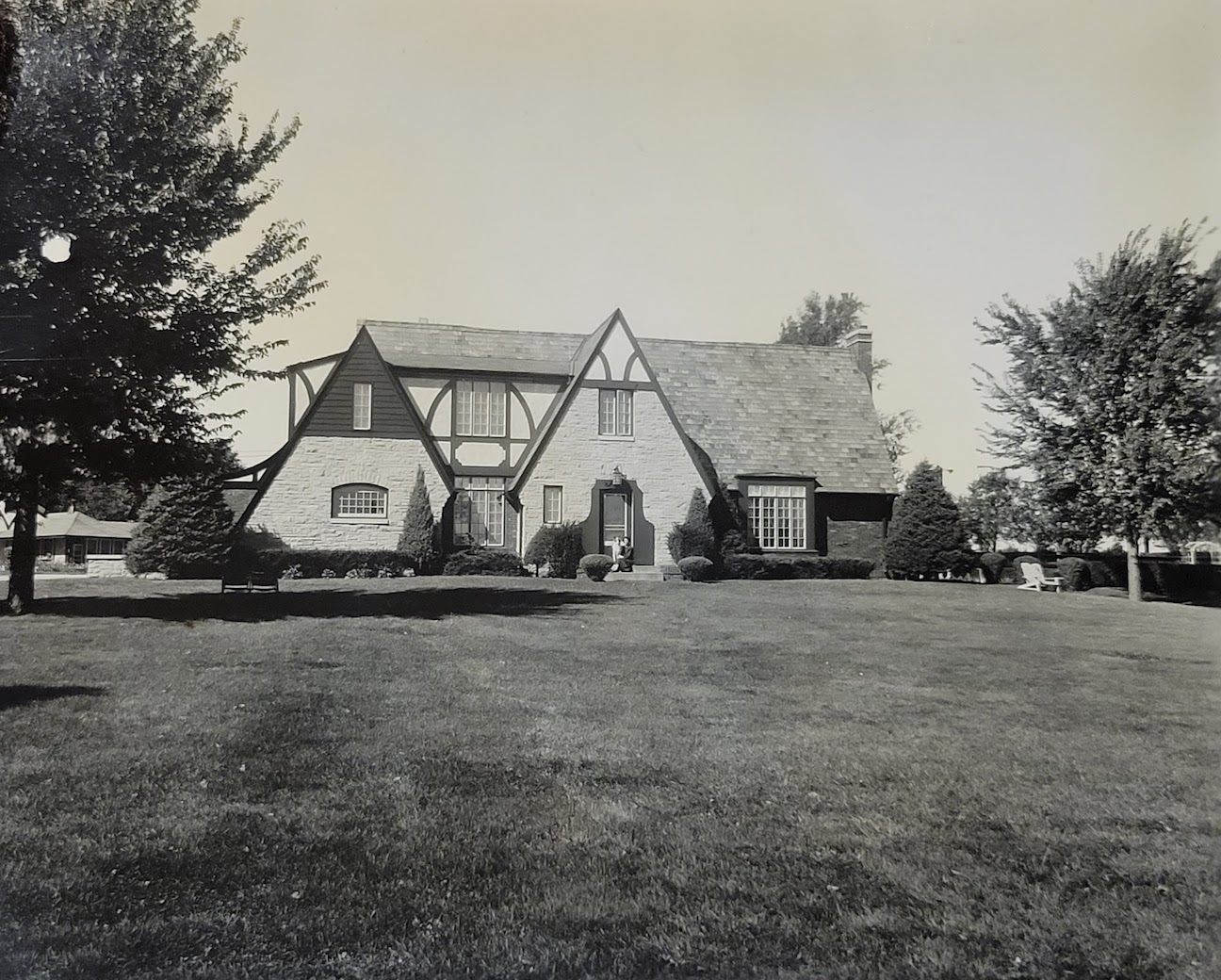
There it is. The old Tudor. Do you remember it? By the time I had taken notice of “the old 412 North 96thStreet,” she seemed so out of reach.
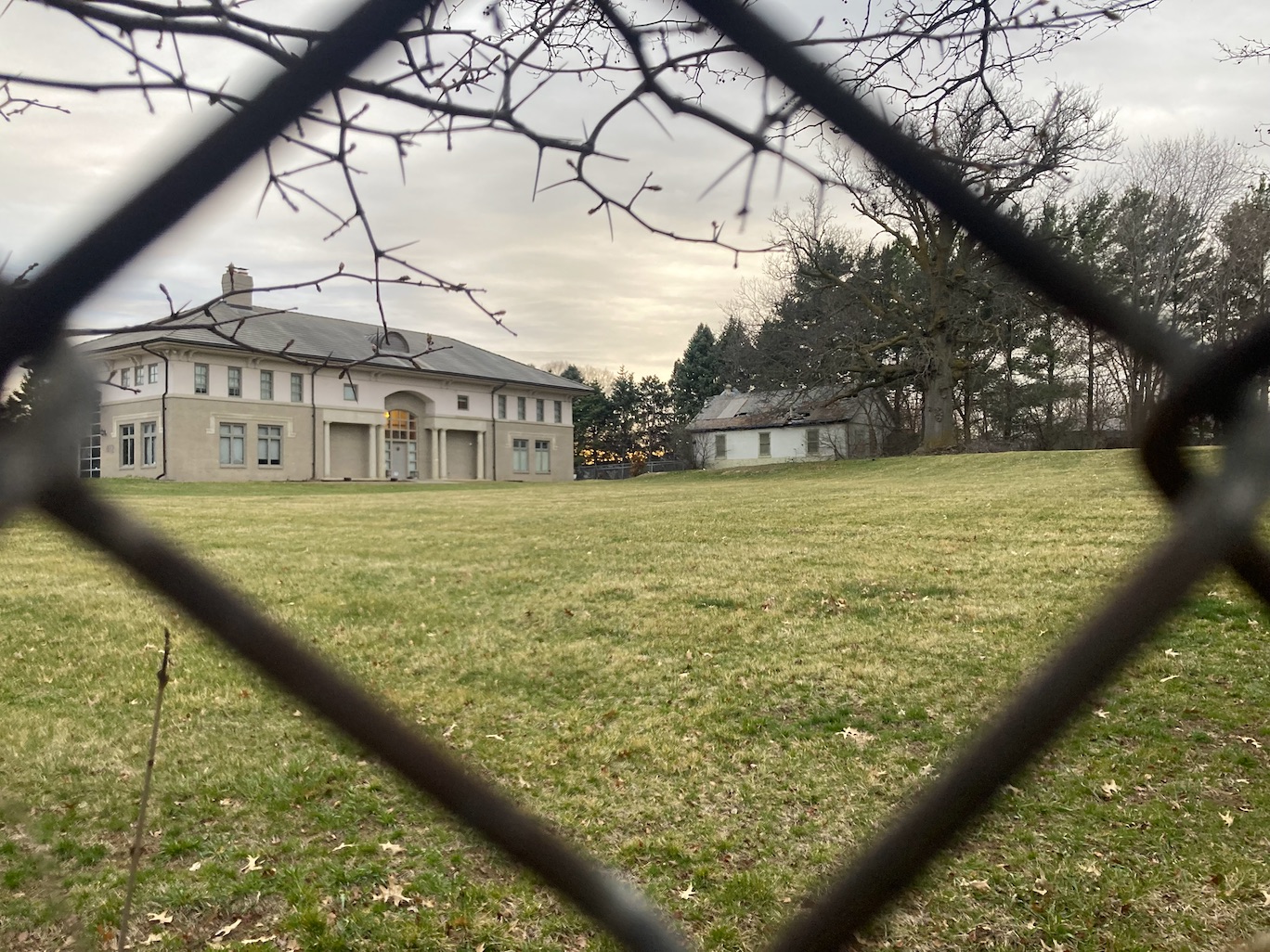
Full disclosure: I am obsessed with this property, its history of owners (every one of them a true enterprising maverick) and have been working this case since 2015. Every time I’ve sent out a public missive including various current photos of 412 North 96th Street encircled by the strange chain link fence, I receive a rash of hysteria and clue-filled mail. I’ve saved every last detail–the major changes in the 1990s and the unfathomable sale. This was an indulgence I shared with my dear friend, John Mountjoy. RIP. I only wish I could review this completed article with him now. Fortuitously, a few months ago I received word from a My Omaha Obsession reader, Effie Goodall, who had acquired a photo album marked “Greencrest at 96th and Dodge” at a Modest Lamb estate auction. Studying and savoring every black and white photograph, I knew immediately the Architecture Gods had intervened! Effie would have no way of knowing that I had been chiseling at this investigation for years and to that point, had no historic house photos to speak of. The property I had been trailing was given a moniker by the original owners…my dreams! I thank Effie Goodall and all who wrote in lending tips over the years.
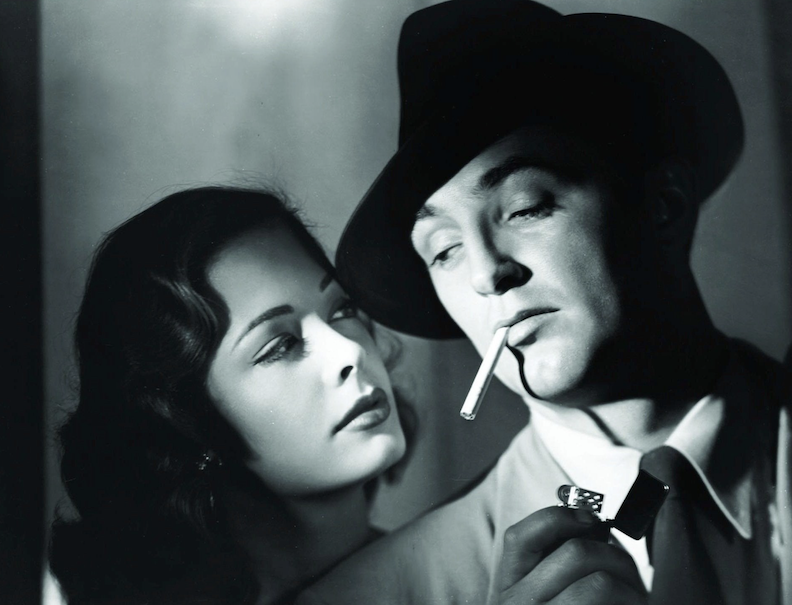
Miss Cassette is coming to you live from Omaha, Nebraska. Tonight’s broadcast is brought to you by king-size Viceroy Cigarettes. See for yourself how effectively irritants are trapped by the 20, 000 tiny filtering elements in this amazing new-type filter. Twice as many as the other two leading cigarette brands. Here’s the Secret! The Revolutionary New VICEROY HEALTH- GUARD FILTER Traps so Much Nicotine and Tars You Can Actually See the Results! Recommended by leading New York Doctors. Viceroy Cigarettes presents My Omaha Obsession: Mysteries of Omaha: 412 South 96th Street.
Ladies and gentlemen, the story you are about to read is true. In this episode, we gather round the agency office and study the timeline of 412 North 96th Street employing maps, archival photographs, genealogy, historic newspaper articles and good old fashioned amateur detective work. We are going to get dirty as we sift through the nitty gritty. Some of the names have been omitted for privacy reasons. Parts of the storyline have been omitted to protect the innocent or for privacy reasons. This will be a longform investigation. If you have no patience for our historic investigations, skip to the header: The Greencrest Album.
Buckle in, friends. We’re off to Greencrest Acres and beyond.
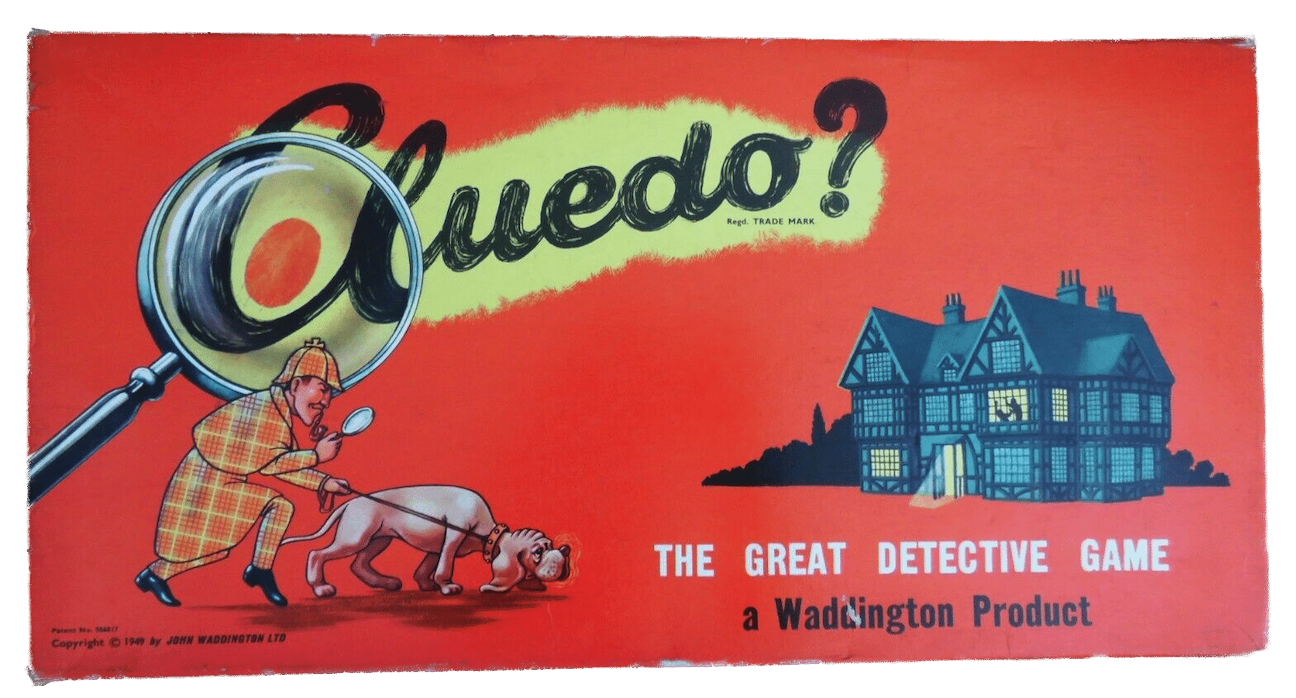
Part One
The North 96th and South 96th Puzzle
Let’s first address the North 96th Street -South 96th Street tangle. 412 North 96th Street sits on the southwestern corner of 96th and West Dodge Road. Because it is on the south side of West Dodge Road, one might think the address would have south in it. To complicate matters, several homes south of 412 North 96th Street are labeled North 96th but then down the street, the addresses make use of the South 96th Street labeling. This has led to much consternation over the years.
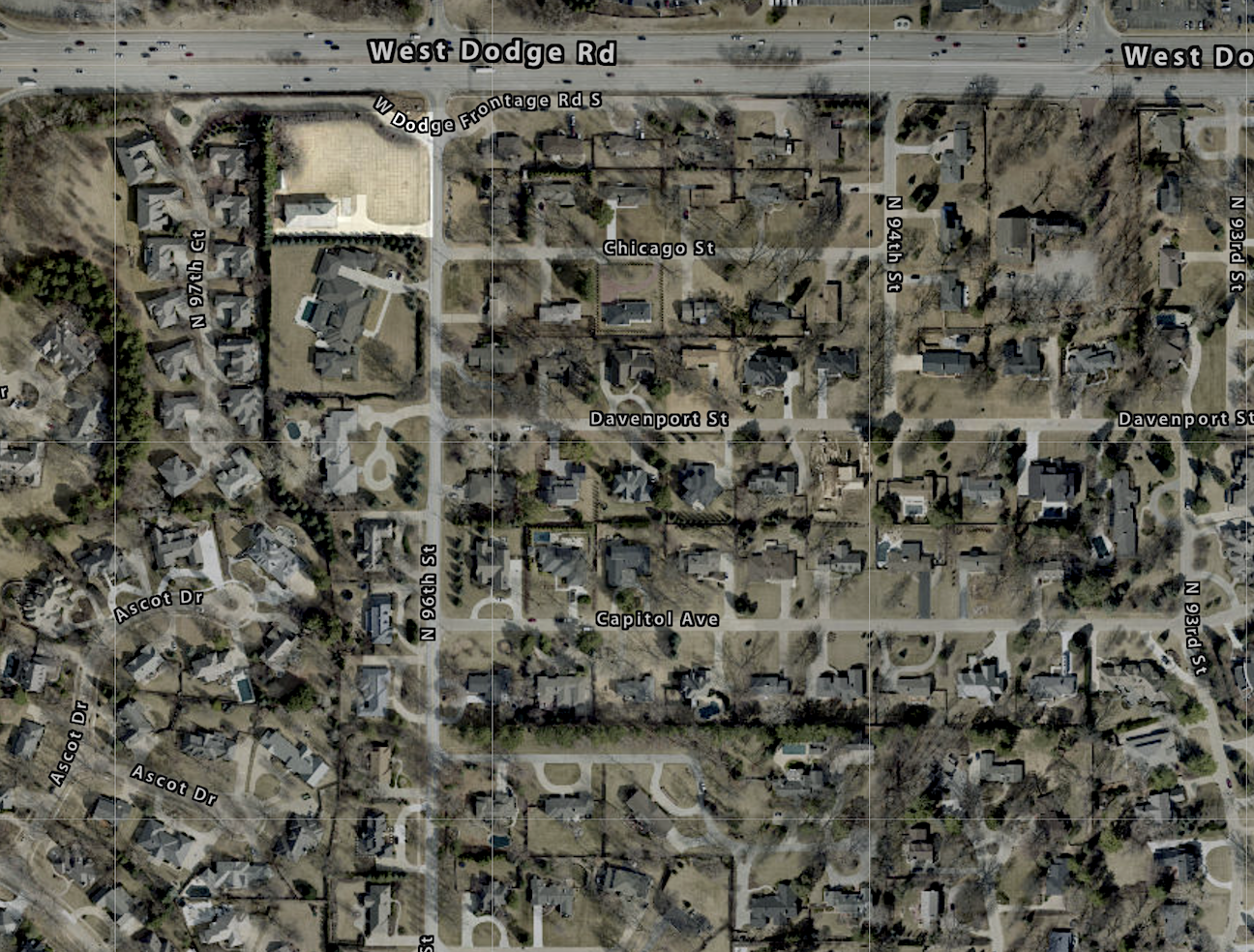
Current aerial. I highlighted 412 North 96th Street. Image borrowed from the DOGIS website.
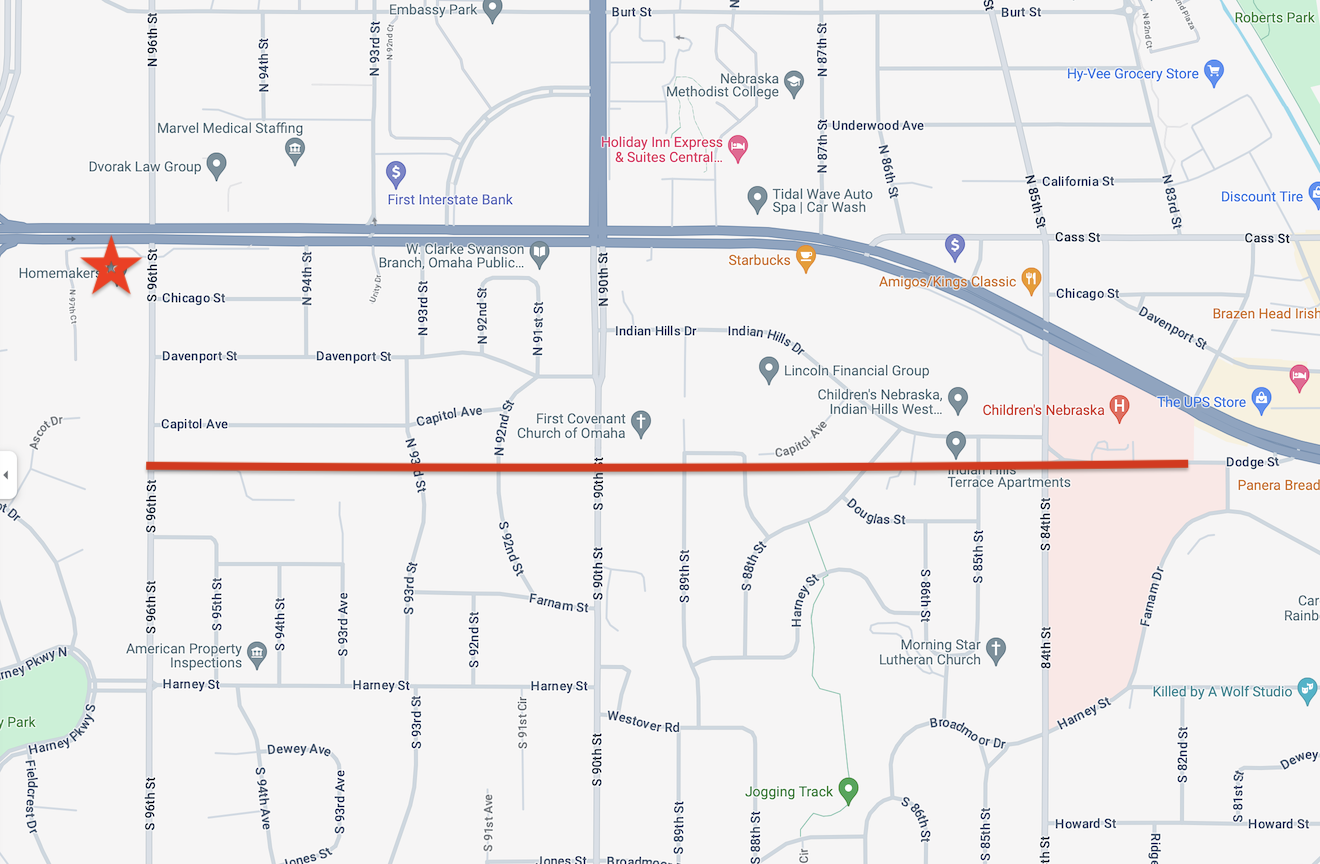
Red star marks 412 North 96th Street. Image borrowed from Google Map.
My suspicion is that this North-South 96th Street dilemma is based off the original Dodge Street proper and not West Dodge Road. Here is an aerial overview– Dodge Street proper begins downtown (not shown) and drops off near 78th Street. (West Dodge Road continues, curving northwest, merging with Cass Street.) The original Dodge Street continues up a hill between Children’s and Methodist hospitals and ends abruptly at 84th Street. I drew a red line to show where Dodge Street would progress to the west had it been allowed to continue. It lines up perfectly with Westchester Lane, a short neighborhood street, off of 96th Street. To the north on 96th Street is Capitol Avenue. The odd North addresses on 96th Street seem to follow this logic because the homes north of this Westchester Lane–Capitol Avenue are labeled North 96th Street. 318, 312, 226 and 216 all carry the North 96th Street. 106 South 96th is just one house south in the string of neighbors but more importantly, at that Capitol Avenue-Westchester intersection, it becomes its rightful South. I am open to thoughts. I realize I sound like a total street nerd.
Of other weirdness, West Dodge Road “becomes a controlled access freeway” at 96th Street, headed west to yonder regions and Elkhorn.
The Corner of 96th and West Dodge Road
I made an early decision not to go crazy with a deep, deep burrow into the original land and history of owners at the 412 North 96th Street site. That being said, we’ve got about 100 years to traverse. Part of my hesitation was its treacherous LANDS SECT 21 TOWN 15 RANGE 12 legal name–meaning that the 412 North 96th Street had never been part of a development or listed within a plat. Although I believe there was originally more than 1.6 acres in its parcel, I knew it would be a tricky thing to prove. For our purposes, I would like to travel back a few decades for review and gathering of our bearings. This home site was originally considered part of McArdle Township. I have weighed up McArdle in our past investigations and trust we are all up to speed on this district within Douglas County.
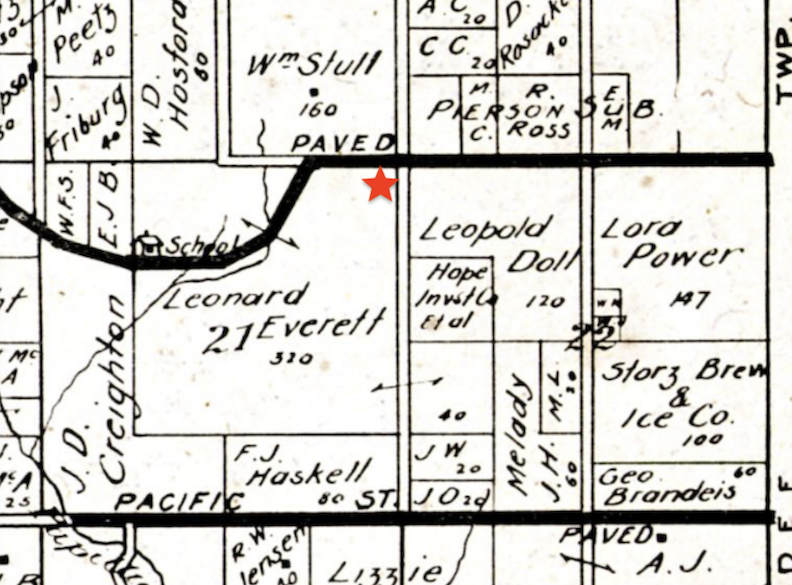
The McArdle Township map from 1925 found within the Plat Book of Douglas County, Nebraska displays that Leonard Everett owned 320 acres, as well as other adjoining acreages. This top north-eastern corner of his land (where the red star is placed) is where 412 North 96th Street would later be built. Everett’s land would much later become a portion of the Regency neighborhood, as we now know it. In 1925 this was rural countryside. Thick black line at the northern (top) part of the drawing is Dodge Street, now West Dodge Road. Southern-most thick black line (at the bottom) is Pacific Street. Both streets were paved in 1925. The doubled lined street running along the east of Leonard Everett’s land was 96th Street. Image borrowed from Plat Book of Douglas County, Nebraska 1925. Distributed through the Omaha Daily News. Historic Map Works Rare Historic Maps Collection.
Wealthy Council Bluffs attorney, Leonard Everett and his wife, Louise, seemingly spent all of their spare time buying up generous swaths of property in Omaha and McArdle Township, from my survey of their 1880-1920s land acquisitions. At the time of his death in 1938, Leonard was reputedly one of Iowa’s largest landowners as well. Months before his death, the Sears, Roebuck & Co. bought property for their new department store down at 30th and Farnam in 1938 from the Everetts. (This building was later transitioned into the Twin Towers Apartments.) Leonard’s father, Horace Everett had done well for himself. The elder Everett was also a lawyer and real estate dealer. The large Everett family home at 810 Second Avenue (sometimes reported as 812) in Council Bluffs, was built in 1865, had 18 grand rooms and reputed to have 12 fireplaces.
The Ideal Country Residence
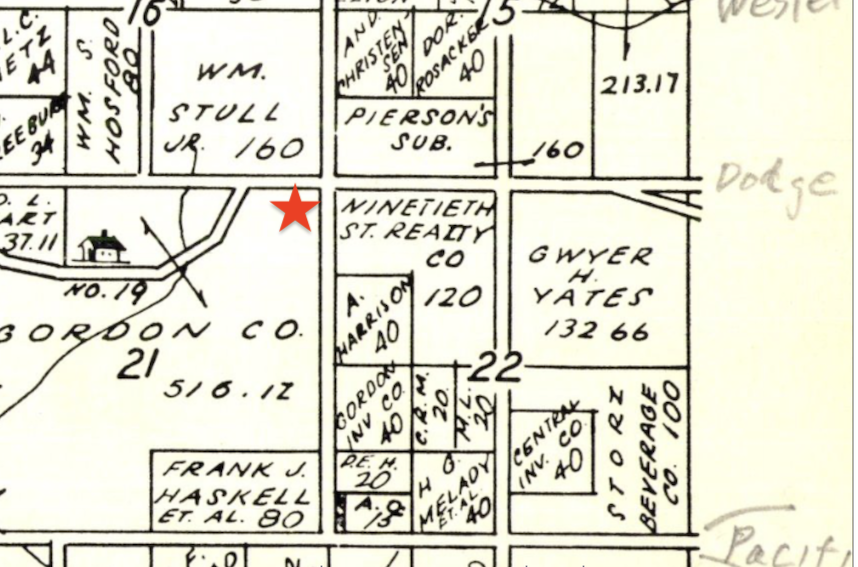
Image borrowed from Plat Book of Douglas County, Nebraska 1938. Distributed through the Omaha Daily News. Historic Map Works Rare Historic Maps Collection.
By the time the 1938 McArdle Township plat map was drawn up, the Gordon Company had amassed 516.12 acres, obviously having acquired the previous Leonard Everett holdings and more. The 412 North 96th Street home property (red star) did not yet exist, nor did any of the lovely, large houses in the immediate area. This was farmland. I would track the A. W. Gordon Company, incorporated in January of 1935. There was also a Gordon Oil Company, (later called Gordon Fuel) whose president was listed as the inverted W. A. Gordon. It was all rather confusing. Had we not already investigated the Alfred Wallace Gordon family, I would be pulling my hair out once again. By the 1920s Mr. Gordon had his sights set on establishing Omaha as The Medical Center of the Midwest. He was known for his work as one of the founders of Children’s Memorial Hospital, the Meyer Therapy Center, J. P. Lord School, Hattie B. Munroe Home and Clarkson Hospital. He was board chairman of the Omaha Loan and Building Association and director of the Herald Corporation, Fairmont Foods Company and the Omaha National Bank. A. W. and his wife, Almyra “Myra” Breckenridge Gordon would later sell this large McArdle landholding to Carl Renstrom and developer Jack Moritz, along with United of Omaha for the Regency neighborhood development. The Gordons then moved to large Busch family home at 701 South 96th Street, where they sat in judgement– abhorred by visions of the future posh Regency development.
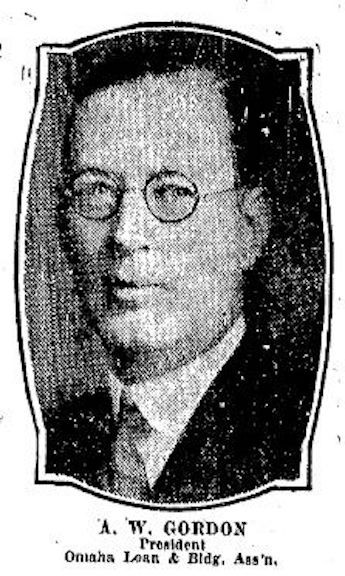
Alfred Wallace Gordon. World-Herald. 1931.
For more details of the Alfred Wallace Gordon family, check out my previous investigation: Mysteries of Omaha: Hidden House Part Five.
A Place in the Country
Walter and Esther Green bought the 96th and West Dodge Road lot in December of 1938 but this was long before the land carried a postal address. Still rural, this acreage went by the hazy north 335 ft of east 333 ft of LANDS SECT 21 TOWN 15 RANGE 12. As they were building their home, the original 412 North 96th Street, they named it Greencrest Acres. To anyone passing, it was probably called “That Huge Tudor on 96th and Dodge.”

The Evening World-Herald told of the real estate transaction. The Green couple bought the undeveloped property from F. C. Meyer.
Was this F. C. Meyer, the Undertaker, who we had found in an earlier case? Yes, it was the same F. C. Meyer. Meyer had been with the Duffy & Johnson undertaking firm but by 1934, W. C. Crosby and F. C. Meyer of the Crosby Mortuary, together had purchased the Moore Benson funeral home at 5424 Military Avenue. In the same year that Mr. Meyer sold the acreage to the Greens, he became name partner of the Crosby-Carlson-Meyer Mortuary at 3618 Farnam. My speculation is that Meyer had purchased the 96th and West Dodge Road land from the Gordon Company as an investment. Perhaps Gordon had parceled out lots on the perimeter at that time.
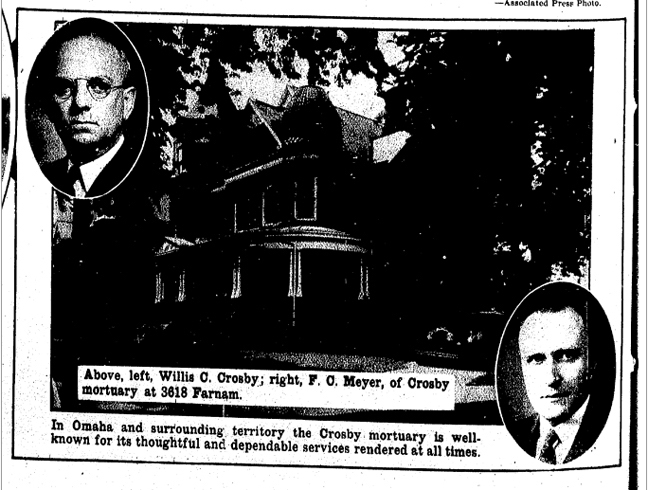
OWH. 1931. F. C. Meyer shown in the lower left hand corner. For more news of the F. C. Meyer outfit and building, please see my earlier investigation at: Passing Glimpse-3618 Farnam Street Part Two.
The undeveloped land along West Dodge Road between 87th and 98th Streets was sparsely dotted with single family dwellings. Many country estates were quite a drive off of the main road. Real estate advertising in this area during the late 1930s, illuminate wistful dreams of the past and hint at why so many moved west. I stirred up a little medley of them for you.
Suburban Home. The Ideal Country Residence, modern rooms in a rustic looking cottage, perfect condition in setting of shrubs, ornamental and fruit trees. Close in, but no city taxes. On the highway. Just the kind of an acreage home you have always wanted. A country home in a perfect setting, approached by a quiet road, set back among the beautiful fields is this appealing brick home, featuring a large hall and wrought iron stairwell, stepdown living room a beautiful fireplace, a grand modern kitchen, a breakfast nook. Two car attached garage. We invite you to inspect this gorgeous property. As fine a home everything considered that one could find. Out West Dodge way, choice location, beautiful grounds, highly landscaped. Every modern convenience, nothing left out. A kitchen that is the last word. Full maid quarters over two car attached garage. Knotty pine basement party room.
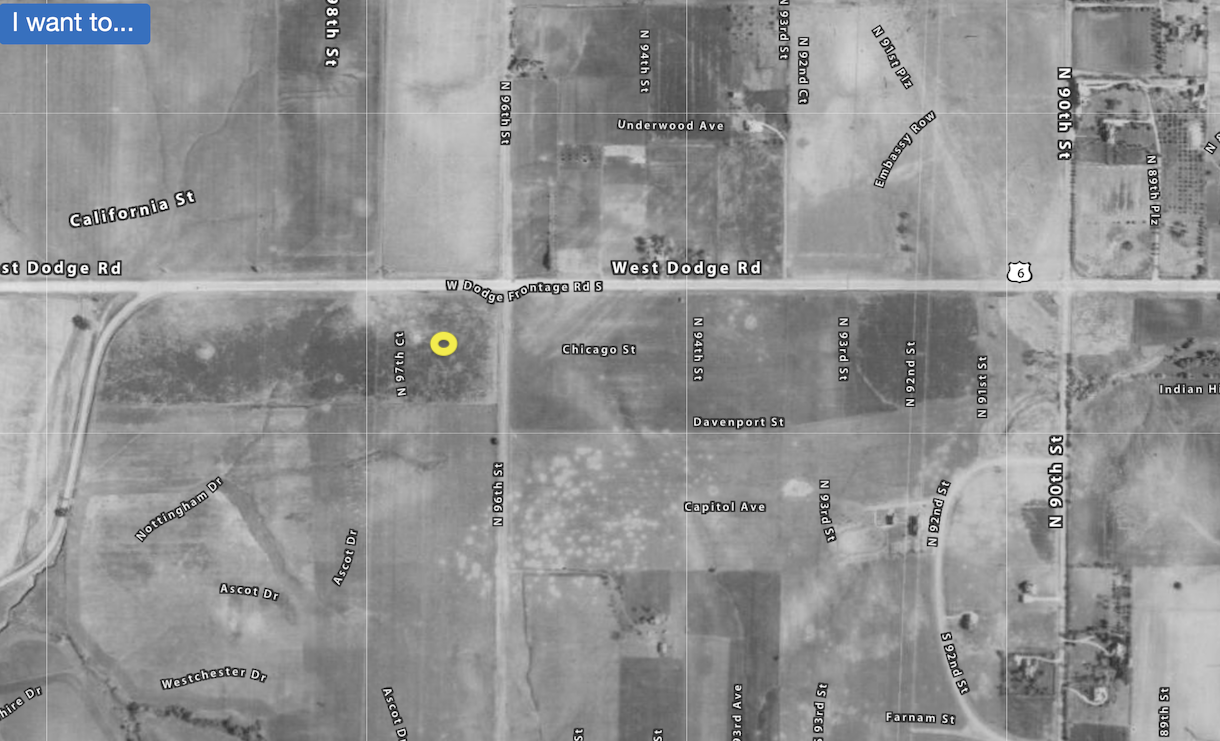
1938 aerial of the 96th and West Dodge Road area. Yellow circle signifies the Greens’ new property. I spy seven houses total. Photo borrowed from the DOGIS website.
Before we get settled into Greencrest Acres, let’s meet Walter and Esther Green.
Walter and Esther
Walter Malvern Green and Esther Boyer Green married in 1920 when Esther was 17 years old. Esther grew up in Council Bluffs, “the daughter of French and Irish parents. Her father, Charles Boyer, operated the Boyer Coal and Ice Company.” Diagnosed with polio at age six, Esther “had a successful fight with it.” She began drawing and painting, her creativity and talents developed during her years in a wheelchair. Later she worked for her father’s shop logging the trucks’ weight, when she was ten years old. Walter was born in 1898 in Shelby, Iowa. Apparently Walter and Esther met when Walter “offered to ride her home from school on his bicycle because it was so difficult for her to walk.”
Previous to marriage, Walter Green had served overseas with the Second Marines in World War I. There is also evidence that the Greens lived in Washington, D.C. early in their marriage.
In the spring of 1924, the Greens embarked on their printing business, which would rise to national fame. Their niche was in the field of moving pictures and entertainment. They established the firm Film Exhibitors Printing Company, later called FEPCO. The Film Exhibitors Printing Co printed motion picture promotional kits for theaters, often including posters, banners and handbills. With their Midwestern, central location, the Greens were able to get these kits sent out quickly all across the country. Esther Green was quoted as saying, “At one time Hollywood studios sold stock advertising materials. A movie house would show three pictures a week—one from Columbia, another from Fox and another from MGM. Mr. Green came up with the idea of printing personalized cards, with the theater’s name, town, dates of attraction. It was a much simpler and cheaper operation for theater owners. The small town was the backbone of the theater business.” The 1928 Omaha City Directory displayed Walter Green synonymous with Film Exhibitors Printing Company, but Esther, curiously, was listed as a clerk with the Metropolitan Utilities District. The couple lived in Council Bluffs in those early years. I would find a later article about Esther where she explained the MUD connection: “I worked to help get the capital. During the early days, I worked as a meter record clerk at the Metropolitan Utilities for nine years. We saved enough money to buy a second press.”
The Film Exhibitors Printing Company was located at the 303 Leflang Building. This suite of bays was previously leased to the Gatchell Studio. Emile M. F. Leflang’s building was at about 16th and Capitol Avenue, an area that has been completely reconfigured from the once proud, old downtown Omaha look. This Leflang building and its neighbors that used to line the streets are now gone because of the Hilton Hotel (now the Doubletree) fiasco, the Ed Zorinsky Federal Building and the cryptic First National Technology Solutions Data Center. Not only was the Greens’ operation from the Leflang in the heart center of the arts and theater community, but the building itself came into notoriety when the Leflang clan began fighting over it after Mr. Leflang’s death. During this time E. M. F. Leflang’s son sued his stepmother, Anna Cole Leflang, pronouncing she swindled this building, among others, from his rightful inheritance. Later the address of the Leflang building and particularly Film Exhibitors Printing Company suite changed to 221-223 North Sixteenth.
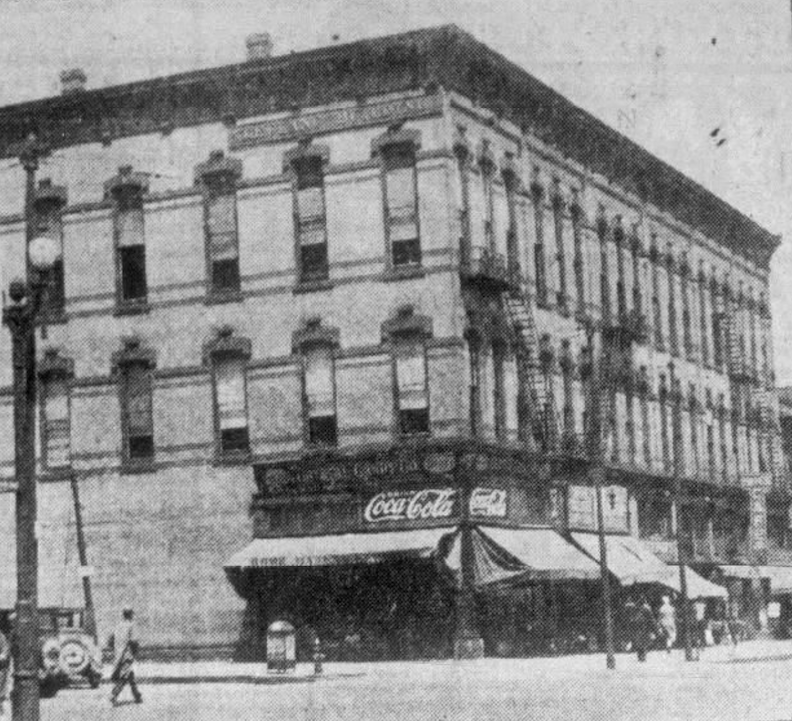
One of many Emile F. M. Leflang’s buildings. The Leflang was brought into court at the time The Film Exhibitors Printing Company was leasing from the Leflang estate. Image from the Omaha Bee.
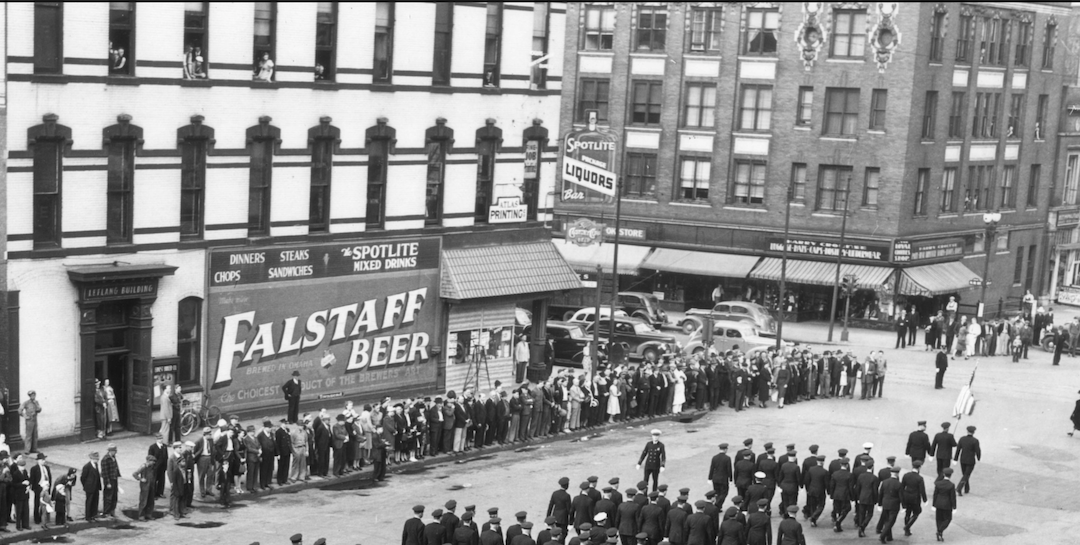
Here is how the Leflang building (white brick) looked in 1939. Police on parade at 16th and Capitol Ave heading east for the Golden Spike days. Photograph by Bostwick and Frohardt. From the Durham Museum collection. I love to look for the people in the upper windows. The Spotlite Bar reconfigured that corner bay to create a log cabin look.
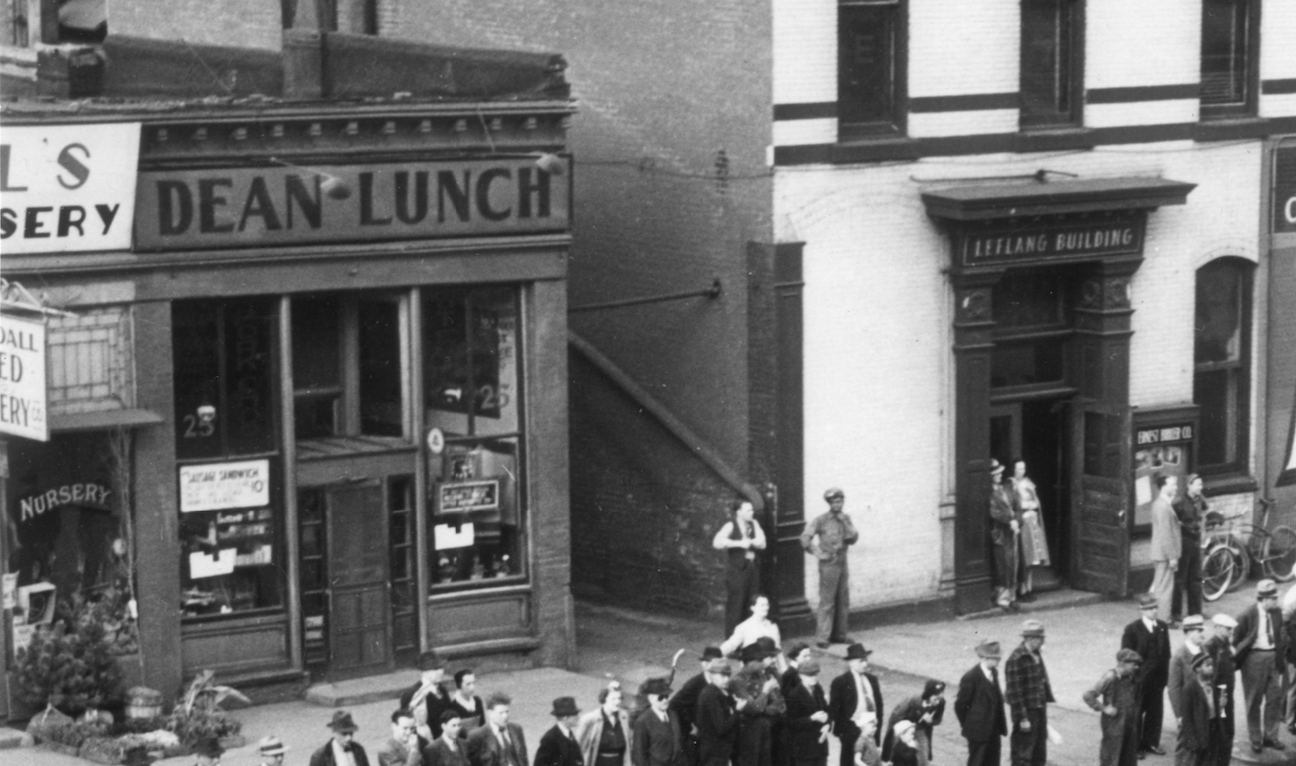
Detail of the above photo to show the “Leflang Building” name over the door, on the right. Great stuff. Police on parade at 16th and Capitol Ave heading east for the Golden Spike days. 1939 photograph by Bostwick and Frohardt. From the Durham Museum collection. Get a load of the incredible little diner next door, Dean Lunch.
5116 Parker Street
The Greens’ business was doing well and they decided to move to Omaha. The couple would find a pretty, little, storybook Tudor in the Country Club neighborhood at 5116 Parker Street. Within the National Register of Historic Places Registration for the Country Club Historic District compiled in 2004, I found the Walter M. Green house, built in 1929. The builder was listed as Harry Peterson. From the World-Herald I gathered that Peterson Company designed and began building the home in the fall of 1929; Peterson put his English Tudor on the market in March of 1930, selling to the Greens shortly after. This is my idea of a perfect home.

Historic 5116 Parker is a Harry Peterson home. A+ The Greens first Omaha home.
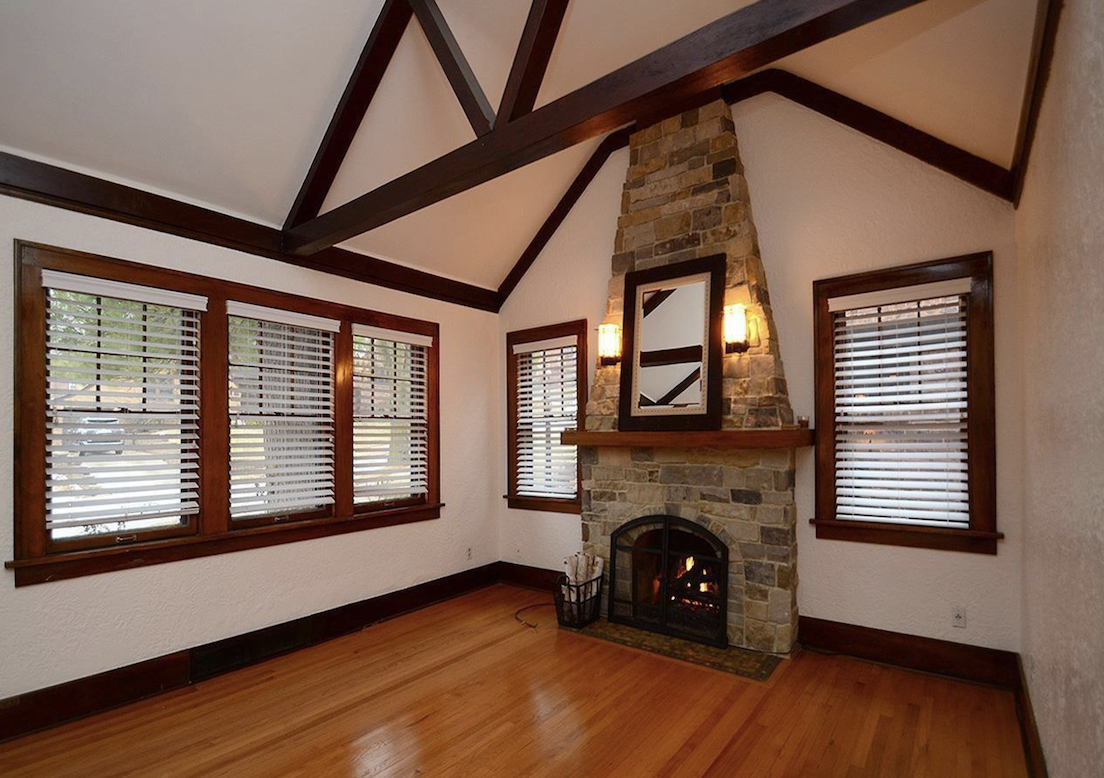
Living room of historic 5116 Parker. Divine.
April 23, 1930 OWH: “Mr and Mrs. Walter M. Green who recently moved into their new home at 5116 Parker Street, were honored Easter afternoon and evening at a housewarming party given by fourteen of their friends.”
FEPCO Clues
By at least 1933 the Greens began rebranding their printing business, FEPCO Theatre Advertising. This caused a bit of difficulty at the library but Detective Librarian Martha Grenzeback and I figured it out. Concurrently Walter Green began calling himself an advertising director instead of a printing press man. There were so many grand motion picture theaters and neighborhood theaters in Omaha at that time. Although America was in the Great Depression, theater owners and Hollywood had to make adjustments with the times, and escaping to the Picture Palaces was considered a popular, inexpensive joy. Hollywood and the film industry, to include secondary companies, such as The Film Exhibitors Printing Company, were largely successful throughout the Great Depression.
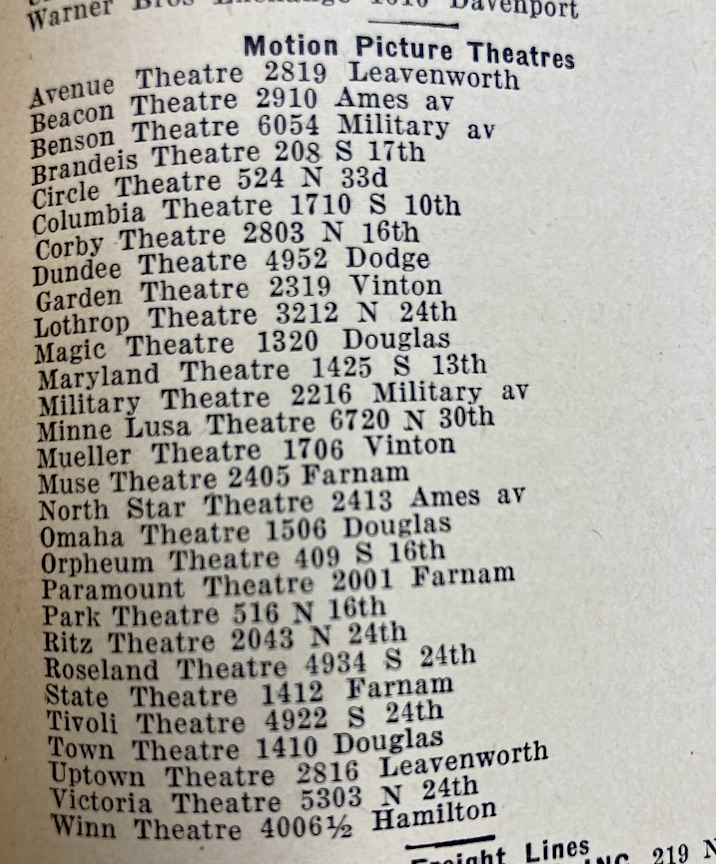
1935 Omaha City Directory list of movie houses.
In accumulating everything I could about Walter and Esther Green, I would come across local Kelli Bello’s article focused on Esther Green and FEPCO. While Bello and shop owner Larry Richling moved Richling’s collection of vintage letterpress blocks, printing presses, film equipment, and Hollywood press kits in order to build a new print shop in Council Bluffs, Bello repeatedly came across the FEPCO name. As the production manager of the Firehouse Letterpress, Bello dug in and took the opportunity to experience first-hand the extensive historic, FEPCO output. From Bello’s research: “FEPCO produced ‘movie papers,’ which contained everything a theater needed to successfully promote a film release. After a theater booked a film for screening, Hollywood studios would issue them a press kit. In the kit was the cast list, plot synopsis, photo stills, and a plethora of poster themes and sizes that could be ordered. The regional or small-town theaters typically received their press kits from a middleman, not the studios, and this is where FEPCO made its mark. At the height of its business in the 1950s, FEPCO was serving over 4,000 small towns, and had clients in all 50 states and Canada.”
To read Kelli Bello’s article on the Douglas County Historical Society website, check out: The Dynamic Life of Esther L. Boyer Green Humphrey.
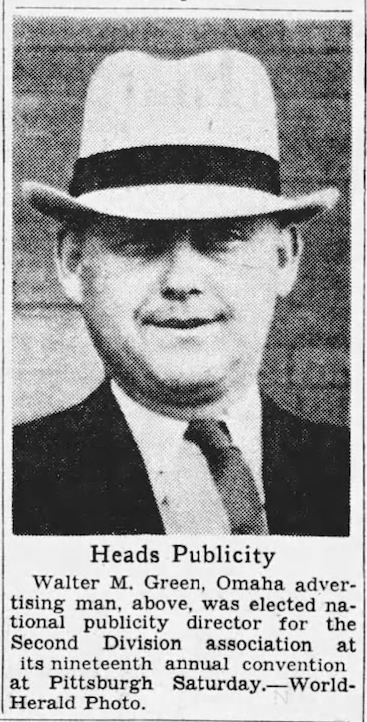

A brief World-Herald 1937 article about Walter Green. FEPCO advertisement I found at the Omaha Public library in a 1930s film industry trades magazines.
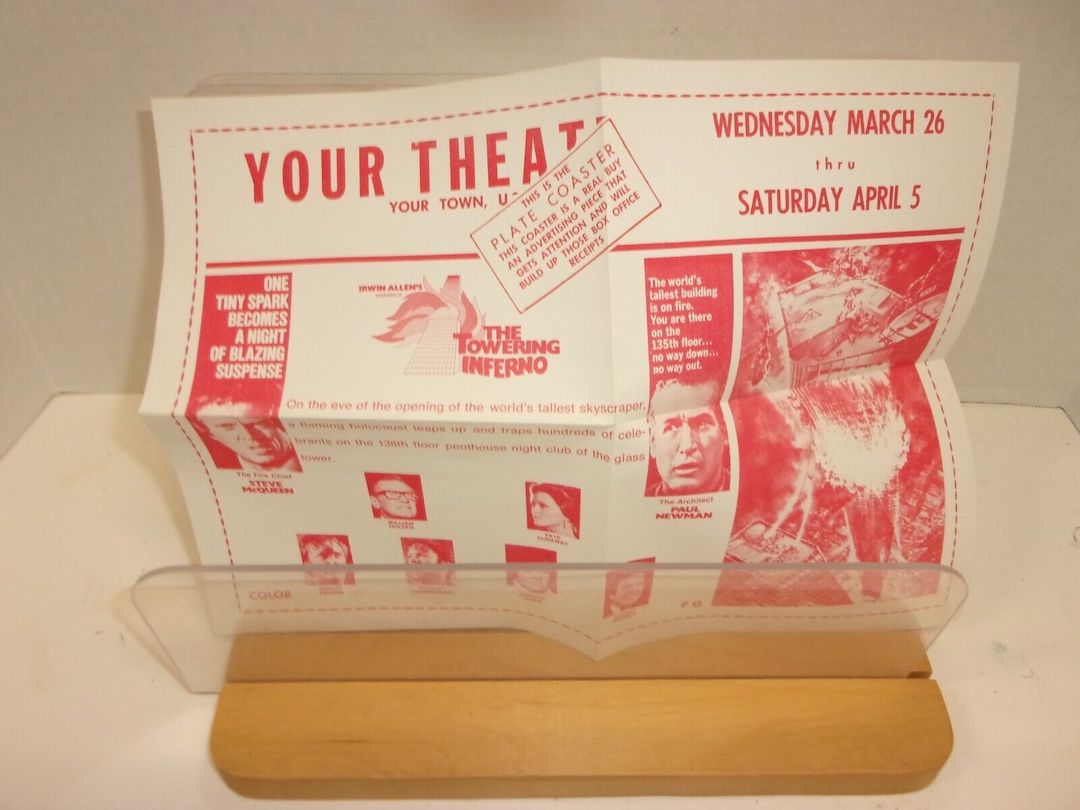
This FEPCO example is from the business’ later years. FEPCO Theatre Advertisers, Omaha, Nebraska. Theatre Window Cards, Programs, Heralds. Image from Ebay.

Advertising accessories of distinction from the Center of the Nation. Again a much later advertisement for FEPCO but still amazing. There’s Esther L. Green show in the center of the United States. Image borrowed from Ebay.
With FEPCO fully on its feet and enjoying good success, I was interested to find that Esther Green stepped away from the business. I had read in a 1962 article where Esther summarized her fear of recurrence of polio up until 1934. She had taken up swimming to strengthen herself, apparently encouraged by her Country Club neighbors who frequently swam at Krug Park. She would build herself up and would later enter swimming marathons and diving contests. Coinciding with this time period, I began to find boundless announcements of Esther Boyer Green’s socializing in Omaha. Let us say, she entertained enthusiastically. Luncheons, card clubs, dances at home, dances at others’ homes and at the right hotels. Put this in your pocket–of note, a Mrs. Harry Humphrey was often there alongside her galpal, Esther Green. The Aquila Tea Room. The Greens became members of the Happy Hollow Club in this time period and were mingling with Omaha Society. There were cocktail parties preceding the Blackstone Hotel dancing club. Hostess suppers and bridge-dinners. Esther even gave a ladies’ talk on William Butler Yeats and other authors at the Happy Hollow Club in 1937.
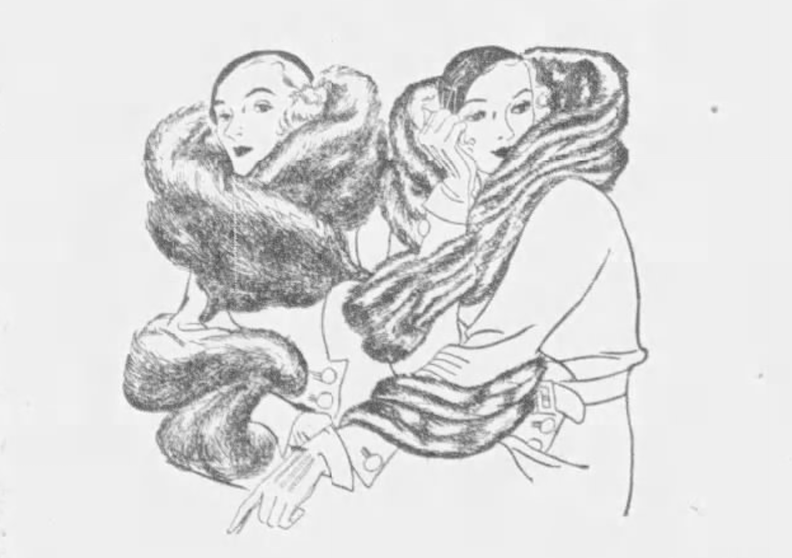
Great 1930s illustration for the Aquila Tea Room at the Aquila Court Building. 1615 Howard Street. Where the elite sipped tea and judged others’ bias cut dresses. Sidenote of interest: Effie Goodall, who shared her photographs of the Walter Green home with me, is of the Winkelmann family. Her grandfather was Fred Winkelmann, once owner of the Aquila Court building.
For more details of Aquila Court, look into my articles: My Obsession with Frank Salontay and I Wish I Could Have Gone To: The Cave Under the Hill.
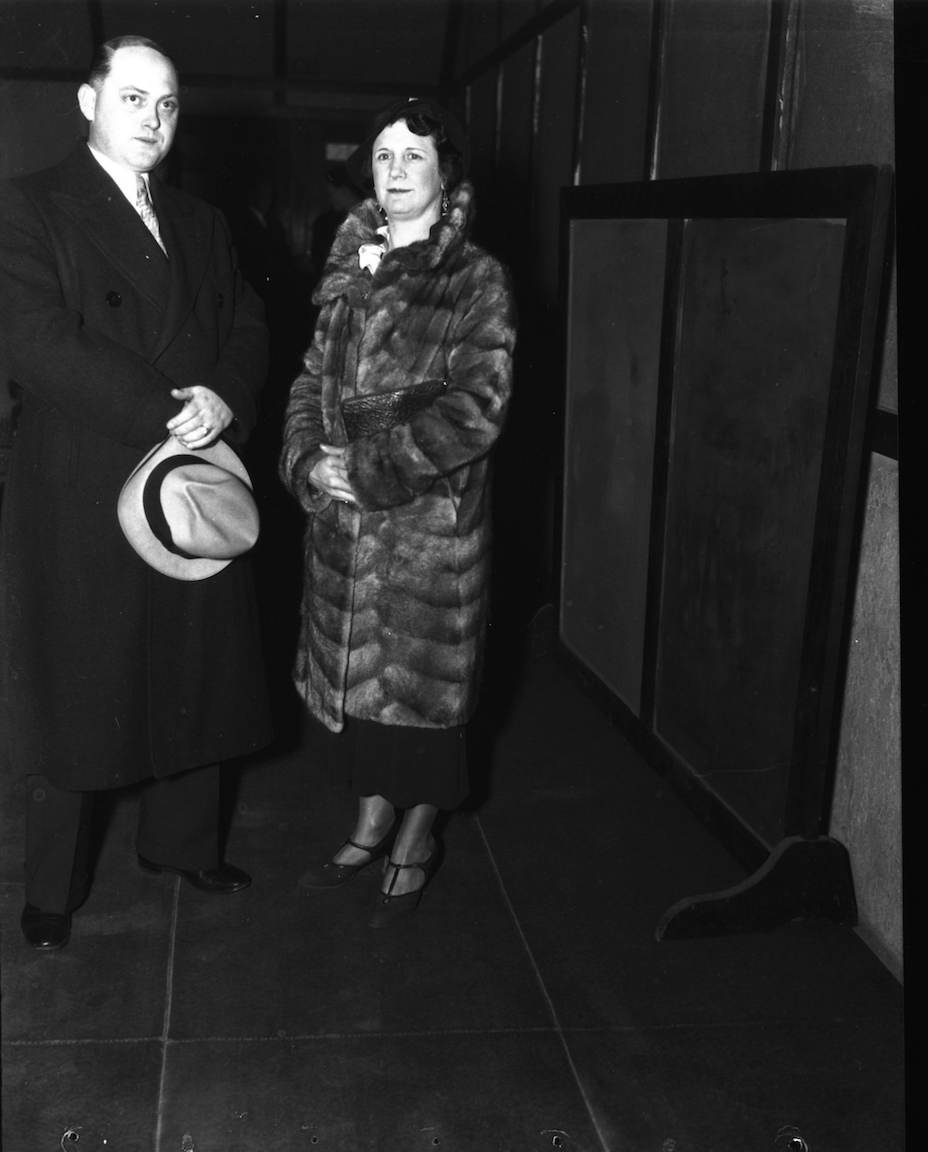
And here they are now– Mr. and Mrs. Walter Green at the Community Playhouse on opening night. Creator: Savage, John. Publisher: the Durham Museum. Date: 1935.

Here’s another one of Walter Green, Edward Schimmel with his arm around an unidentified woman standing in a hotel hallway. Possibly the Blackstone Hotel? Photographer, John Savage. The Durham Museum. For more on Edward Schimmel and family, check out: Schimmel’s Indian Hills Inn.
A Country Estate
I’ve written at length in our past investigations about the draw of the countryside, just beyond Omaha, for the wealthy few of a certain time period. This would later become suburban Omaha. Perhaps looking for more privacy and space—a lot more space, as it turns out, the Greens set their sights on the southwest corner of 96th and Dodge Road, or Highway 30. It would be years until the home received a proper postal address. Out West Dodge Way. A Society calling card? Closer to Happy Hollow Club? No city taxes? The idea of having a large acreage? The quiet? Being able to build their own home? It all sounded glorious to me.
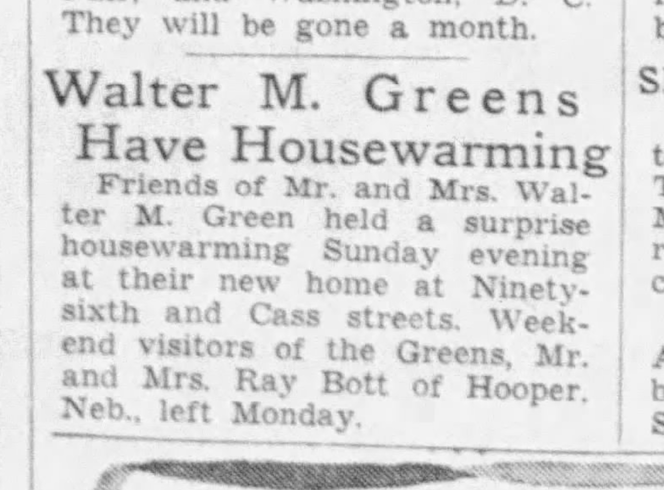
In June of 1939 Walter and Esther Greens sold 5116 Parker to N. L. Sholin. Shortly after, the Evening World-Herald brought the news of a June of 1939 housewarming for “96th and Cass.” Off a street or so, it only winked to the days of vague country living. Not long after, the Greens would name their property Greencrest Acres. Differing reports say that they were both 39 years old when they moved in. I suspect they were a few years older.
Upon completion of their Tudor, Walter and his wife Esther’s new home began to serve as the centerpiece of their private parties in the Omaha entertainment community. Very often Hollywood celebrities and the Omaha arts and business people intermingled at this home. Although I cannot say with absolute authority, I wager the Harry Peterson Company designed and built the 96th and Dodge Road home for the Greens. As much as I clawed through the records, it certainly was not a celebrated architect.
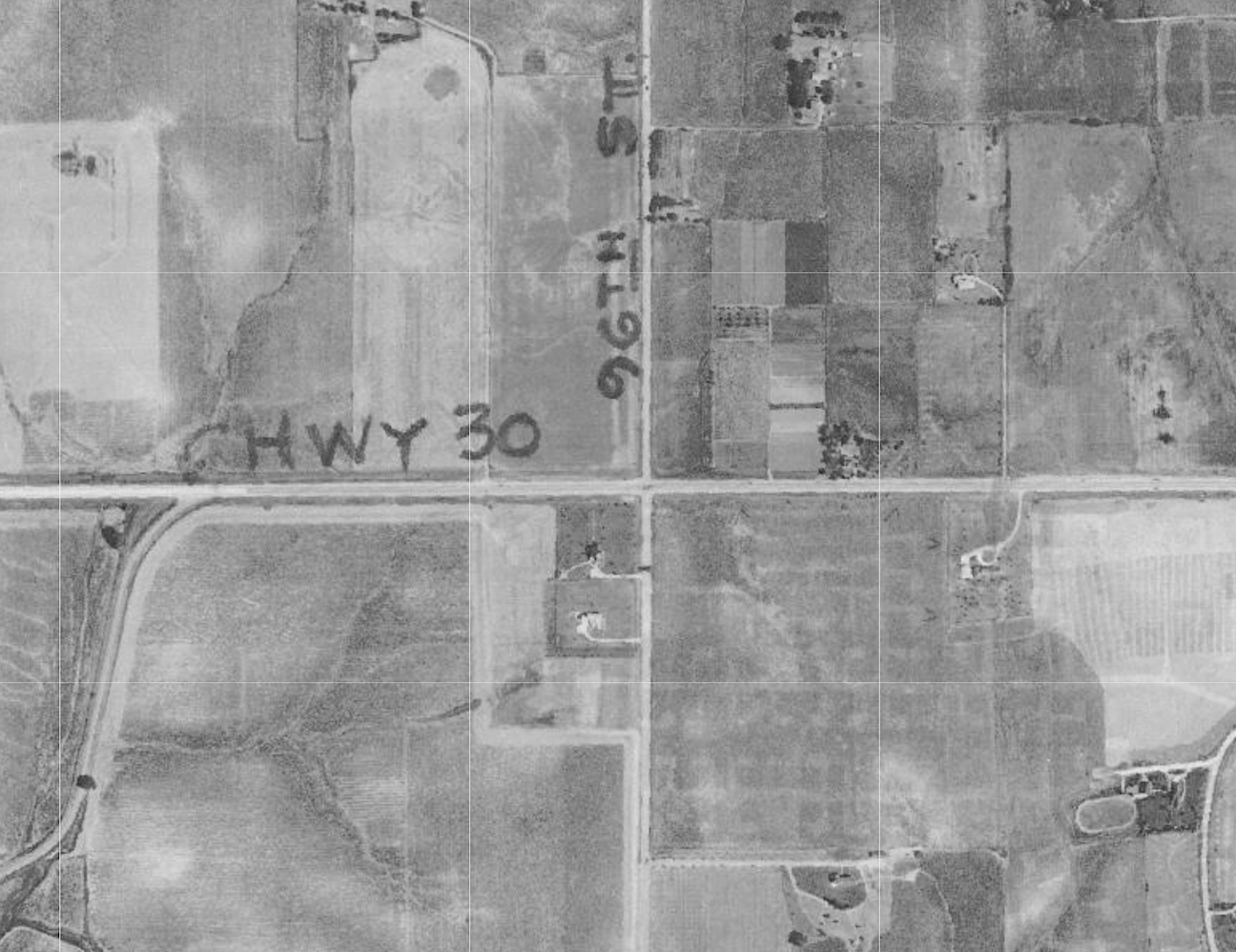
1941 aerial of 96th and Dodge. Another new home is seen directly to the Green’s south. Image borrowed from DOGIS.
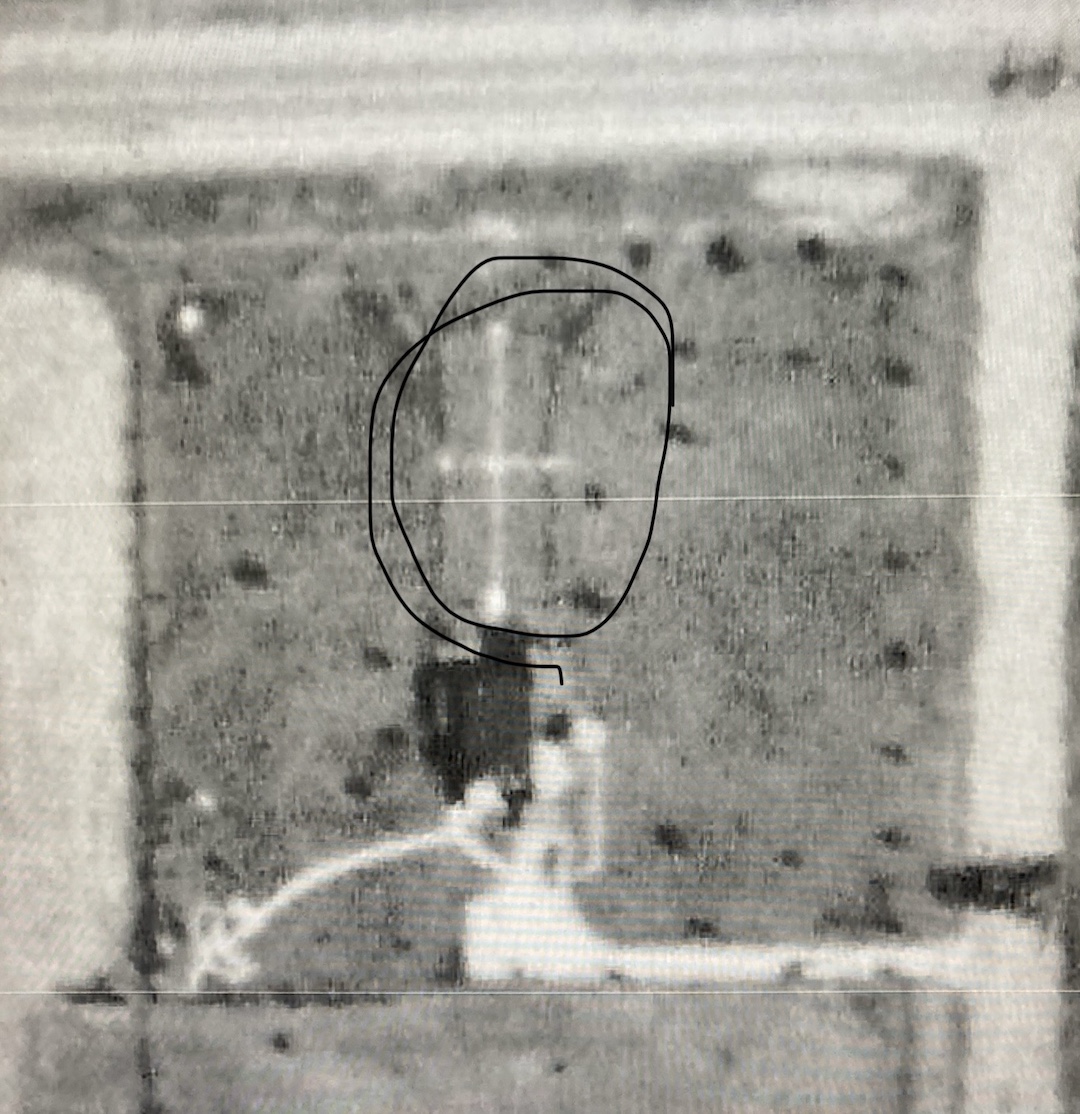
If this aerial gives hints, the home was established central to the parcel, front elevation oriented to 96th Street. The drive entered alongside the home to the south. Series of paths in the southwestern corner. There was some kind of formal garden courtyard to the north of the house, in a private, elongated walk. It looked like a perfect, quiet setting, apart from the highway. It tells that the grounds were landscaped with shrubs and ornamental trees. **Photos to follow.
It was a large, handsome, two-story stone, klinker brick and timber clad Tudor. Let’s study Effie Goodall’s incredible photographs that she so generously shared with us from an album marked “Greencrest at 96th and Dodge.”
The Greencrest Album

This is delightful. I have only seen two other albums of this style and this one is the most adorable. Well to do families would hire a local photographer, many time Louis R. Bostwick (1868 – 1943) to capture their homes when first built. Bostwick would take beautiful, clear photos, exteriors and interiors and then the black and whites were arranged in an album with a personalized cover. I am willing to put money on Esther Green having illustrated this darling cover.
Effie Goodall asked the auction company, Modest Lamb, where the Greencrest album had come from. The company said that the album came from an estate in Blair. It sounded like there was a lot of ephemera there but he didn’t know how they had come across the Green-Humphrey things.
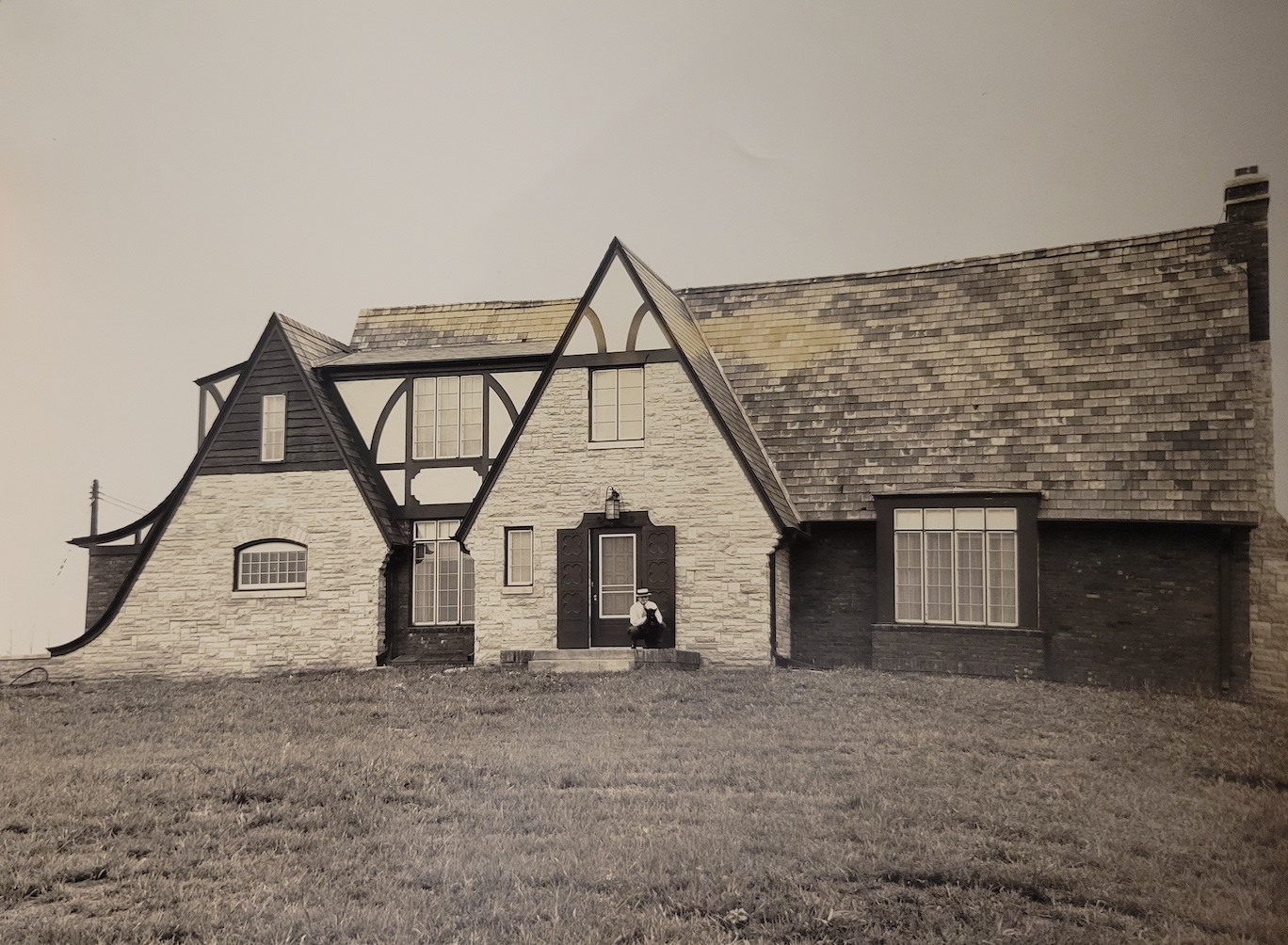
Front elevation. That is Walter Green with a dog on the front porch. Camera facing west. This is the view from 96th Street. The southern most front facing gable is a discreet two car garage. I am intrigued by the entry door English lantern and with wooden shutters flanking the front door with simple styled quatrefoil cut-out medallions. The home had a stripped down genteel charm–a Midwestern practicality. It was quiet but still lots to take in.
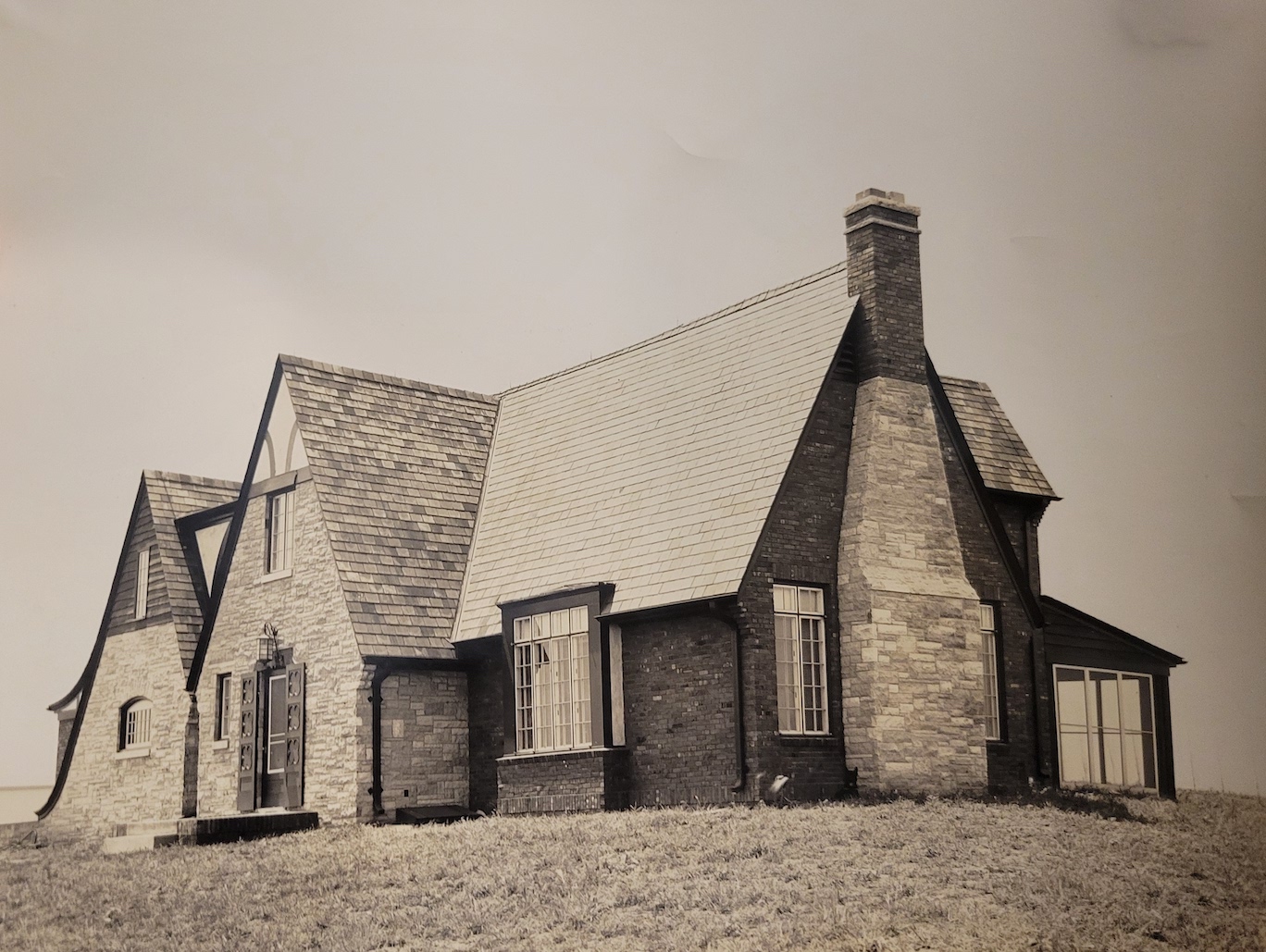
Camera faces southwest angle.
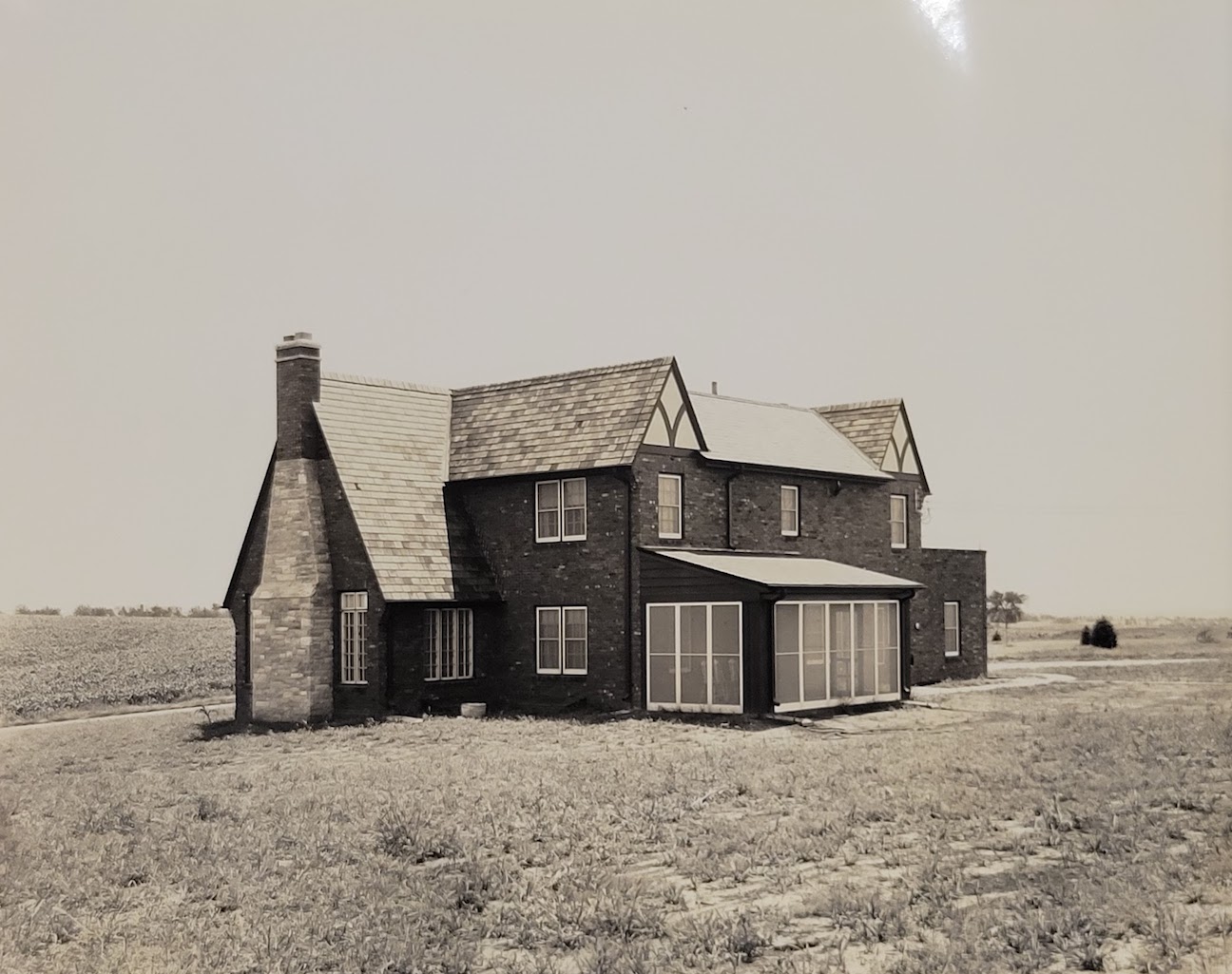
Camera is at the rear of the house, facing southeast, toward 96th Street. Across 96th Street is a country field.
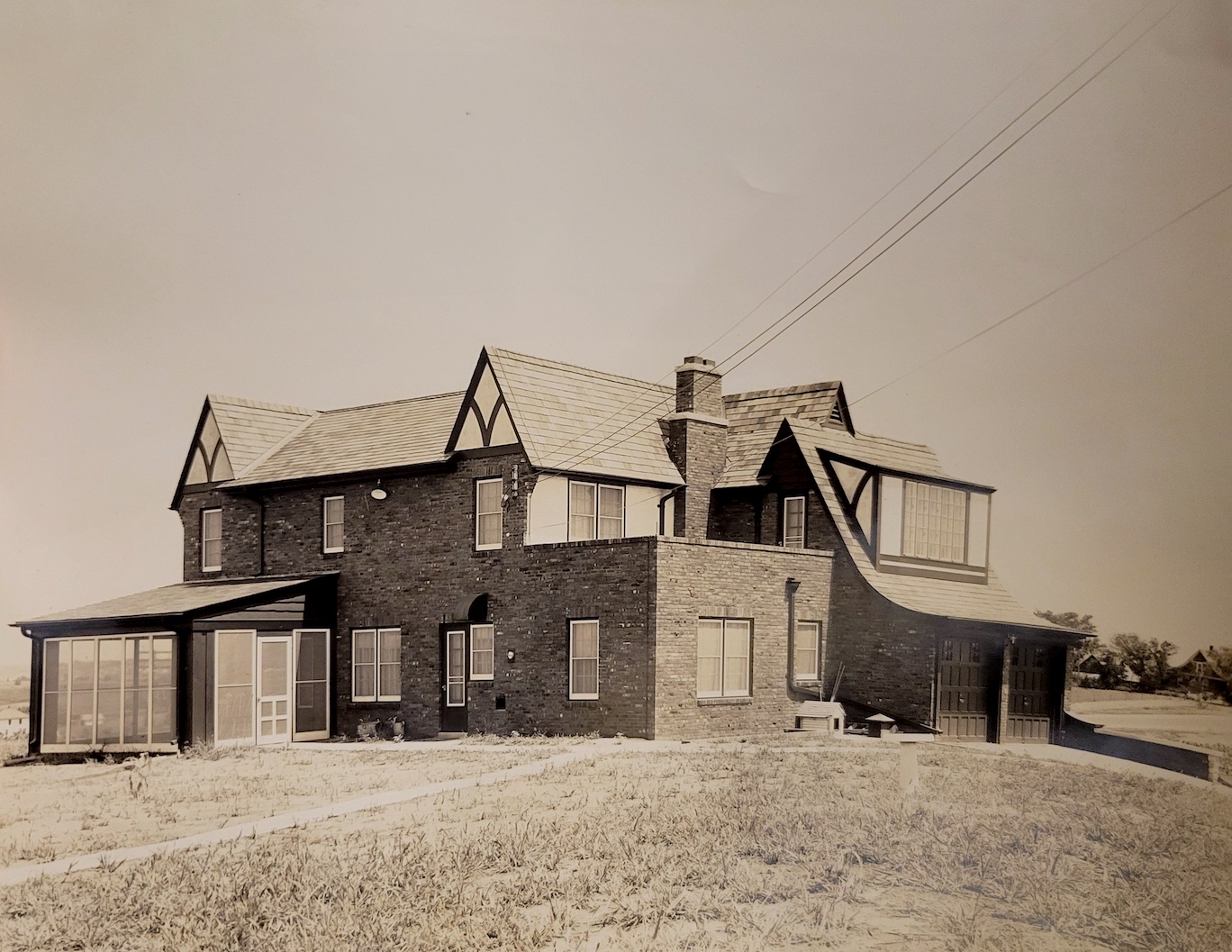
Rear elevation. Camera faces north east angle. Screened in back sunroom. Oddly I found phrasing of this sunporch as a “pre-war steakhouse.” I wondered if that was a spin on the Bar-B-Que house that we’ve covered in the past or if it meant something else. The Greens were not running a country restaurant out of this location. Two car garage nestles into the southern elevation. I’ve spied two large chimneys so far. If you look off to the east you can see other properties. to the north beyond the screened porch is a farm house. This square room with the flat roof on the southern side was the servant’s quarters. From the 1940 U. S. Census I could see that domestic servant, Madonna Carroll, age 22, lived with the couple. Although I had dreamed a man named Caruthers handled their automobiles or polished the silver, I am sure the Greens were more than satisfied with Madonna. Madonna Carroll Matthies would go on to marry and have children. She died in 2011 at the wondrous age of 95. I bet she had many stories about her time with the Greens and the famous folks who once gathered here.

Not the typical Tudor interior, is it?
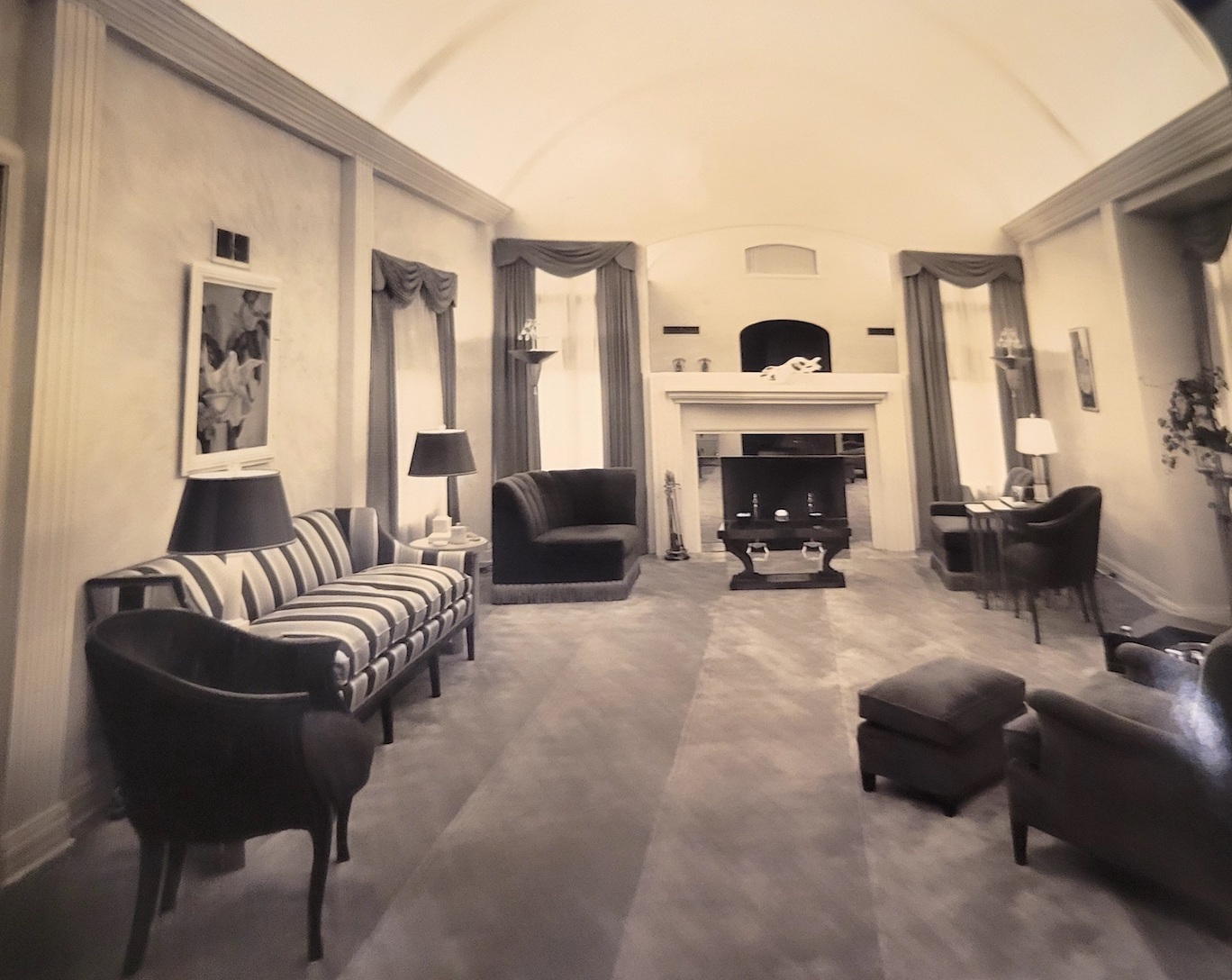
Nicely proportioned and sumptuously appointed entertaining spaces included a double height, barreled living room with an art deco fireplace.

Esther Green at her organ in the living room.


The hall offered an art deco style curved staircase and a white wrought iron rail. Was that inlaid linoleum or lowpile carpeting with a design? I am thinking carpet by the ruffled edge I see along the stairwell. In fact, it was all very art deco. The exterior suggested the English country estate but the interior was all city. Like a movie set!

Inlaid linoleum featured double edging strips and insets with a great central medallion of sorts.
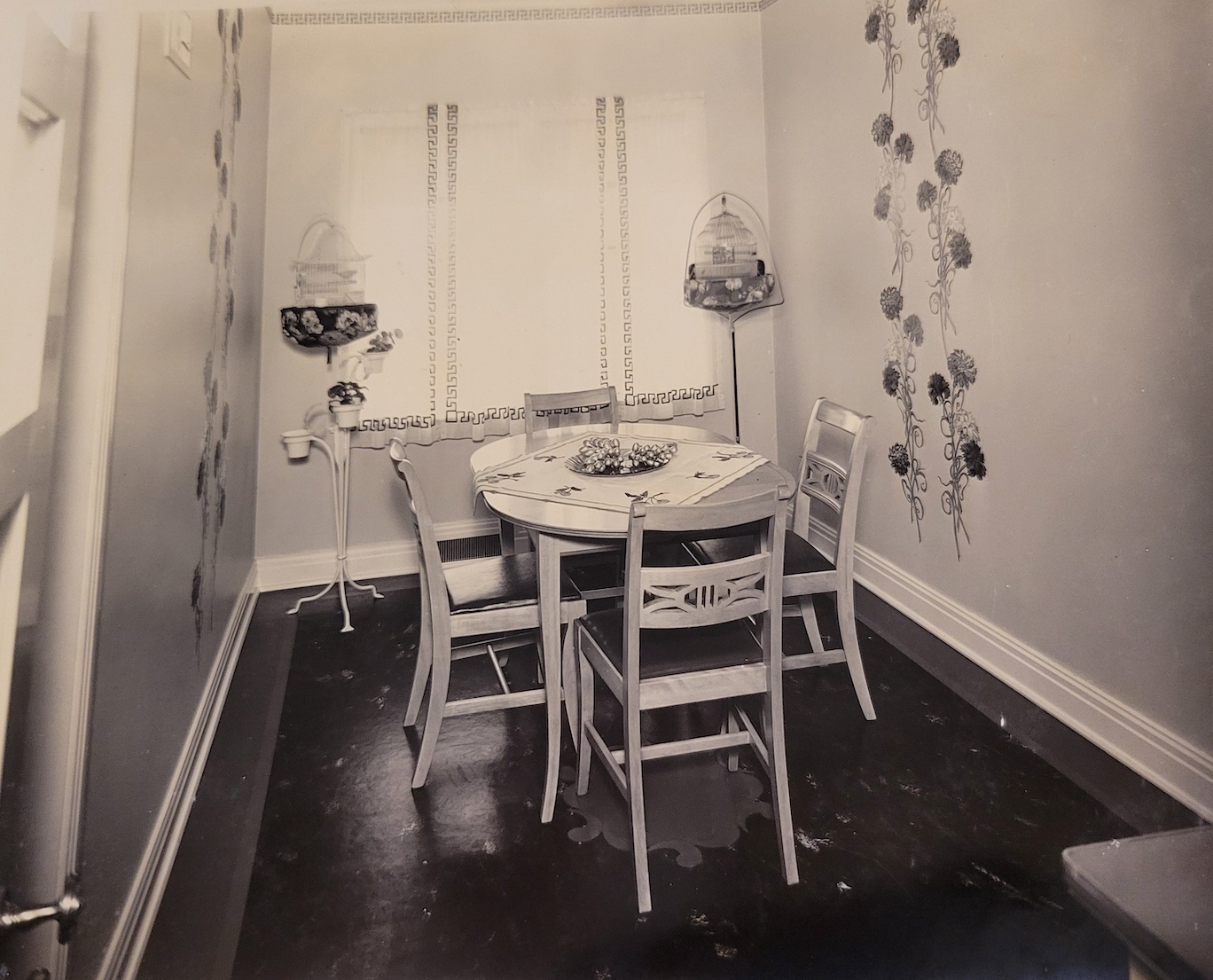
Repeat of the flooring in the breakfast nook.

An office.

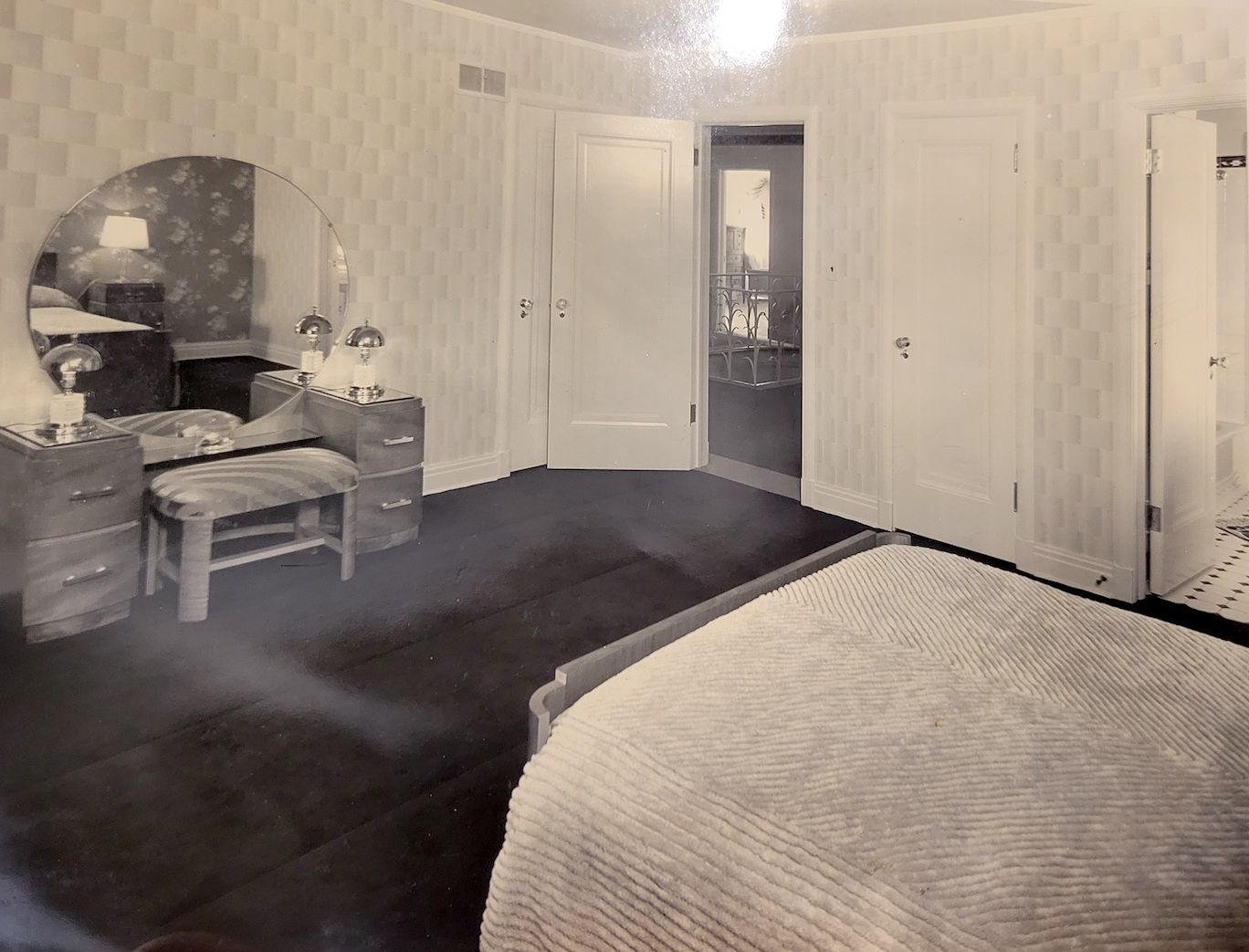
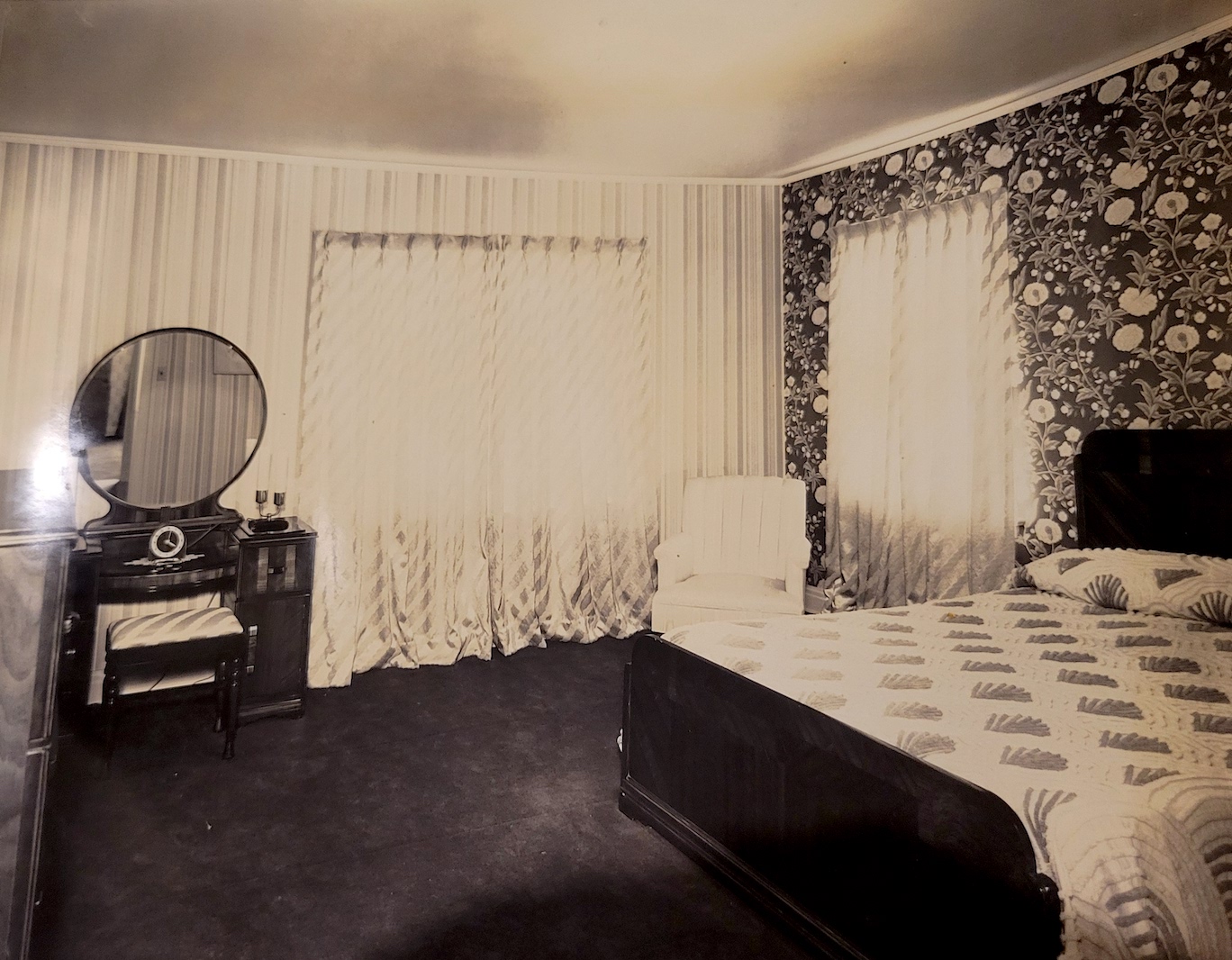

As I savored over Effie’s photos, I found a master suite, bedrooms, bathrooms. Although I didn’t see the photographic proof, I had heard there were separate staff quarters in the rear of the house.
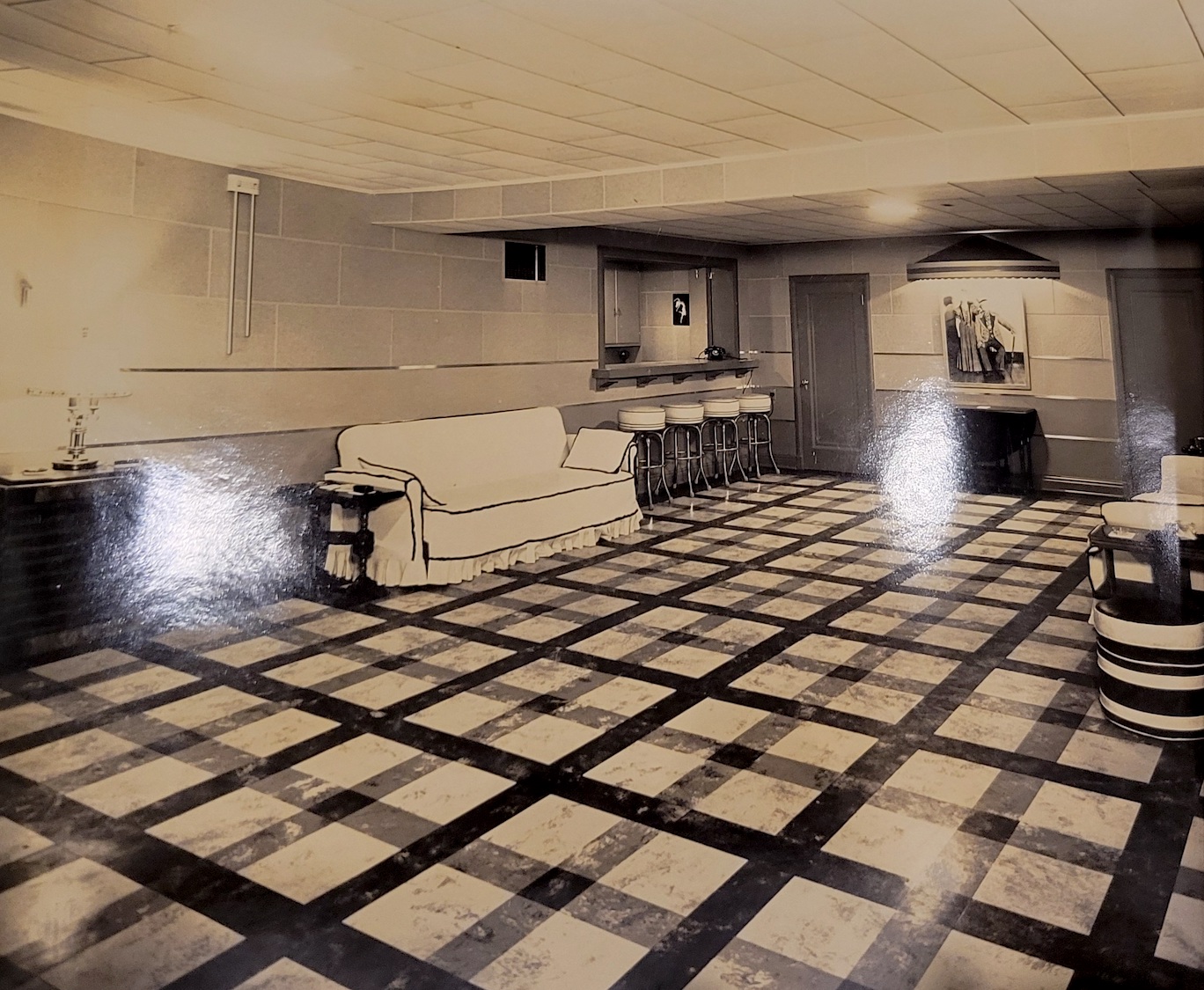
The rumpus room with linoleum flooring was considered very nice. This party room served as bar and gathering space for both the stars and party guests before entering the home theater.
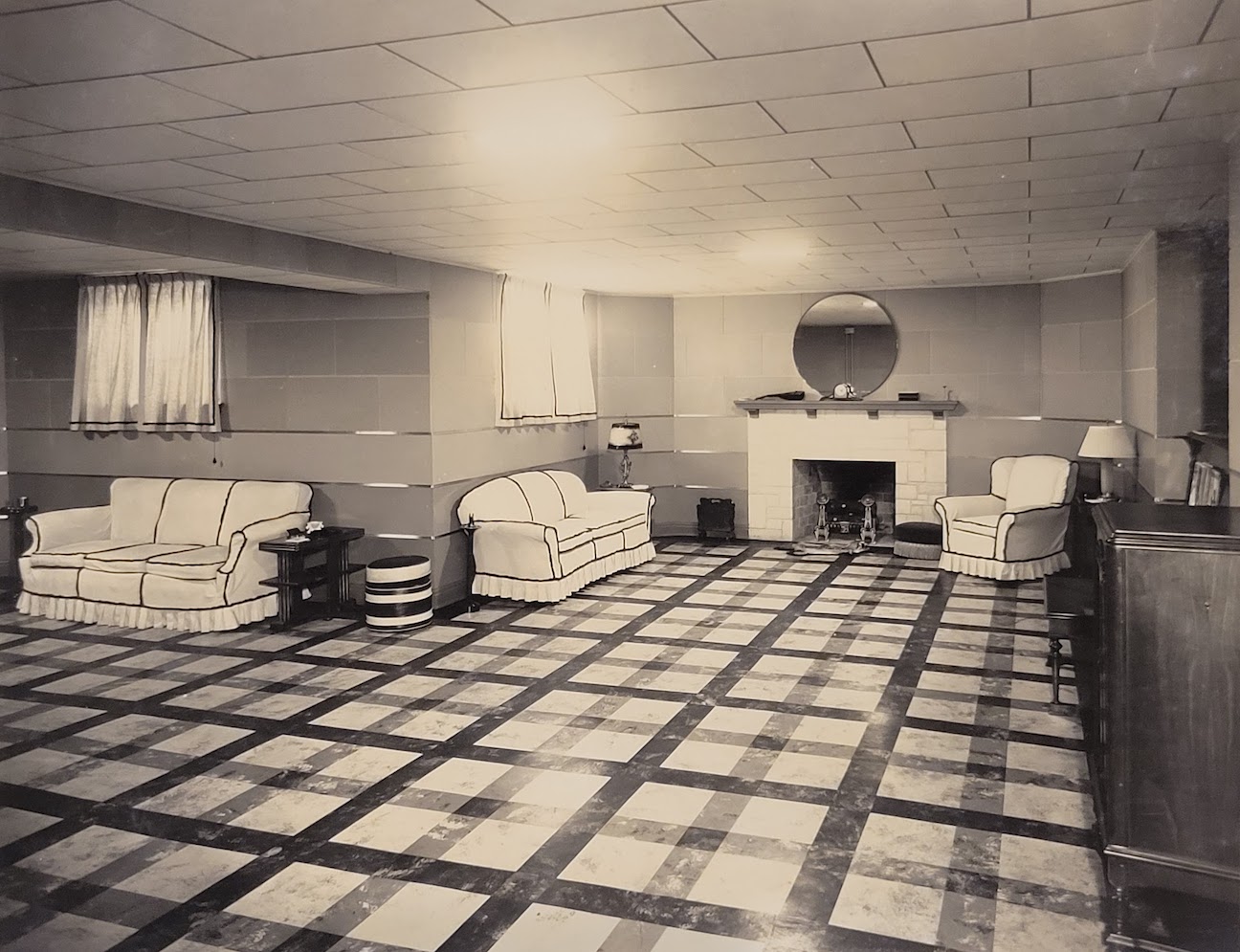
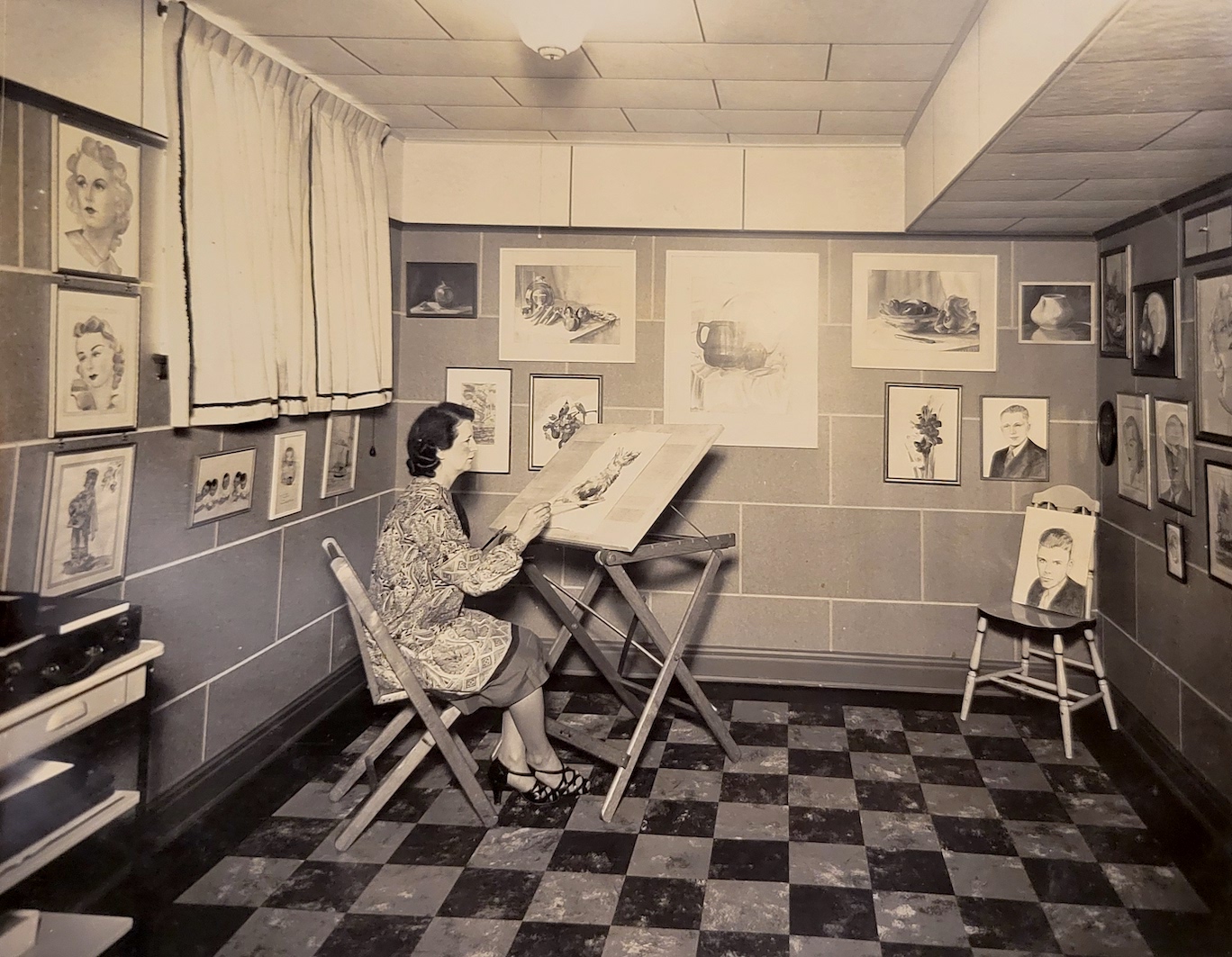
This is Esther Green in her arts studio, where she painted oil portraits for years. Her teacher was the late J. Laurie Wallace. It is so remarkable to find this photographic evidence in conjunction with her own descriptive words. Esther Green in 1962 spoke her lessons with J. Laurie Wallace: ‘Walt did everything for him to teach me. He liked his cigars black and his liquor strong. We’d send a taxi for him, wine and dine him before a lesson. So he’d sit down to watch me paint somebody and promptly fall asleep. Whenever I tried to wake him gently by asking a question, he’d jump up mad and say, ‘You don’t see that color?! What are you doing?’ The old master could be pretty cruel.”

Get an eyeful of the Green’s cavernous, state-of-the-art film screening room.“Off the basement recreation room is a little motion picture theater with a full-size screen, stage and footlights, 21 upholstered seats. The walls abound with autographed picture of Hollywood actors, most of whom have been house guests. Lucille Ball, (Lucille is said to have given Esther Green a full-length gown) Cary Grant, Betty Grable, Charlie Ruggles, Anna May Wong, William Boyd of Hopalong Cassidy fame, George Burns, Gracie Allen, Robert Cummings, Richard Allen, Jack Benny, John Barrymore, Martha Raye, Bob Hope, Jayne Mansfield and Harold Lloyd. The theater, which is underground, also serves as a storm cave and bomb shelter.”

Walter Green stands at the end of the theater room.

Impressive projection room for a home theater!

Projection room. Reel to reel for editing and splicing. Note the stairs for the projectionist.
Omahan Cindy Key had written My Omaha Obsession back in 2021 about this house. When Cindy was a child, she and her father remember going to an estate sale at the 412 North 96th Street house. Cindy’s father estimated the sale was in the 1980s. They remembered pictures of movie stars who stayed at the home and specifically remembered Bob Hope being one of them. Cindy remembers the home theater that “maybe sat 12 people.” She thought she remembered “two lane bowling alley with smaller wooden pins.” Cindy also wrote, “It seemed to me that the house had most of its original decor. It was definitely a Tudor style. I remember the estate sale coordinator saying the original owner used to screen movies for Hollywood there and specifically mentioned Gone with the Wind (my all time favorite movie.)”
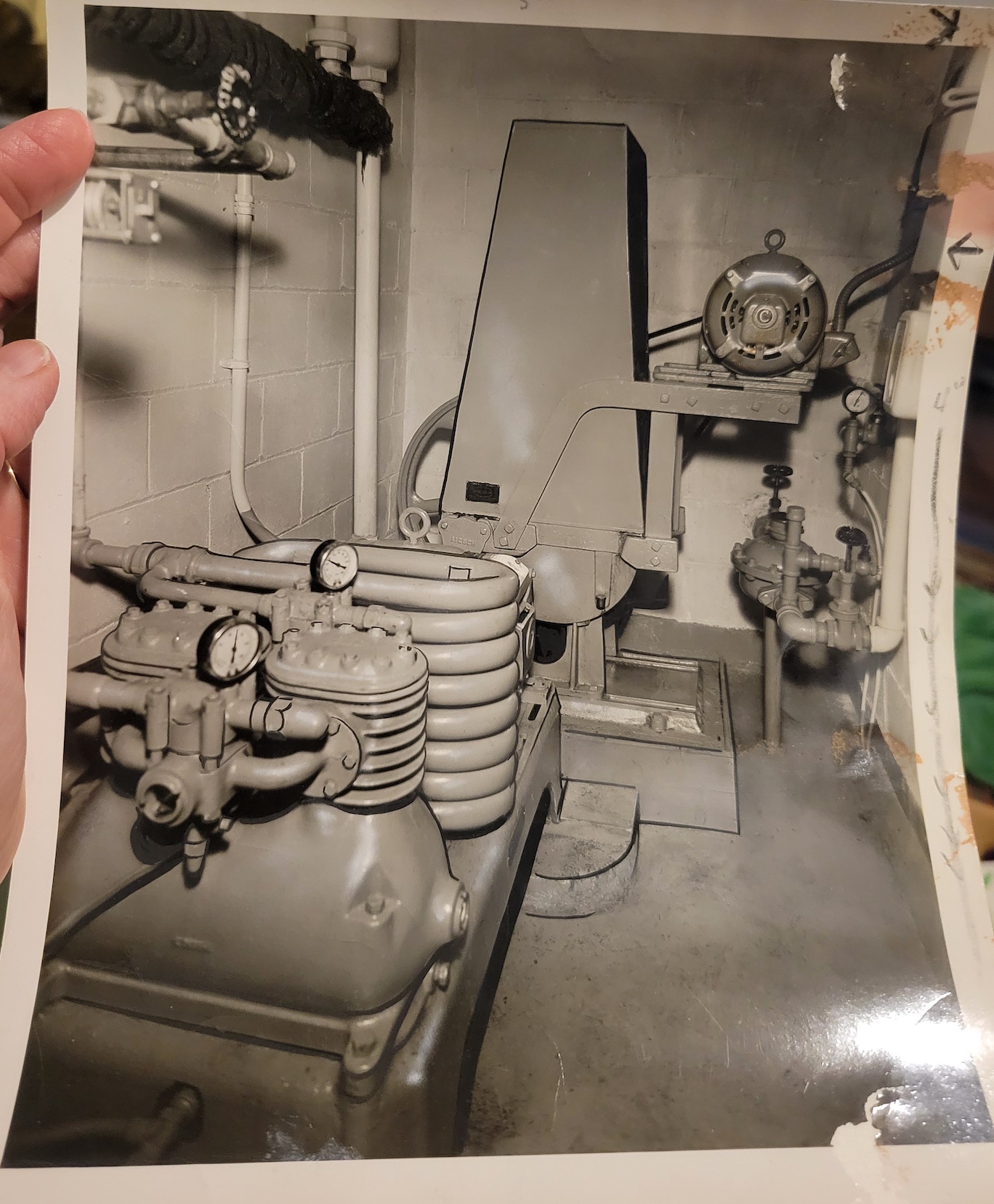
Utilities room in the basement. My friend Jimmy Kaufman thought this might have been an old generator that ran off of natural gas or fuel oil. He was not exactly sure. I’d love to hear your thoughts.
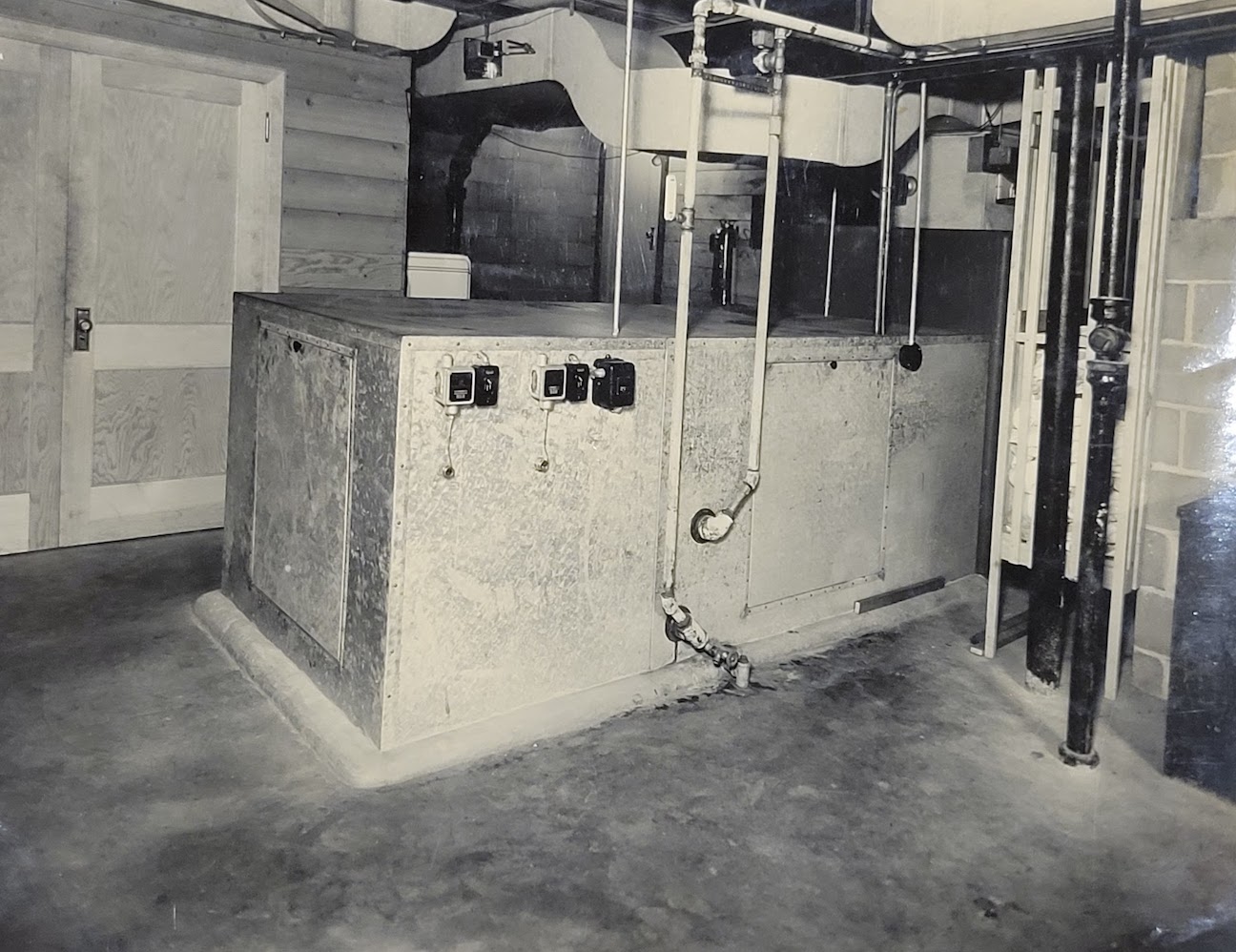
There was also writing of a separate guest house, a barn/stable and an arts house. Regrettably I was not able to find photographs to back this up.
Thank you, Effie Goodall!
The Exclusive World of Greencrest
The Greens’ joyous celebrity gatherings expanded into the decade to follow. The annual Boyer-Green reunions, Christmas dinners were also held at Greencrest, as the Greens appeared to treat family and locals friends to the same kind of soirees as they did their Hollywood friends. Harry Humphrey and his wife, Vesta Humphrey, continue to be close friends, mentioned frequently in the Greens’ social engagements. One such Big Name friend was easier to track than others. Apparently Mrs. Green first heard and met Liberace in 1939 at Chez Paree, initiating a friendship for years to follow. I was able to find that original advertisement–back when he was called Walter Liberace.

1939 Chez Paree advertisement where a young Walter Liberace performed.
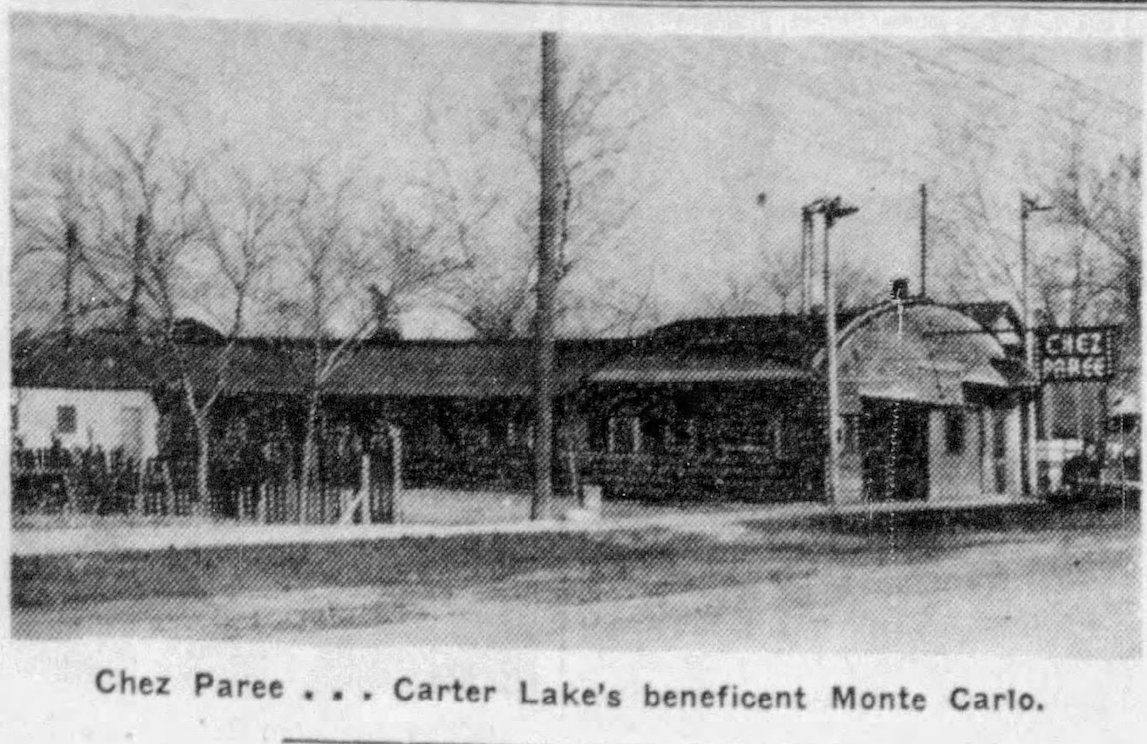
Chez Paree was in Carter Lake on East Locust Street. In 1939 Chez Paree was in trouble with Pott County for being a gambling casino and serving liquor. Although Prohibition was over, selling beer and liquor after hours was a No No. The pleasure seekers all came out for dinner and dancing.
“Esther would dish years later saying she’d known Liberace since he was a young entertainer, just starting the nightclub circuit at the Chez Paree. Walt and I liked him and he used to come over and play.’ A photograph in their basement recreation room where Liberace made his first commercial record is signed ‘Walt Liberace’ taken in the days before he dropped the Walt to become big box office.” Liberace recording his first commercial record in the Greens’ rumpus room gets a gold star from Miss Cassette.
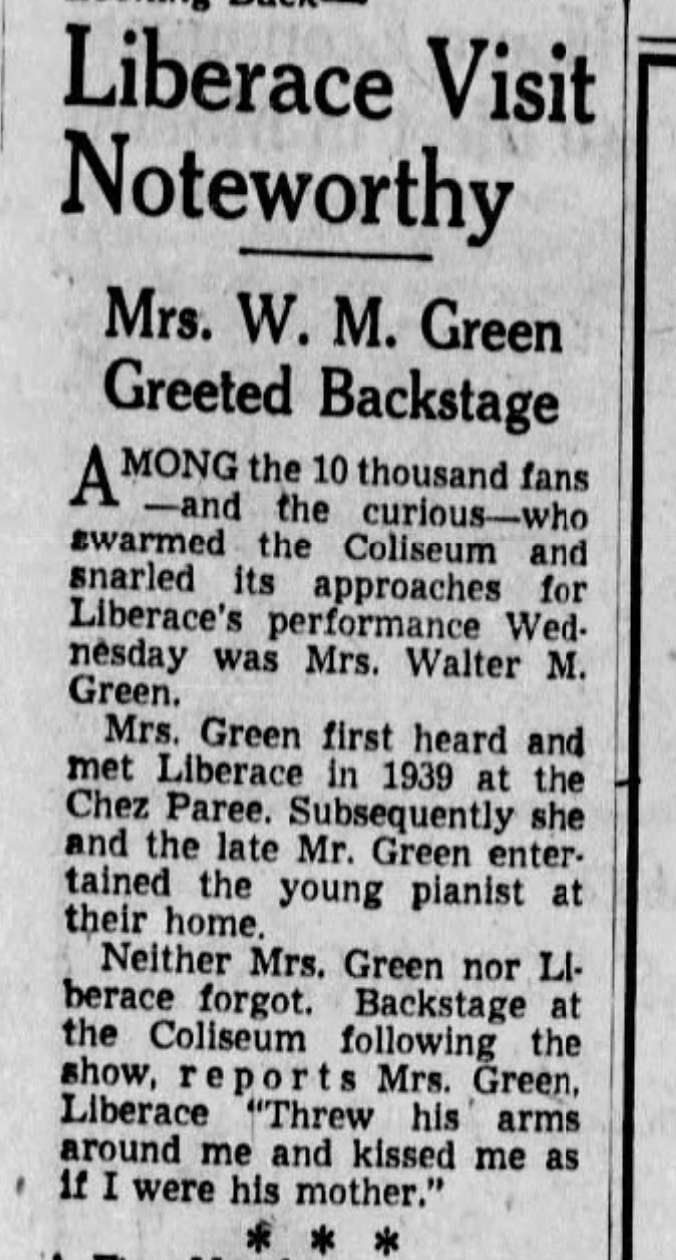
OWH 1954. Further clues in the Liberace connection.
Big Steps for Walter Green
Walter transitioned into another entertainment business by 1941. But first he paid off Greencrest. FEPCO must have been doing well, because within one year of building Greencrest Acres, the couple had paid off their mortgage.
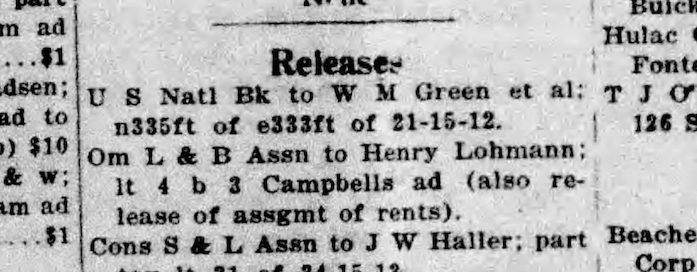
November of 1940. The Daily Record.

1940 Omaha Telephone Book revealed that FEPCO Theatre Advertising was still holding strong down at 223 North 16th Street.
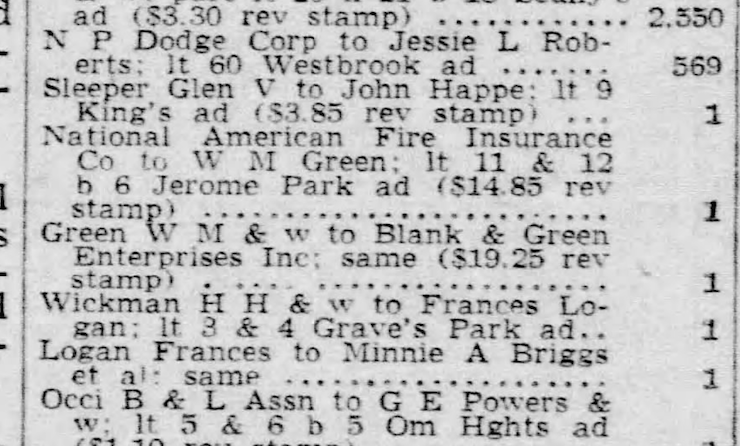
By 1941 I would discover Walter Green had bought new property from the National American Fire Insurance Company. Around this period, Blank & Green Enterprises incorporated. That is how I learned that Walter was the man behind the Admiral Theatre. The Admiral was neighborhood theater on northwest corner of 40th and Farnam. Of interest the Admiral Theatre building permit was entered in June of 1941 for a brick and concrete structure at 40th and Farnam. Completed in 1942, this theatre existed even into my childhood–the Admiral was known for playing midnight showings of the Rocky Horror Picture Show. By 1943 the Blank & Green corporation changed their name to Admiral Theatre Corporation.
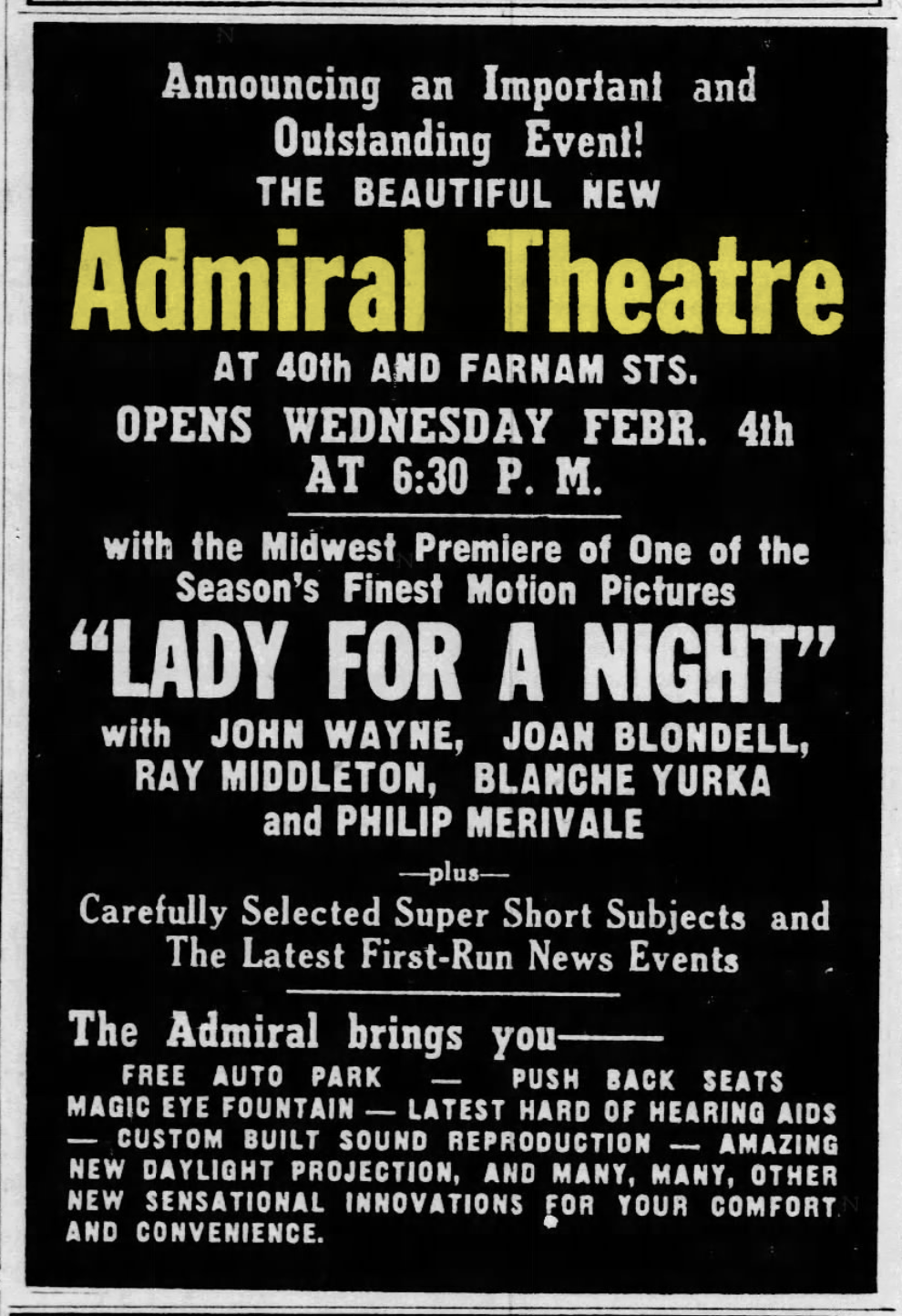
By February of 1942 they were advertising their Opening Day. “Opened on February 4th, 1942 with Joan Blondell and John Wayne in Lady for a Night, the Admiral was a $175,000 project from Walter Green and Ralph Blank.” I am sure owning the theater opened the Greens to other Hollywood opportunities.
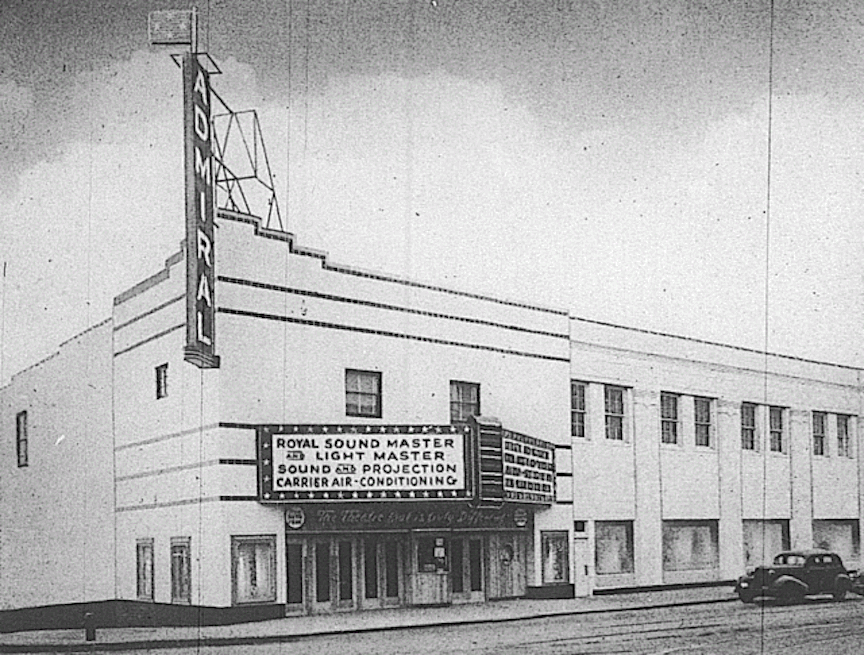
Wonderful to see. The Admiral Theatre on its opening day in February of 1942. I was so impressed that our Walter Green had found his way into the theatre business. He certainly knew enough about the industry to launch his new enterprise. The Admiral Theatre “conjured up its nautically-themed name by giving one the impression that they were on a ship in the evening. Portholes were on the wall along with the ship’s hull above and blue waves below. It was a great transformation of the Julius Wessel & Co. sheet metal factory.”
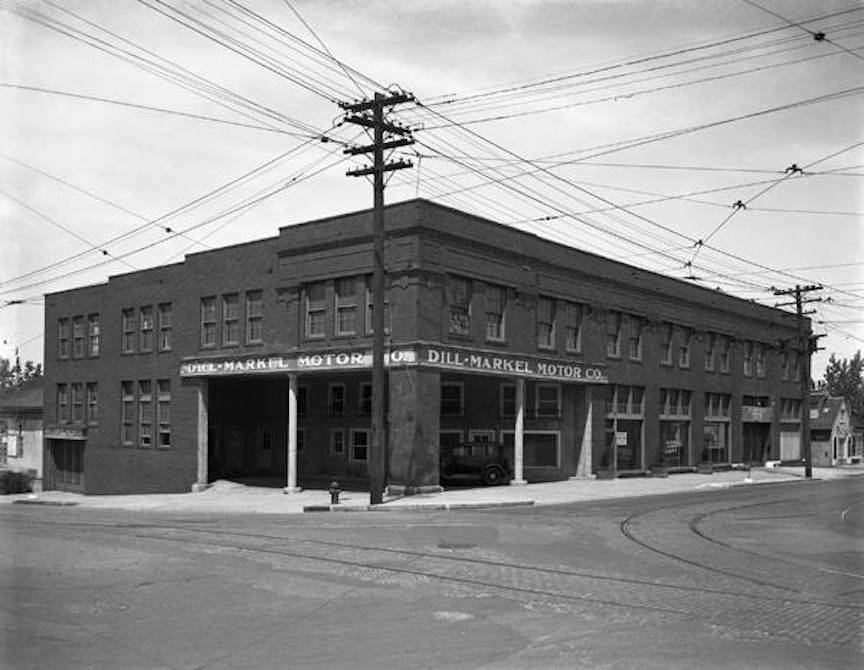
Here’s how the corner stacked up before Green started his theater, previous to the Julius Wessel & Co. Here’s the Dill-Markel Motor Company.
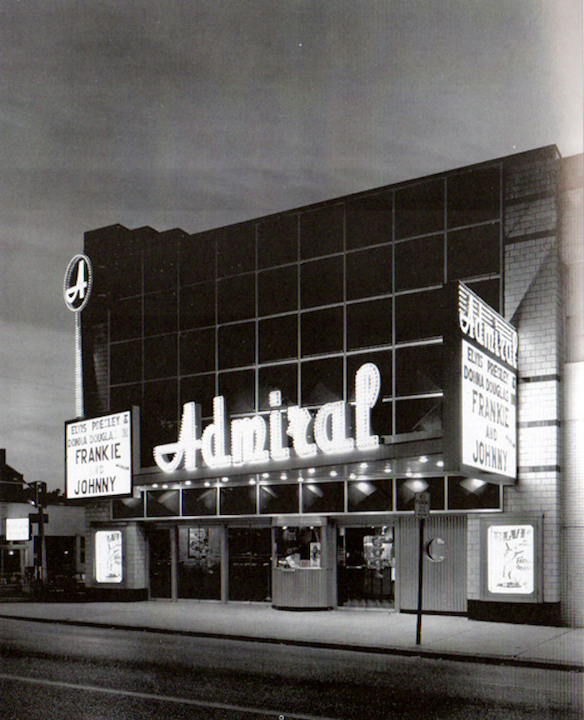
This is how the Admiral looked when I was a kid. This is a different angle, camera facing slight southwestern angle.
The Equestrians
Had Walter shelled out more for a neighboring parcel, adding to the Greencrest property size? In 1941 Walter Green was looking to buy a tractor. 1944 also marked the year that the Green acquired a fleet of Sealyham Terrier show dogs. I also found evidence of a horse stable on the property. Oddly an article two years later emphasized construction of another stable.
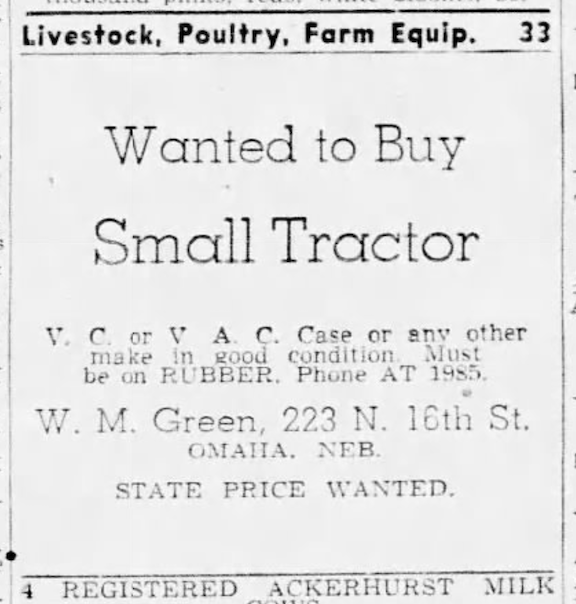
By 1946 at least, Greencrest Acres was further developed into a special place of privilege, driven by yet another of Esther’s interests. From a 1946 article in the World-Herald they captured the Greencrest scene. “A horse’s paradise is a fitting description of the Walter M. Greens’ stable, which they hope will be completed sometime this week. Mr. and Mrs. Green have been busy for several weeks converting their pre-war steakhouse and servants’ quarters in the rear of their home into a pack room and stable for their three horses. Near the stable they have their riding ring, which will be illuminated so they can ride at night. Bleacher seats have been provided for spectators. The lounge or pack room is going to be very much in keeping with the Greens’ hobby. Saddled and bridles will hang on the walls and the drapes and chairs will be decorated with appliqued figures of horses. Already they have made their own bridle path west of Greencrest Acres, their suburban home. And they are going to change the name of their champion show horse from ‘Queen of South Park’ to ‘Queen of Greencrest.’” From a later 1962 article, Esther was said to have become quite the horsewoman, she hired a trainer, and owned and developed four champion show horses. On her three-gaited chestnut mare, “Queen of Greencrest” she carried off many ribbons at the American Royal in Kansas City.
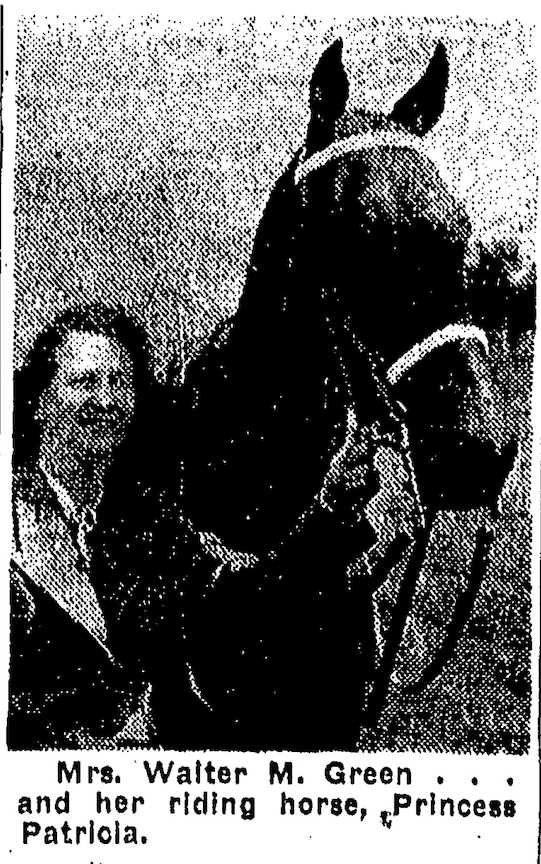
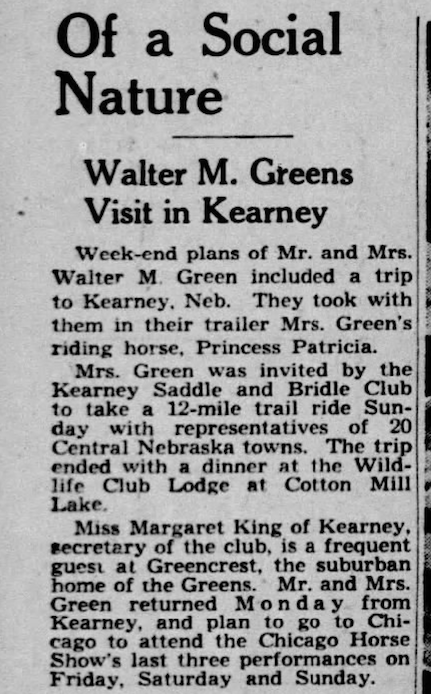
1947 Mrs. Walter Green and her riding horse, Princess Patricia. Another horse called Queen of Greencrest earned notoriety as a show horse. They had a Tennessee walking horse named Dixie Allen and a five-gaited show horse, Illustrious Peavine.
The Matter of the Humphreys
I had asked you to tuck the name Mrs. Harry Humphrey into your sleeve. Let’s review now. Vesta Florence Bennett Humphrey had been, seemingly, a dear friend of Esther Boyer Green. She was born in 1897, supposedly one year older than Walter Green (but his birth year seemed to change, dependent). Vesta’s husband Harry Francis Humphrey worked for the Field Hamilton Smith Paper Company. Harry was born in 1902 in Iowa.
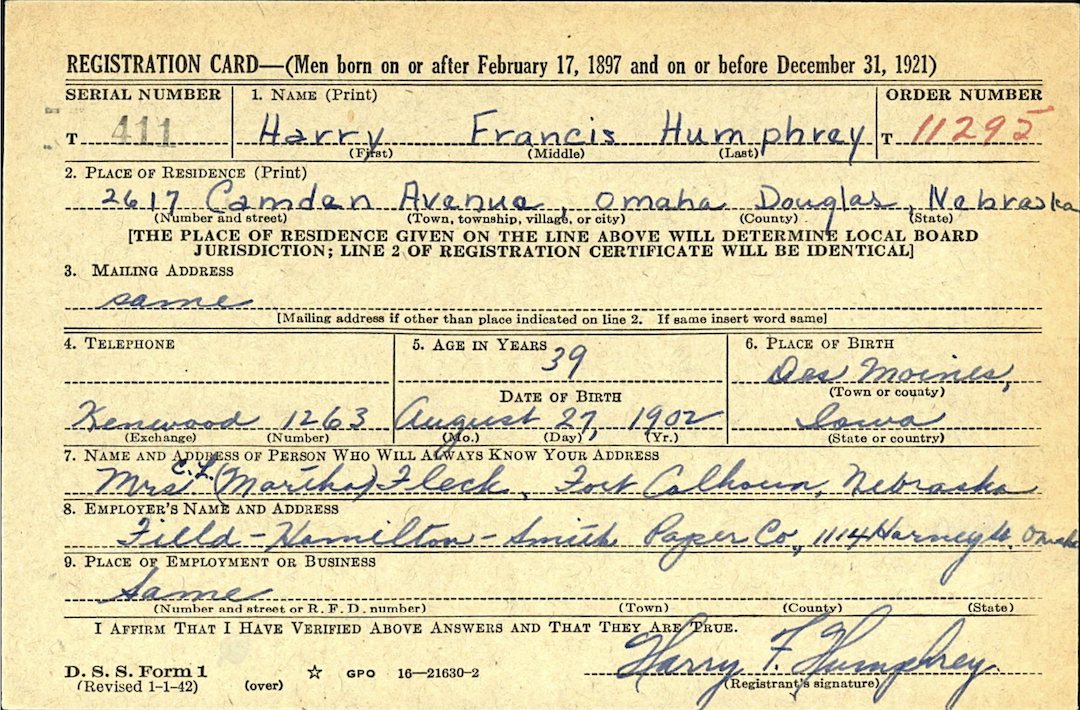
Harry Francis Humphrey 1940-1947 U. S. World War II Draft Card.
The Humphreys married in December of 1920 in Polk County, Iowa. Had the Green-Humphrey couples known each other from an Iowa connection or perhaps an intermingling of the paper company meets advertising printing world? The Humphreys lived at 2617 Camden Avenue.
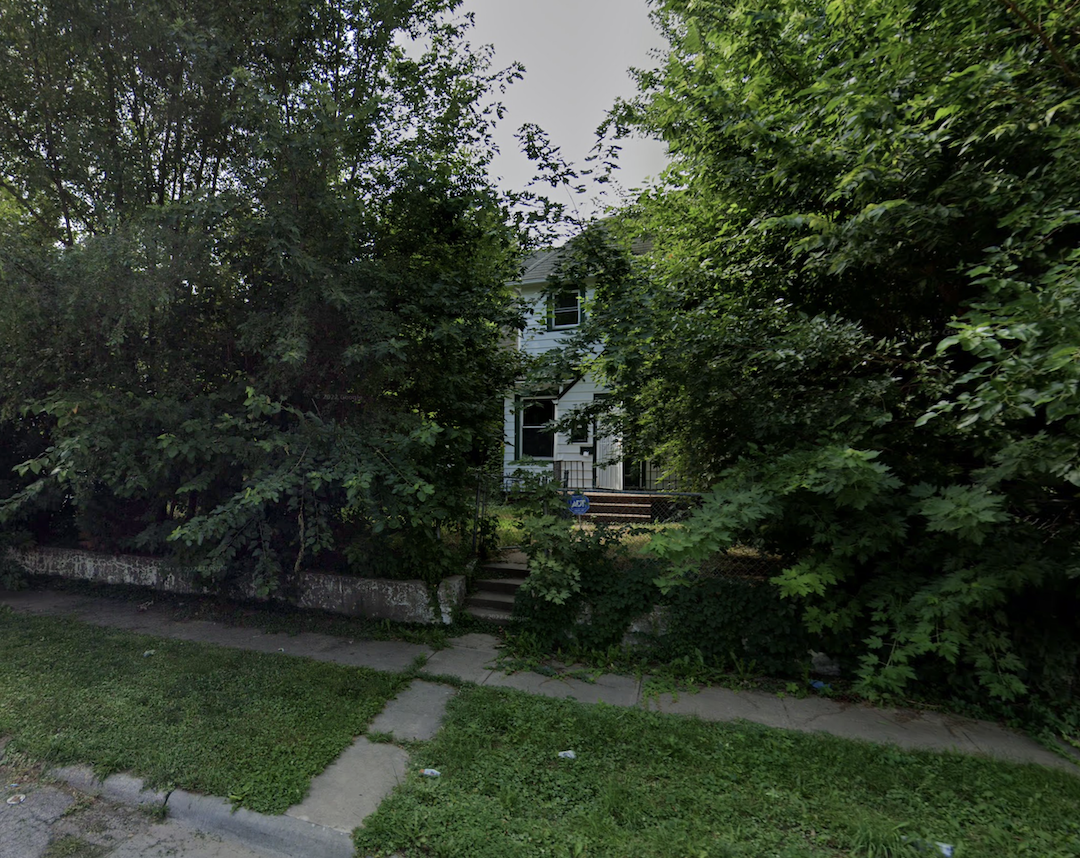
2617 Camden Avenue today.
In 1941 “Vesta Humphrey, 42, was overcome by gas in the kitchen of her home last night. A pot of coffee boiled over, extinguishing the flame on the gas range, according to the police. She was revived by the fire department inhalator squad. It was all rather mysterious, and accidents do happen, so I filed it away. She lived on. I bring emphasis to the Humphreys because the two couples would be forever joined when partners passed away in time.
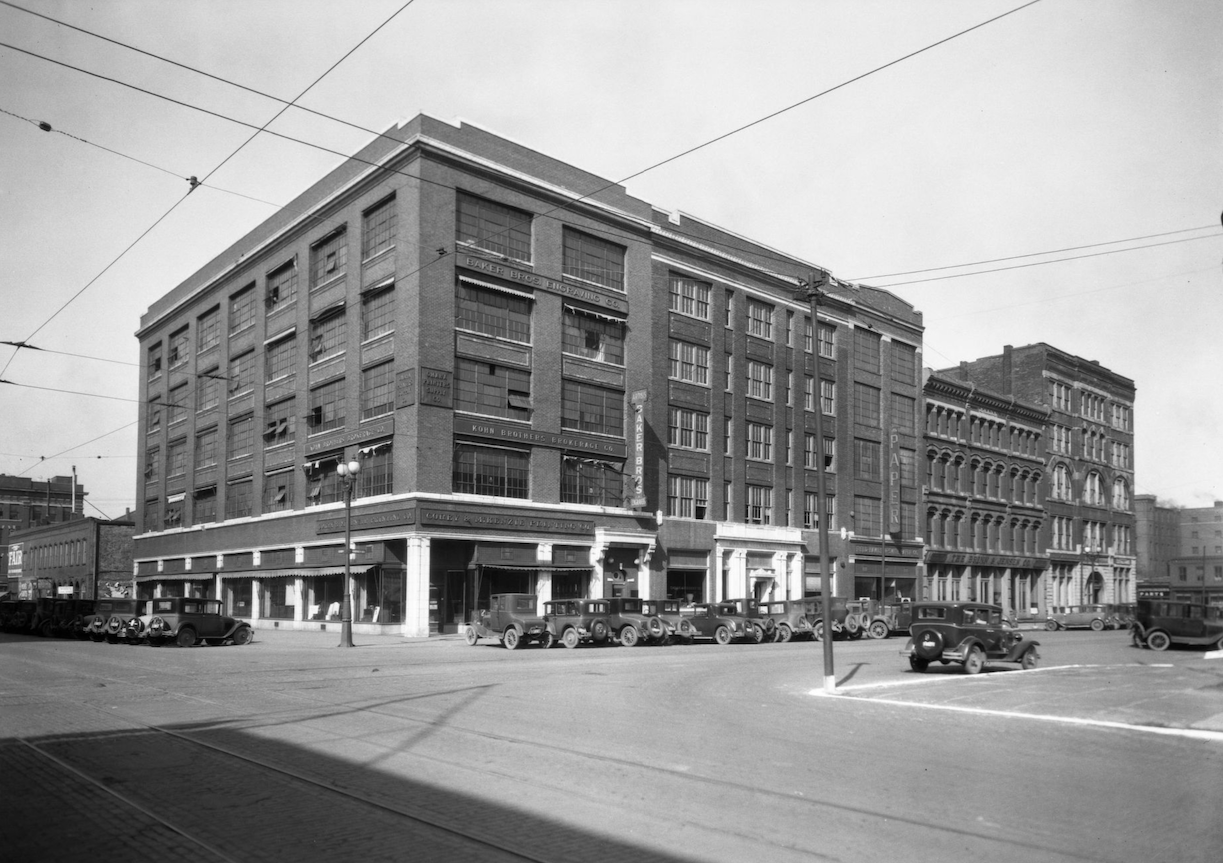
Harney and 12th street from northeast corner looking at southwest corner. Buildings include: Corey & McKenzie, Field Hamilton Smith Paper Company, Brinn & Jensen company, 1981 “Yellow Building” home of Bahr Vermeer Haecker. All buildings except Omaha Tent and Awning building at northwest 11th and Harney were demolished in October and November of 1988. 1929 Bostwick, Louis and Frohardt, Homer. Durham Museum.
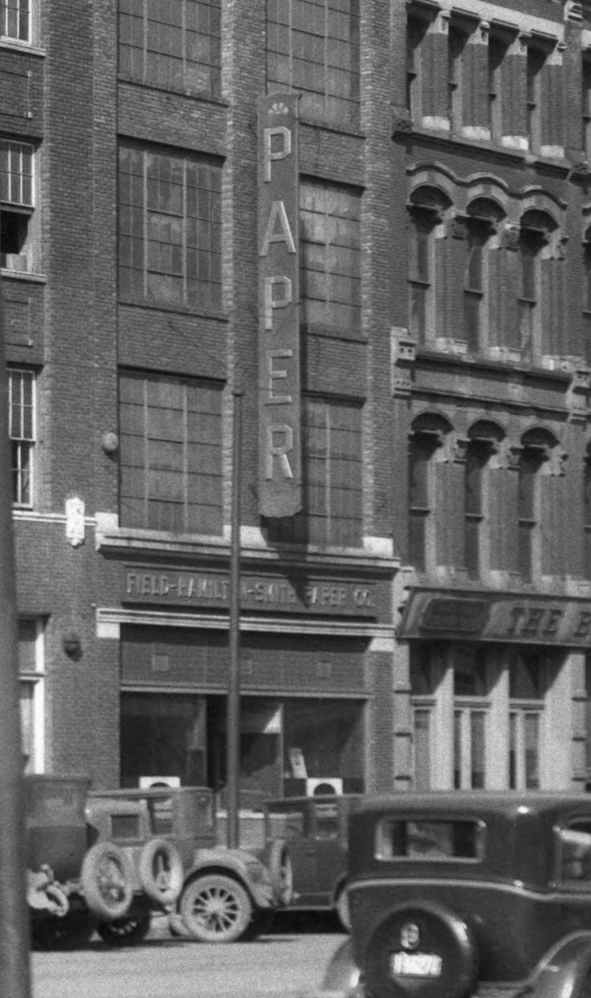
Field Hamilton Smith Paper Company detail of the previous photo. 1929.
Death of Walter Green
In November of 1950 Walter Malvern Green died of a heart attack in the Greencrest Acres Tudor. He was only 50 years old.
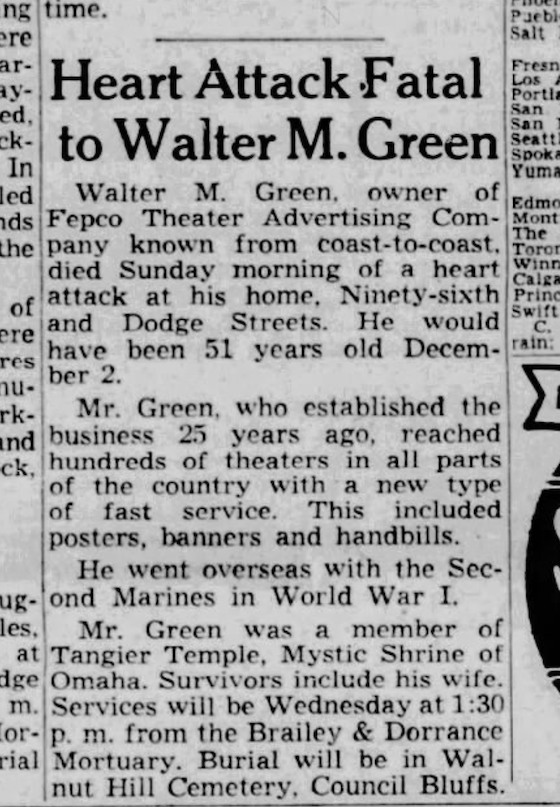
November of 1950. Esther Green would say twelve years later, “At the time of Walter Green’s death in 1950, FEPCO was serving independent exhibitors in over 4,000 small towns. I had been away from the business a good 15 years when Walt died.” He had built a strong company.
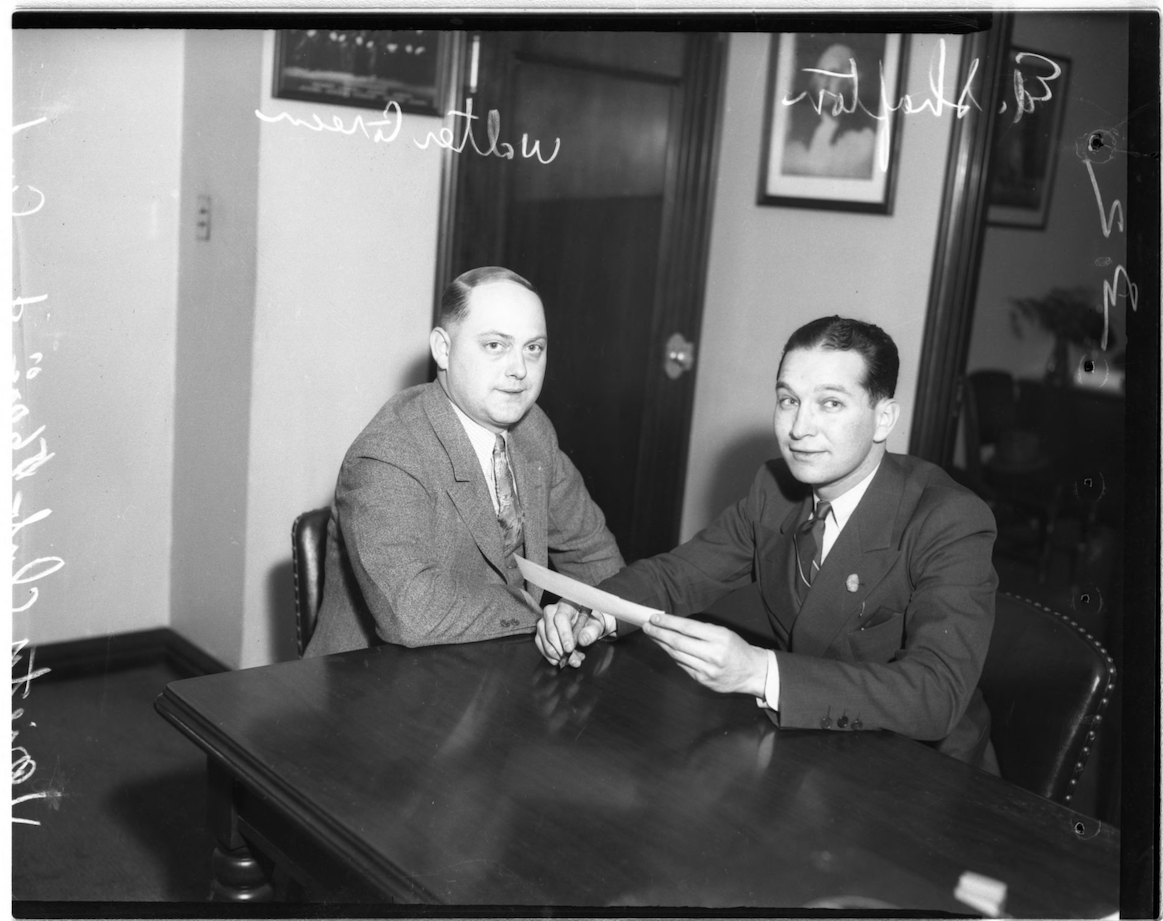
This photo was labeled 1952 but I suspect it is earlier, considering Mr. Green’s death. Walter Green and Ed Shafton. Photo by John Savage.
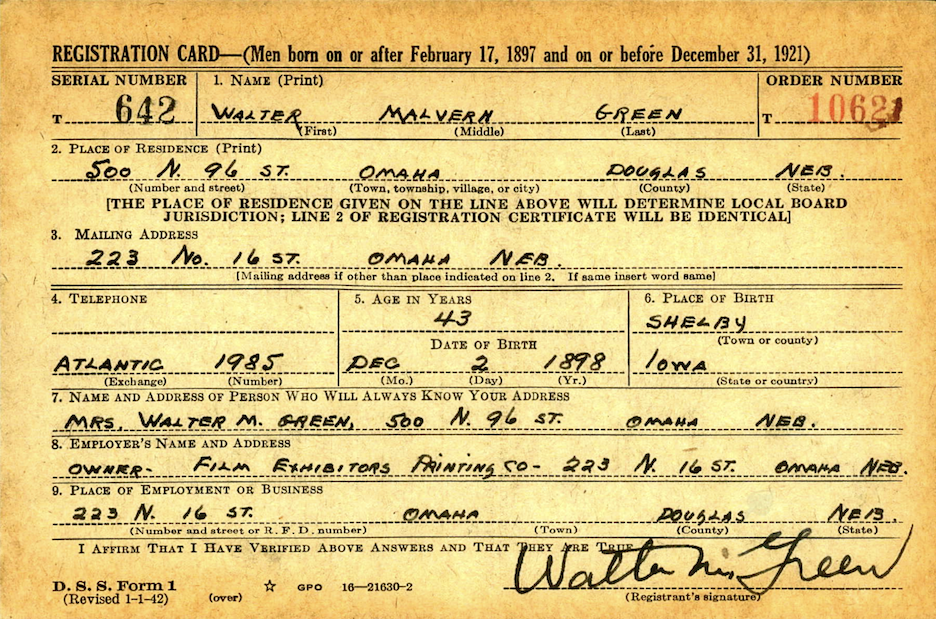
Walter Malvern Green 1940-1947 U. S. World War II Draft Card. Interesting that an early address of 412 North 96th Street was called 500 North 96th Street. (I exhausted all searches into that address.)It wasn’t until 1957 that I finally found my proof of the 412 North 96th Street address. Also there is another example of Walter’s shifting birth date.
Esther’s Third Chapter
Esther Green returned to work at FEPCO Theatre Advertisers as owner and general manager. With the help of Walter’s long-time employees, Esther expanded the business to even greater success. Ronald Rosseter, sales and production manager of FEPCO, had started in 1932. Emery Toth, head of sales and service started with the company in 1934. Warren Baker, shop foreman worked since 1937. Donald Helton was a photoengraver with the company since 1938. These men still worked at FEPCO at the time of the Benson Sun 1962 article. Esther acknowledged that by the time she took over the business, small town movie houses were struggling to keep alive.
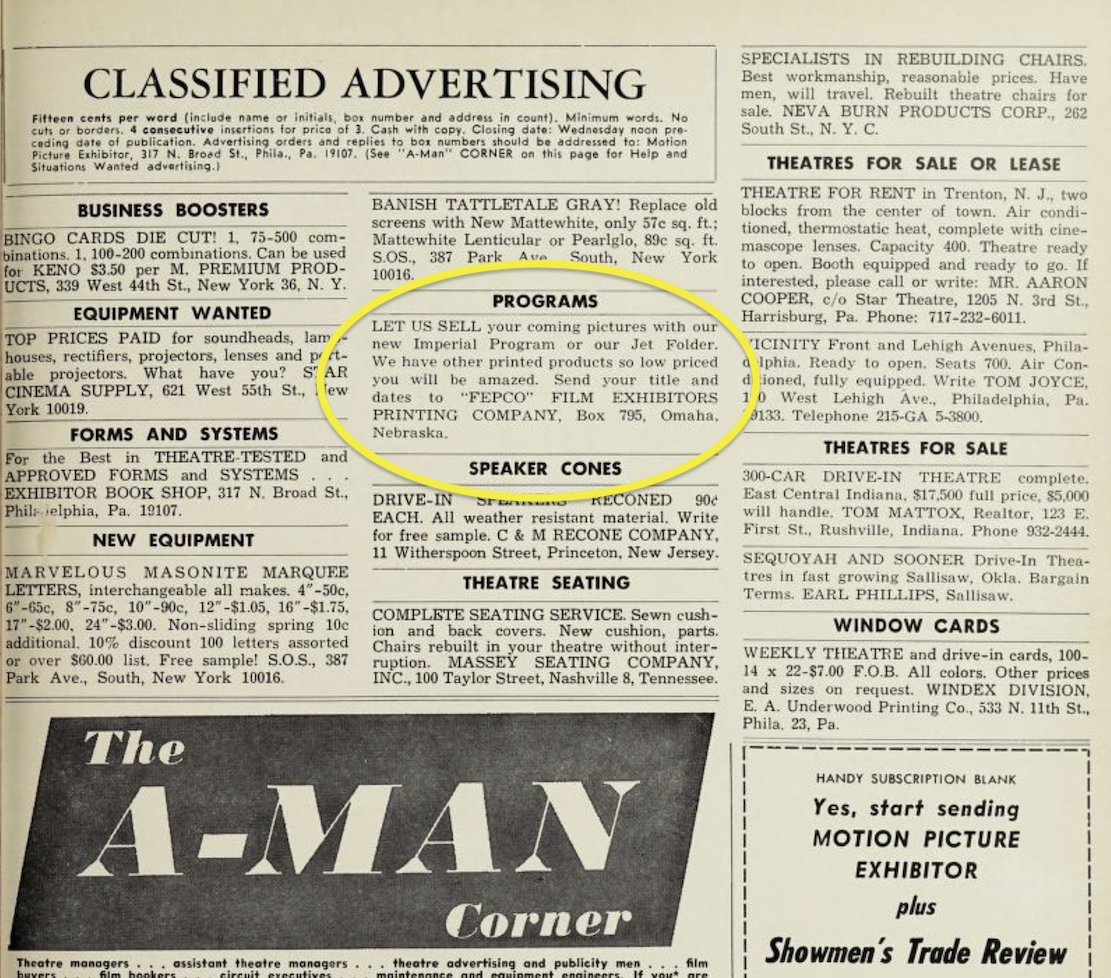
From the Motion Picture Exhibitor July-Oct 1965. I found this one in the library archives. So cool.
In February of 1957 Vesta Bennett Humphrey died at the age of 56. I could find no further information about Vesta’s death. By December of 1957, Harry Humphrey and Esther Green get married. They are both listed as age 55 on the announcement.
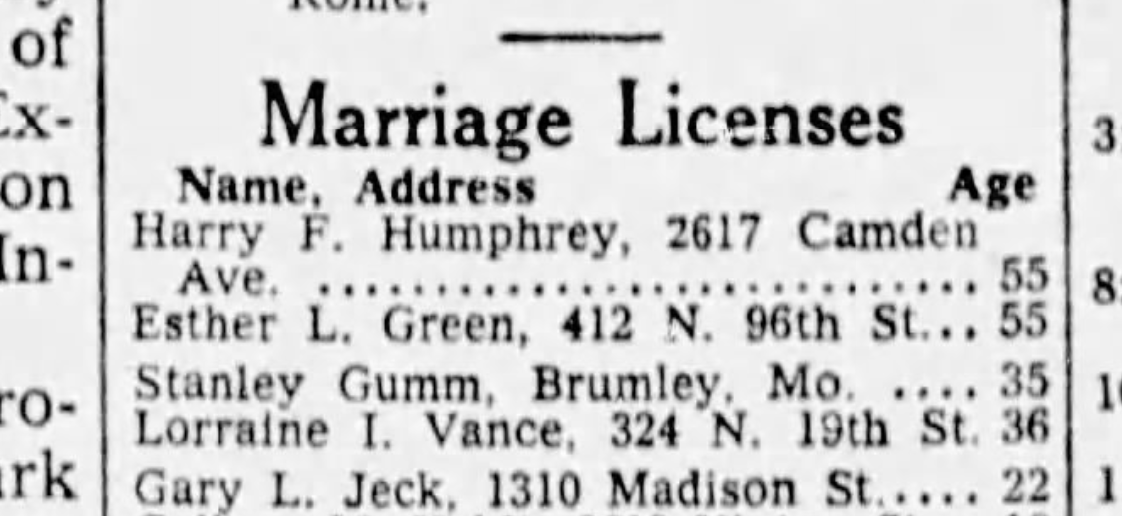
December of 1957 marriage license.
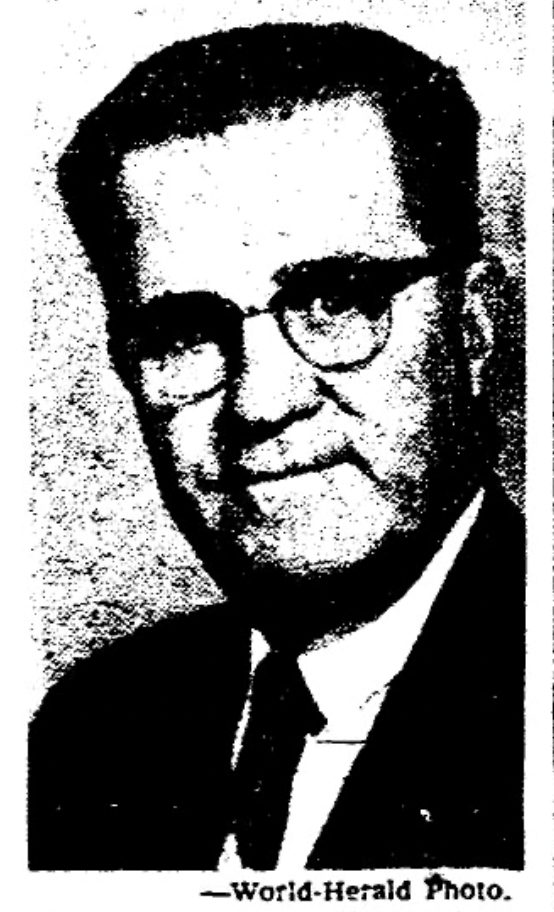
Here’s Harry Humphrey from 1961. Harry continued on as a salesman at Field Paper.
Esther’s life and accomplishments were celebrated in the Benson Sun and the South Omaha Sun in November of 1962 in an article called The Private World of Esther Green: After Polio, She’s a Dynamo in a Man’s World.
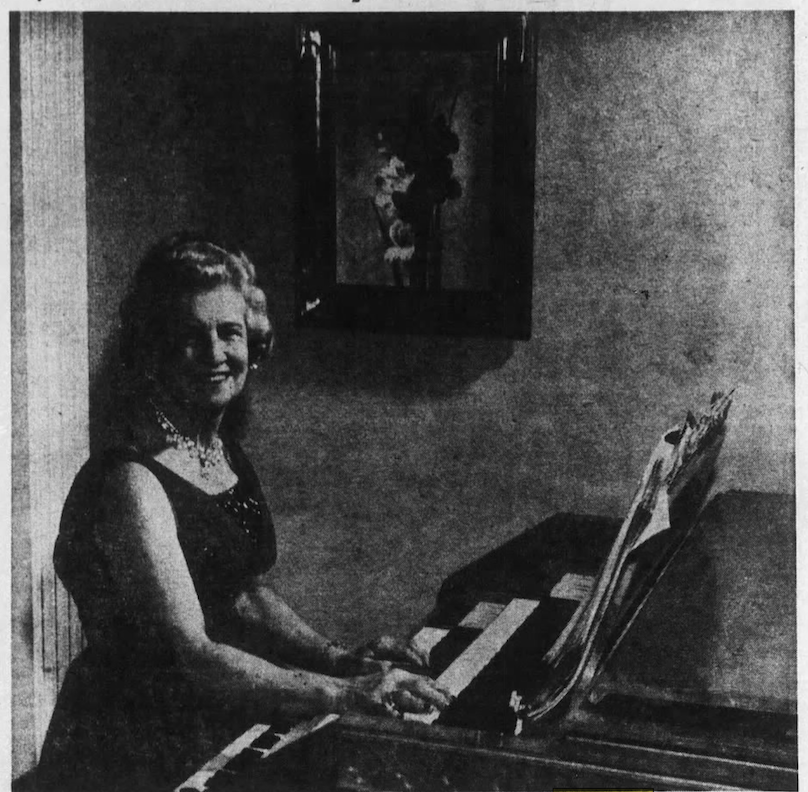
Esther Green Humphrey at the piano in the 412 North 96th Street house.

Esther L. with her man Toth at the office. Emery Toth, head of sales and service started with the company in 1934.
The West Omaha Dilemma
By the early 1950s, the 96th and Dodge Road area was becoming a hustle bustle that the country loving neighbors had not predicted. In this time period, Dr. A. B. Pittman, Omaha famous veterinarian, had moved to 9701 Dodge Street, a nearby neighbor who would become instrumental to the area. He later served on the Omaha Planning Board. In 1955 a large MCM ranch was built in the field, directly west of the Green-Humphreys estate; this field was where Esther once had her bridle path. At this time the West Dodge Frontage Road was build, moving around the large 412 North 96th Street property. This was an access road leading from 96th to the ranch to the west.
Mrs. Esther Green Humphrey was obviously reconsidering the whole 96th and Dodge residential situation. She had joined Dr. A. B. Pittman, then an Omaha Planning Board member in his petition to rezone the neighboring properties southwest of 96th and West Dodge Road. They were met with heavy opposition. Dr. Pittman lived at 9701 West Dodge Road. Howard Lundgren was at 318 North 96th. Along with Mrs. Green Humphrey, the three were seeking rezoning from second suburban to nine residential. The new zoning would have permitted construction of high-rise office and apartment buildings. Apparently Dr. Pittman was considering building an office building of “not more than” three stories and “possibly an apartment building.” Lundgren was also negotiating for construction of a three-story office building. Mrs. Humphrey’s attorney said she had “no specific plans to date.” The attorneys for these owners argued that the widening and dividing of West Dodge Road had significantly changed conditions of the area, let alone the development of the Westroads Shopping Center, justified office and apartment use of the land. But the board had already given preliminary approval to the new Regency neighborhood plat and these taller buildings on the periphery would have impeded that planning. In addition the other nearby neighbors didn’t want to be surrounded by taller buildings not in keeping with residential.
Side notes of interest: By 1968 Dr. Pittman’s home was at 9701 West Dodge Road continued on as proposed site for office buildings and high-rise apartments. John R. Maenner, president of the T. H. Maenner Company, who was handling the development of United of Omaha’s Regency neighborhood loudly stood against the Pittman development. Maenner’s belief was that this high-rise would ruin the Regency neighborhood lay out. Regency won. In the early 1970s 96th Street was “illegally closed” at West Dodge Road. Dr. A. B. Pittman, still on the Omaha Planning Board, argued that 96th Streets’ opening to West Dodge Road was illegally closed and won board support to open it back up in 1974.
During this time Esther was making moves to leave the area. She had bought a five acre tract of land at 66th and Grover. “I have an idea that (FEPCO) will stay right on the corner of 16th and Davenport and operate it as a main office and use the new building for a factory and branch office.” FEPCO did remain at 223 North 16th (the Leflang building) for a time but by the mid 1960s, I found Esther had moved her company to 416 South 14th Street. She also constructed a home on the upper level. I am not sure if Mr. Humphrey lived with her or not. His name remained on the 412 North 96th Street house until he sold it in the 1980s. For those wanting to follow every breadcrumb– Esther Green’s 66th and Grover acreage had become “a rubbish transfer station.” This company station was to work in tandem with Metropolitan Sanitation Company. I am not sure if this was her second plan, after the FEPCO factory idea fizzled? At any rate, the City Council moved to condemn the site and building because of its condition by the late 1960s early 1970s.
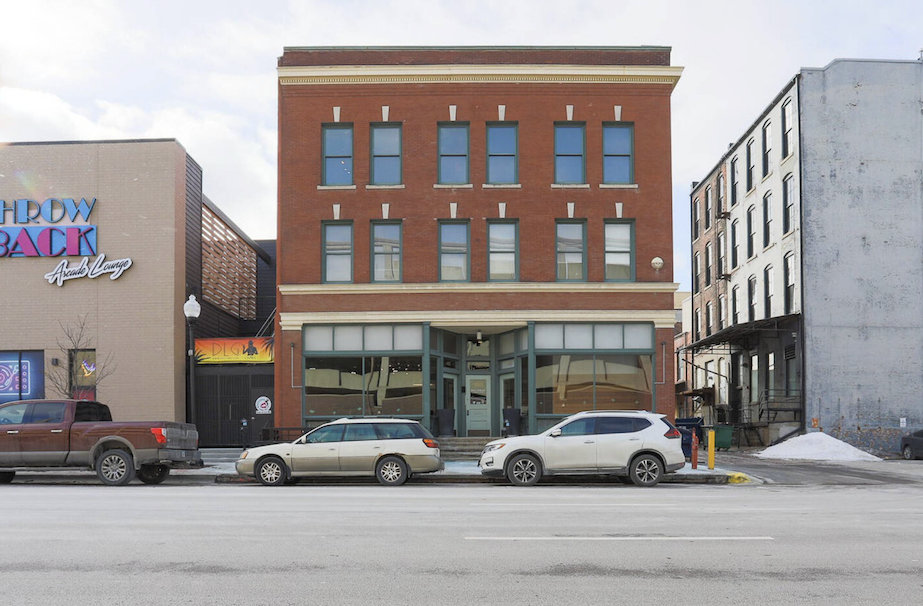
The FEPCO building was at 416 South 14th Street. This great building was erected in 1903 for the Irvin A. Medlar Printing Co. A brick structure with excellent glass entryway was significantly renovated in the mid-1960s by FEPCO. One of the upper floors became Esther’s home. Because of changes to the film advertising industry, FEPCO closed for good in 1980. The 416 South 14th building was bought by Florris Fuchs in 1980 and sold to Dan Emanuel in 1985. It was included in the Landmarks tour in 1986.
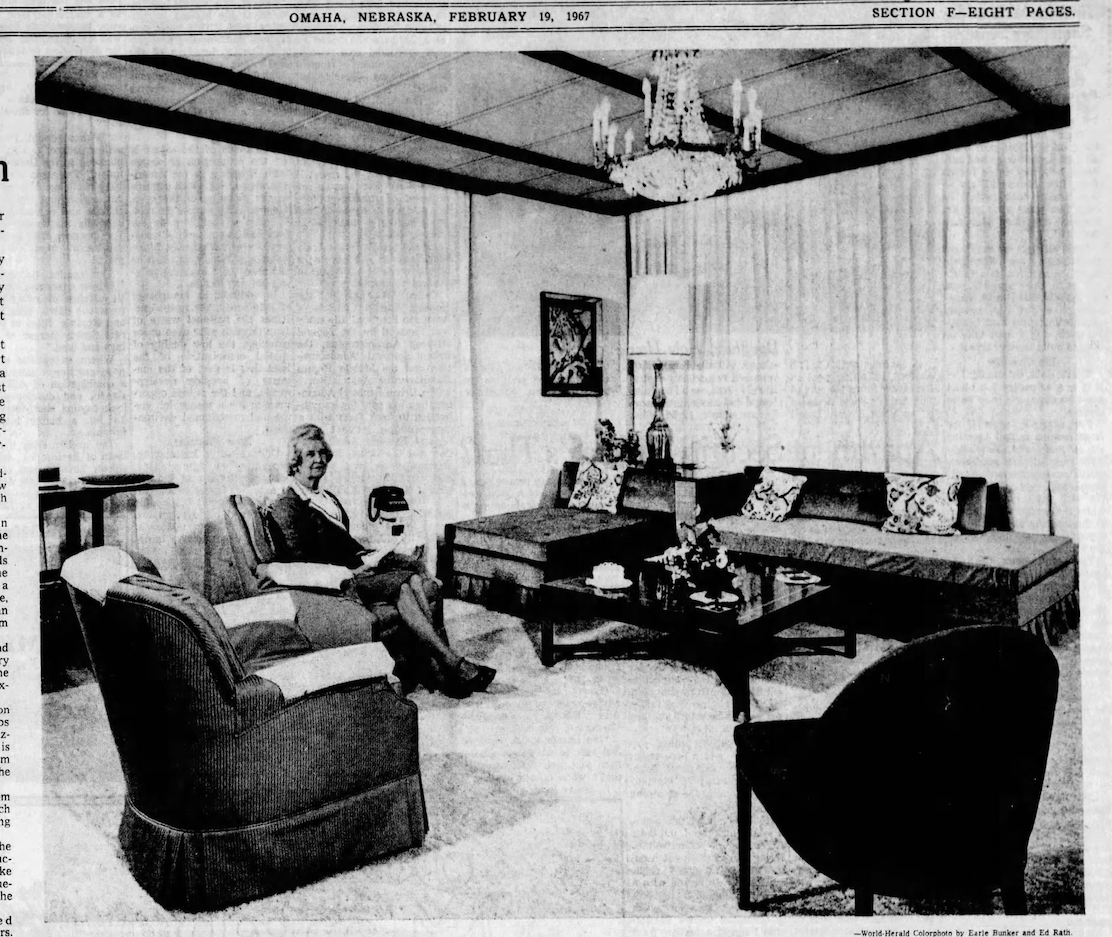
World-Herald of 1967. Esther showing off the new downtown digs. I love it. The telephone perched next to her.

Terrible aerial. Sorry. 96th and Dodge Road. I put lines around Greencrest. Hard to make out but there are a lot of outbuildings present at that time. The yellow arrow points to the large ranch built directly to the west off of the frontage road, once site of the Green bridle paths.
The Sale
At least on paper, evidence shows that Harry Humphrey lived out at 412 North 96th through all the years of big change. Westroads Shopping Center was built. The Regency neighborhood was successfully developed. West Dodge Road became a wider, busier thoroughfare. Small suburban tracts filled in. Older homes torn down, larger homes sprung up. I can hardly see the 412 North 96th Street property in my mind, other than remembering how large it was. Esther Boyer Green Humphrey died in 1981, just a year after FEPCO closed their doors. What a lively character she must have been!
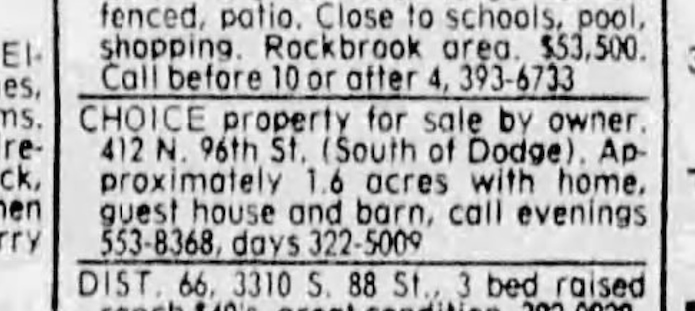
In April of 1984 Mr. Humphrey put the Greencrest Acres property on the market. It was listed as 1.6 acres, a 4,700 sqft home, guest house and barn.
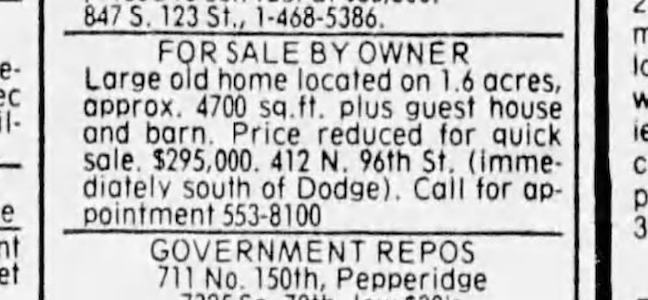
In July of 1984 412 North 96th Street’s price was reduced for “quick sale.” I believe it was during this time that Cindy Key and her father (previously mentioned) had toured the home for the estate sale. I can imagine all of Omaha must have crammed in there to get a look at what we had only ever seen in passing on the way to Westroads. I do wish I could see that guest house.
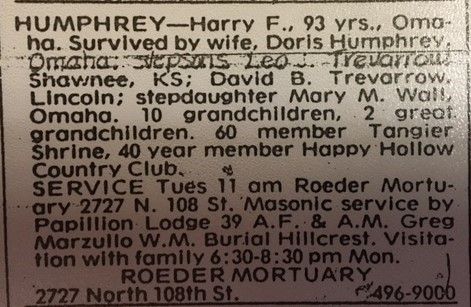
In December of 1995, Harry Francis Humphrey died at the age of 93. He is buried at Westlawn-Hillcrest Memorial Park. I couldn’t help but notice his obit read, “Survived by wife, Doris Humphrey.” The modern dance pioneer? No, couldn’t be. Lending credence to my belief that Harry continued to live out at 96th Street when Esther moved downtown. Second thought–Esther died in 1981. He possibly married after that.
**Addendum of April 3, 2024**
More photographs from Effie Goodall have come in! These really bring it all in to perspective. I believe these were taken about fifteen to twenty years after the first Greencrest look book, judging from the trees and shrubs.
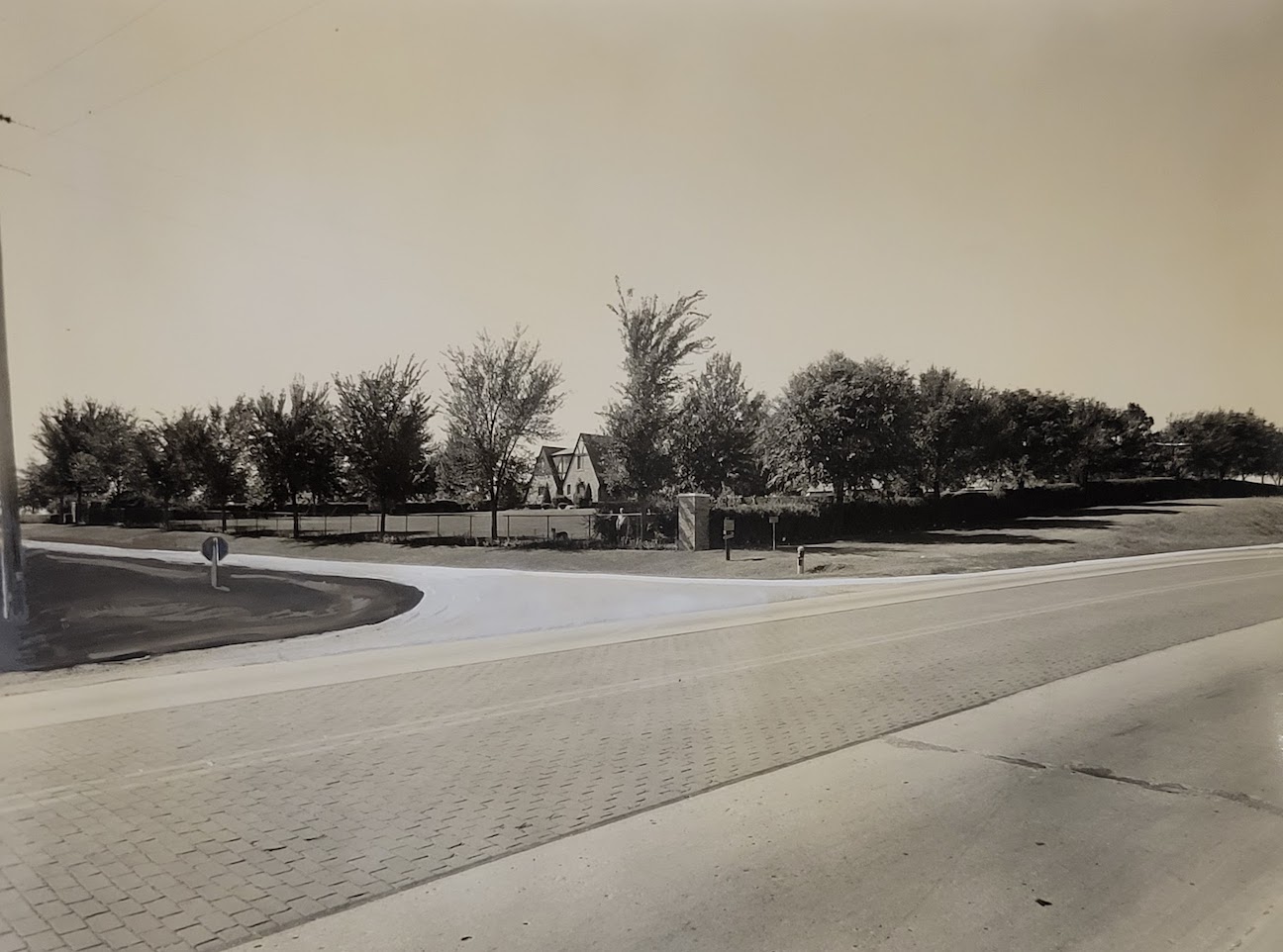
Just amazing. Camera faces southwest angle across the once highway, turned West Dodge Road. 412 North 96th is seen in the distance. Brick pillars are posted on the corners, with the chain link fences around the edge. The Green Humphreys are seen with a dog or two looking at the camera man. Glorious.
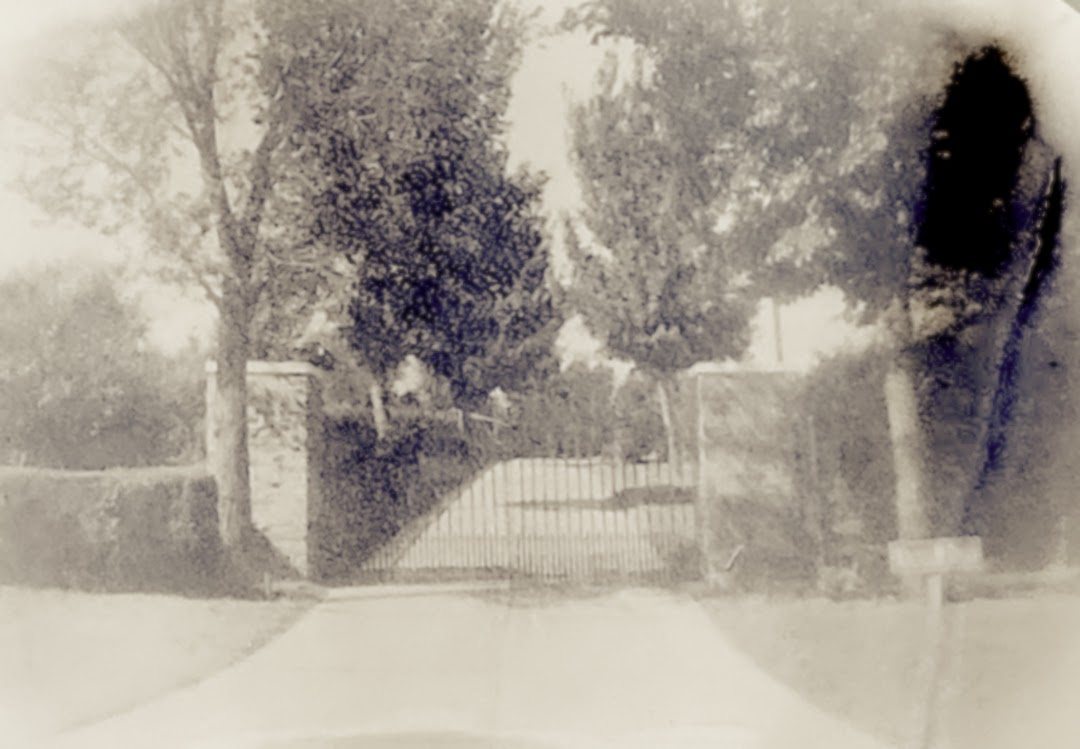
The brick entry gate on 96th Street.

Shutters flanking the doorway has been modified. A good change. Note the little guest house in the background.
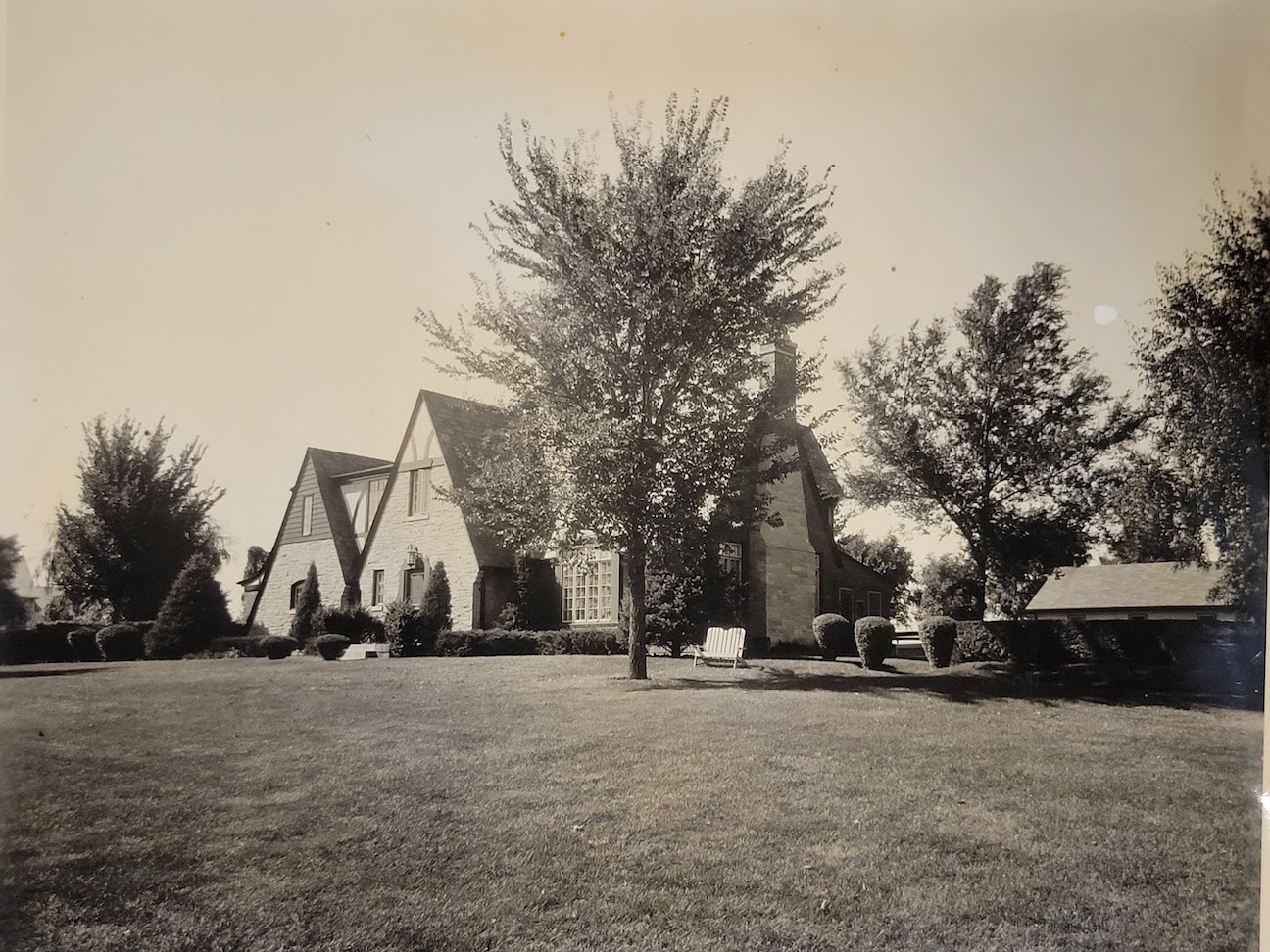
Lovely changes with the addition of the garden space.
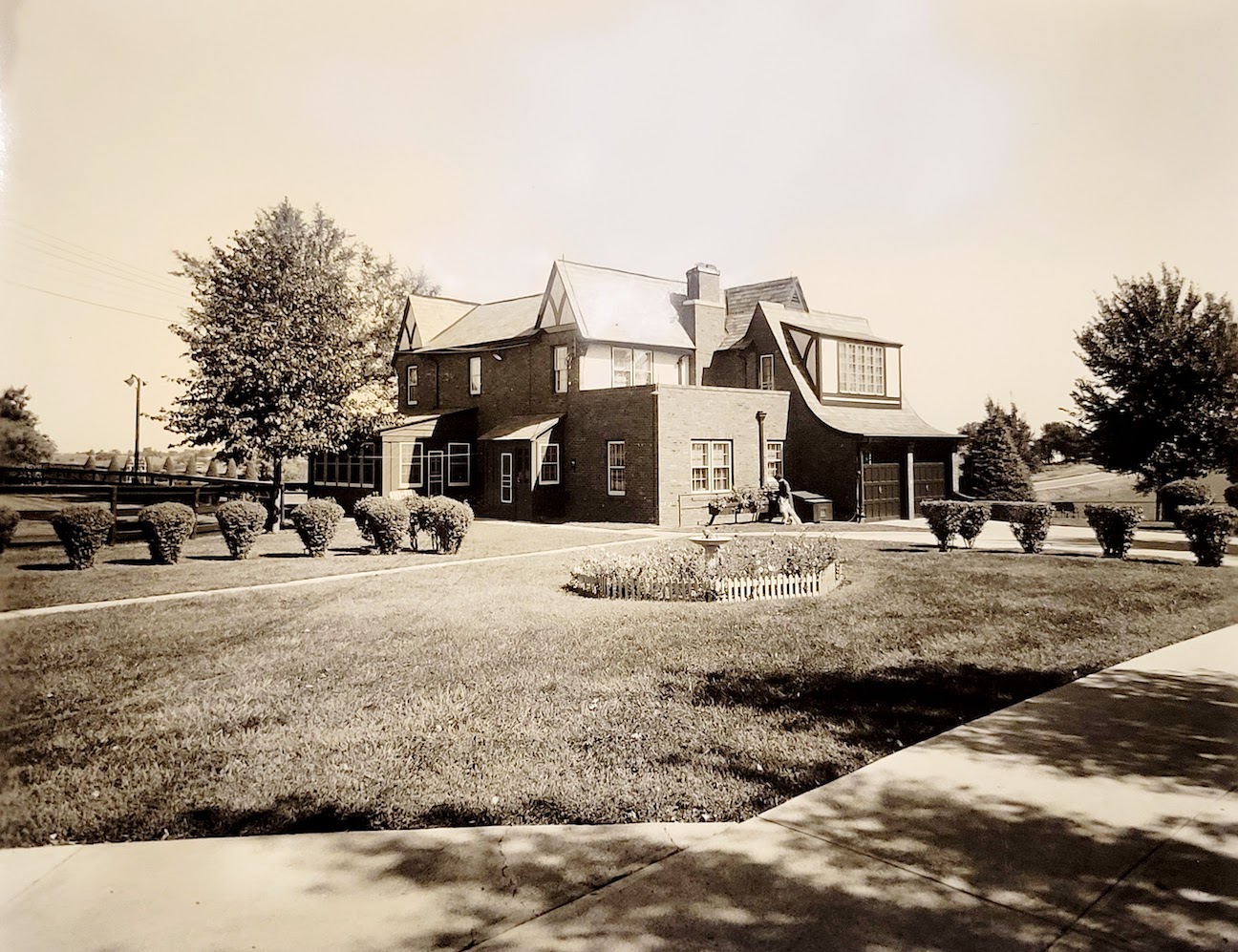
Camera faces north east angle.

The formal courtyard garden to the north of the home that we had suspected in previous aerials is much better than I dreamed.
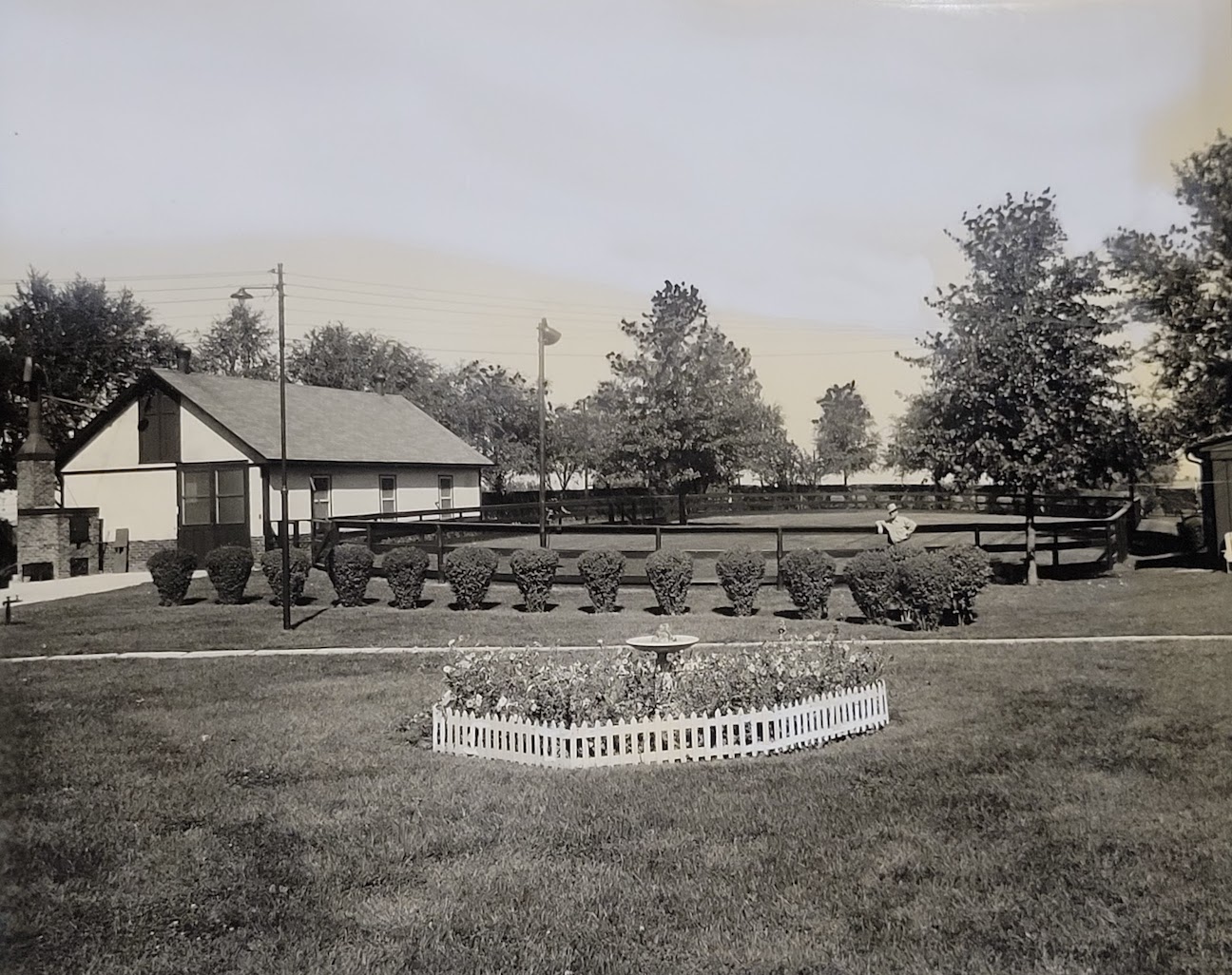
Horse corral was next to the formal garden. What I had always thought was the stable or barn looks like it was the “pre-war steakhouse” we had read about. Next to it is an outdoor girl or oven. The thing I had suspicioned as a kiln or an incinerator must have been the old summer oven.
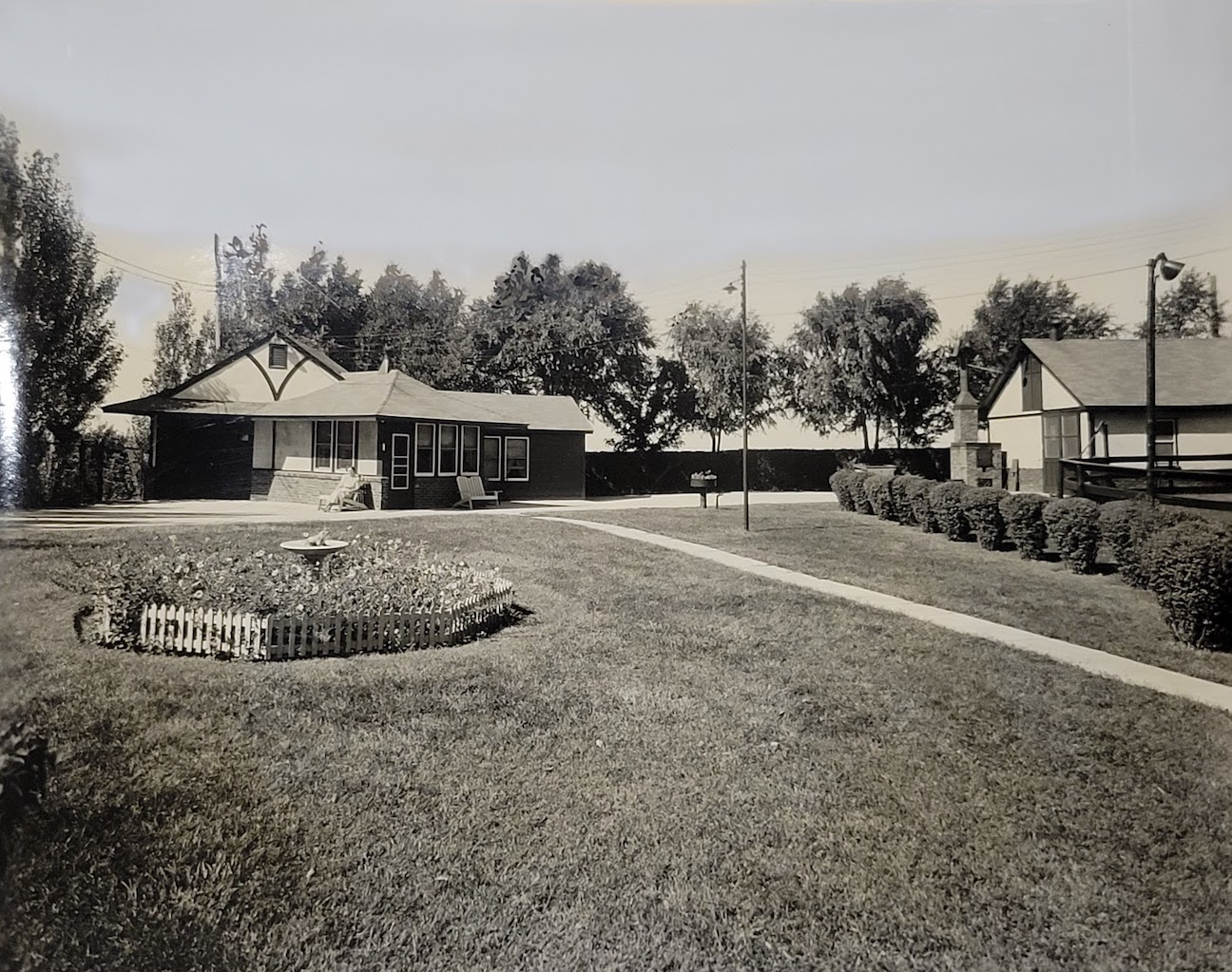
Detail of the garage and guesthouse in the far southwestern corner of the lot. So cute!

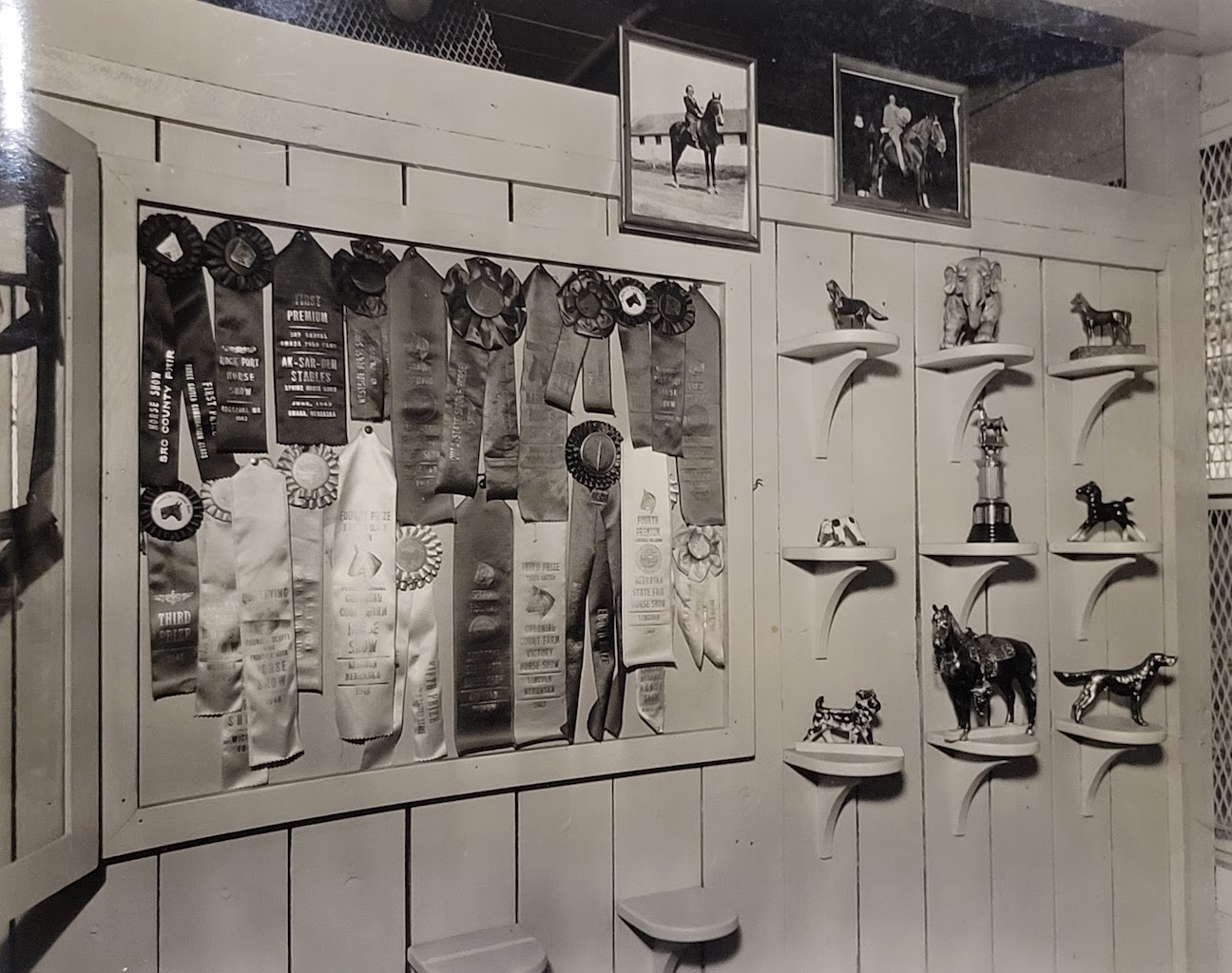
The trophy–pack room.
**Addendum of April 6, 2024**
This just in from neighbor boy, Will Fox, now all grown up: “These images of Esther’s house are fantastic!! Just as I remembered it! The last image taken from Dodge Street is the best! 96th & Dodge street used to be a 4-way stop with a flashing red light. Then in about 1972 Dodge got rebuilt, as you know it today, due to Westroads and increased traffic. I still remember when it was brick! It was 2 lanes each direction. Can’t tell you how many fatal accidents happened there, especially on Friday and Saturday nights with kids drag-racing. With my bedroom windows open on a summer night, we could hear the impact! The`56 Lincoln Mark II was—very exclusive car that cost $10K new in 1956.Esther bought Harry Humphrey one when they got married and he still had it when she died. It was in perfect condition and seldom driven. Someone probably got a bargain on it at the estate sale in 1982!
That old building in back has always intrigued me. By the time I was born, I think the Humphreys had long since stopped using it. Now the roof has been kind of patched just to hold it together. I can envision the “help” busy cooking in there for one of the parties Esther was known for. Back then, with nothing built around it made for an exclusive setting for sure.
There was so much about Esther Humphrey the neighbors never knew. She led quite the life indeed!”
Thank you, Will!
Let’s take a well deserved quick break before we spring into the next big thing.

Part Two
The Hilt History
The Thomas Hilt family purchased 412 North 96th Street in July of 1984. The original Greencrest Tudor was still intact, standing at 4,700 sq ft in addition to a guest house and a barn. Thomas Hilt was of the Hilt Truck Line family. Hilt trucking (HTL) was started by Thomas’s father, LeRoy Hilt. had been headquartered in Lincoln but had moved to Council Bluffs in 1968 when the area became focal point of their operations. Amalia “Molly” (Paul) Hilt and LeRoy Hilt were married in 1936 in Omaha. The couple had three children: Robert, Sandra and Thomas. In time, Thomas became president of the Hilt Truck Lines. They later sold the family business in 1988.
As it turns out, by the time Thomas and his wife, Norma, had acquired 412 North 96th, they were well accustomed to large, gorgeous houses with long histories. Thomas was known in some circles as an investor. The family had moved from the glorious Fairacres neighborhood, 6610 Davenport Street, to be exact.
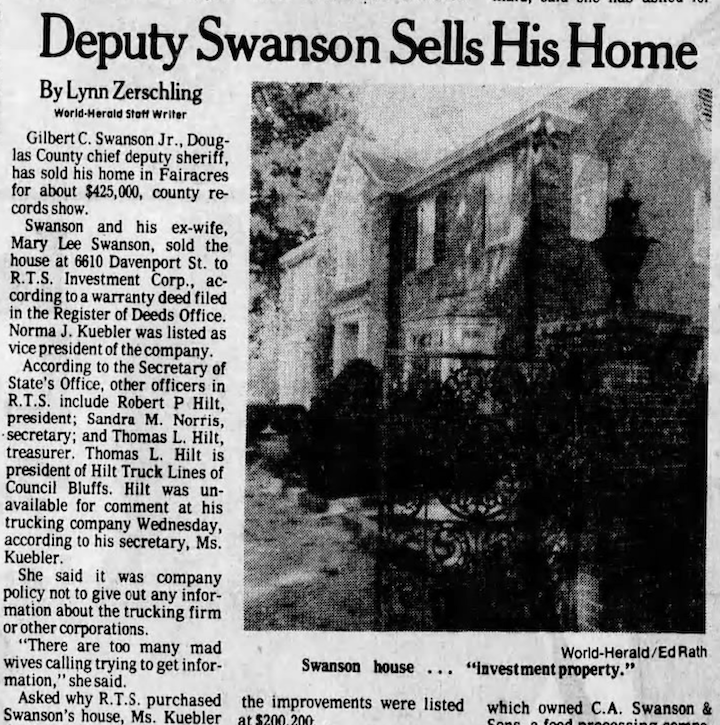
OWH. October of 1980.
R. T. S. Investment Corporation, comprised of siblings Robert Hilt, Sandra Hilt Norris and Thomas Hilt, made news with their purchase of the Gilbert C. Swanson Jr. house for an astounding $425,000 in 1980. Gilbert was heir to the C. A. Swanson & Sons food processing company. This was such a big deal at the time that the World-Herald called Hilt Truck Lines to shake down their secretary: “Why did R. T. S. purchase the Swanson house?” The secretary declined to be specific, except to say, “It’s strictly an investment property.” This level of movement, intrigue and confusion would follow the Thomas Hilts in their passion for Omaha luxury housing. It was all fascinating.
For more on the Swansons, check out my past investigation: I Want to Live in the Swanson Towers.

6610 Davenport. R. T. S. Investment Corporation leveraged the acquisition but Thomas Hilt and family lived in the home. In 1981 Thomas Hilt put in a building permit for the brick and iron fence around the beautiful property.
While the Hilts lived in 412 North 96th, still the Greencrest Tudor, it appeared to function as a family home through the 1980s. Their daughter, Jennifer Hilt, married Bart Wilkins in 1991, although I would find her name tied to the address off and on through the years. Perhaps they lived with the folks.

OWH archives. August of 1991. The couple both studied at Bible college, became ministers and now run the Flatland Group and Flatland Church at 4801 N 144th Street.
Over the years I would discover Thomas Hilt as CEO-President-Partner of a yet untold number of businesses. Many of these businesses functioned out of the 412 North 96th Street location. Tom Hilt Ministries, his own Christian ministry; Tom Hilt was a gospel singer-calling himself “America’s No. 1 Gospel Recording Artist;” The HomeMakers Inc., a construction-contractor company established in 1984; ARTicles Gallery, Norma’s art galleries, dealers and home decoration business; Homemakers Real Estate investments; World Gaming Concepts; 412 Bat Grip (wholesale bat grips); Custom Framing, a division of The HomeMakers; Flatland Group and Flatland Church—Evangelistic Outreach Ministries; They bought properties under the names of R. T. S. Investment Corporation and MPL Inc., a Nevada registered corporation owned by the Hilts and other entities. It was stunning. From what I’ve been able to knit together, the family utilizes these different, large properties extensively for educational, business, political and entertainment purposes.
The New 412 North 96th Street
In December of 1992 the Hilts filed a building permit with the city for a single-family dwelling for $143,700. I was surprised to find that the transformation of the Greencrest property happened that long ago. I cannot be sure why they wanted to tear down the Greencrest house, other than to create a showplace for Norma’s art gallery, to create storage place for the other Hilt businesses and to house their personal coach bus. I have also heard rumors of Tom Hilt’s large, impressive car collection.
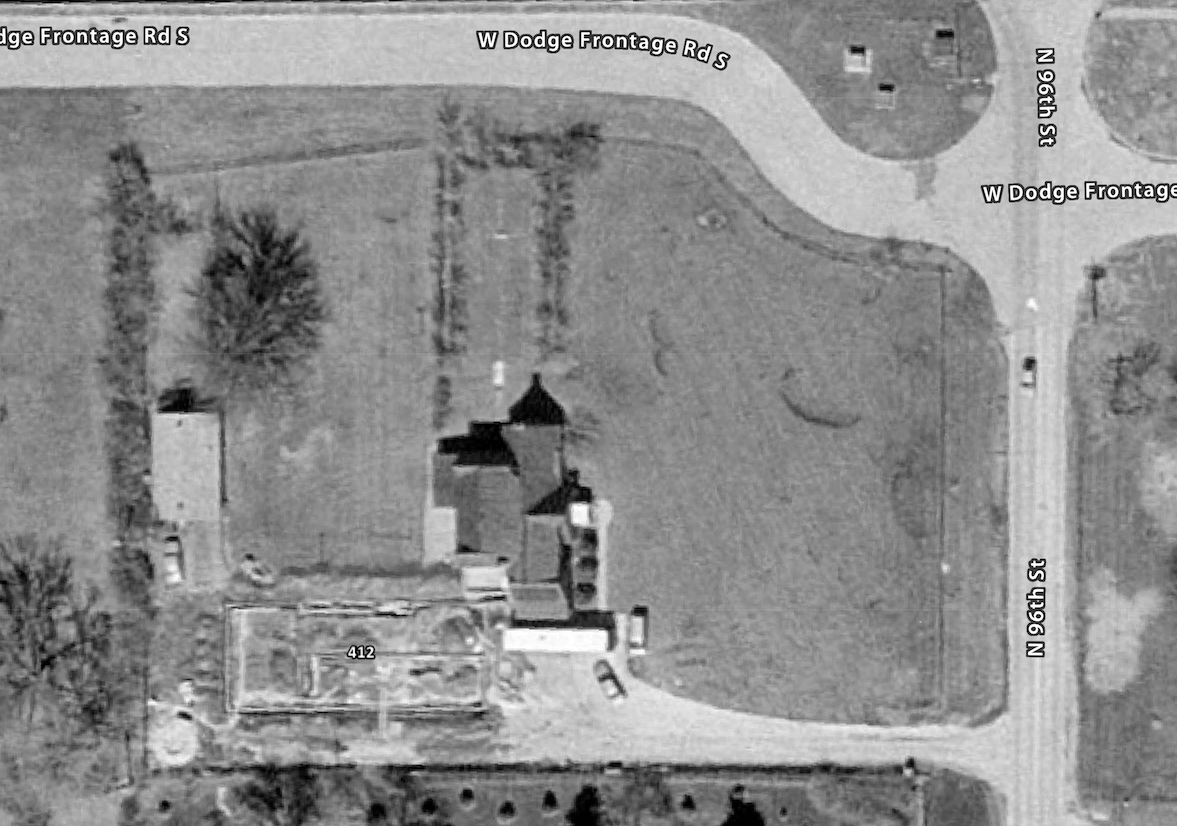
This 1993 aerial gives a great visual of the times. The Greencrest home is still standing. The foundation for the new home is being laid. The old barn/stable/steakhouse is seen on the far western edge. Photo borrowed from the DOGIS website.
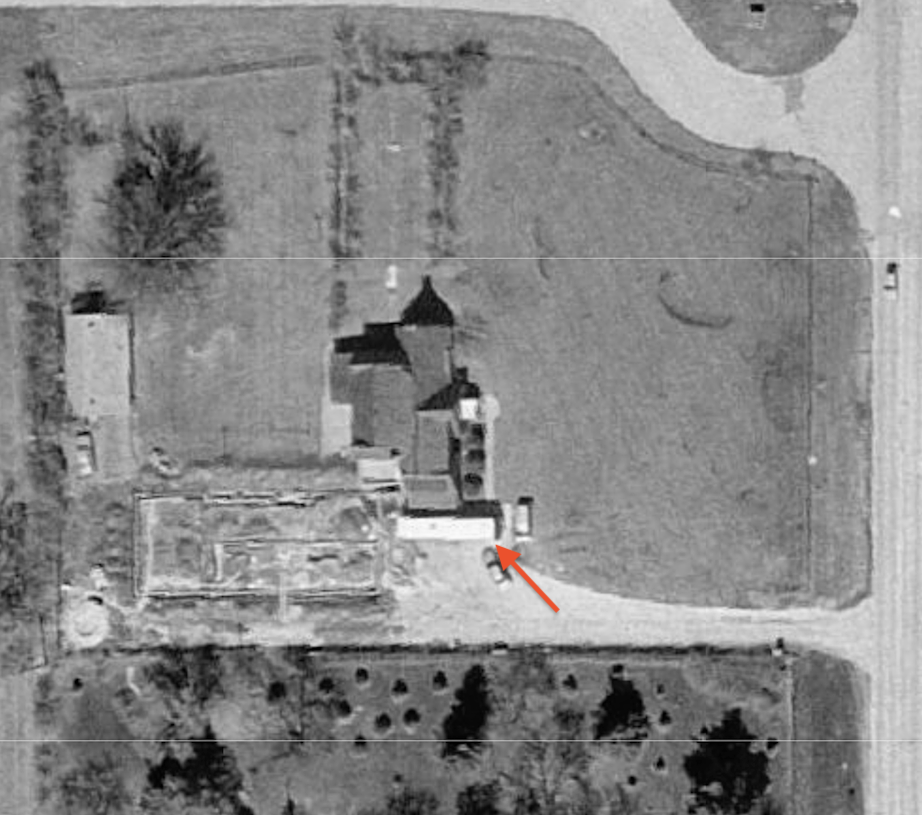
I forgot to note the large coach bus snuggly parked beside the house. I’ve got to assume it was for ministry travel, pleasure and potentially gospel concert touring. This bus would play an important role in the design of the new house.
I am of the belief that the massive house transformation that we now see on the property might have been built in extended periods, possibly because of ongoing issues with the city and permits. In 1994 “appeal charge for sewer service connection by Thomas Hilt, the HomeMakers 412 North 96th.” In February of 1996: “Appeal Planning Department notice to renew building permit, arrange for final inspections, complete demolition of existing dwelling and discontinue use of the new structure until final inspections are approved.”And in April of 1996 the Hilts entered another building permit on 412 N. 96th single family dwelling for an additional $160,500. The home is said to have been built in 1994 but it sounds like the Greencrest house was not fully demolished by 1994. Our was it the outbuildings that weren’t yet razed? Now those are photos I’d love to see.
**Addendum of April 4, 2024**
An anonymous neighbor recalled that the house was “rebuilt to store the owner’s RV because its visibility was an issue with the neighborhood.” This clicked with me because I don’t remember the massive garage always being a part of the design and it might be accounted for by the second big building permit in 1996.
The Hilt family has touted Purdy & Slack Architects with the custom design of the 412 North 96th Street home. I reached out to the architecture firm and have not yet received a response to date. Purdy & Slack website
The new 412 North 96th Street was reoriented to face the West Dodge frontage road. It was also wedged back into the southwestern-most corner, possibly for privacy reasons and for ease of backing the large coach bus into the garage. Custom designed by Prudy & Slack architects. Almost 5,000 finished sq ft building including elevator, garage space for 10 vehicles. two fireplaces, granite hard surfaces, Brazilian Cherrywood floors, volume ceilings. Three furnaces. Zoned development reserve for possible additional structures.
**Addendum of April 4, 2024**
An additional neighbor, who wishes to remain anonymous, remembers when the new 412 North 96th Street was built. Rumor was that the placement on the extreme southwesterm edge of the property was done after the neighbor next door (the late Dr. Jay Parsow and wife Margo) objected to the proposed structure. The neighbor wondered if there might be a record of the objection being made with the planning board. To his memory, the neighborhood objection was that the 412 North 96th Street design was thought to be out of scale with the rest of the neighborhood structures. The Parsow house and many others in the area were low, wide post-war stone ranches. Intentionally building the new 412 so close to the southern edge in that huge yard was “just to spite the neighbors.” Could this be corroborated with old city planning board minutes of objections from the Parsows and other neighbors?
**Addendum of May 13, 2024**
I just received word from an authority with the city, regarding the purported neighborhood objection. Cliff Todd, City Planner, Omaha-Douglas County Address Coordinator shared information or lack of from the board cases.

So, to date, no issue with the neighbors over the newest structure, but there was opposition over the Hilts having an interior decorating business within the historic home. A rezoning fight the Hilts would later win in their newer constructed house, by the way. What is more interesting to me, within this document, is this phrasing:
“Poor platting – buildable area wasn’t considered at time of platting so does not allow a structure compatible with the quality of the other homes in the area which results in a hardship; also, terrain of the lot is a problem.” Strange.
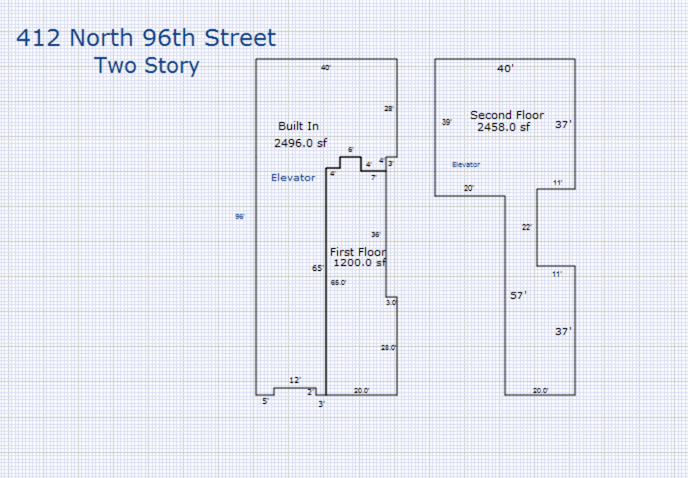
The Douglas County Assessor’s very vague floor plans. Just to give an idea of the coach bus garage on the eastern side of the house and the garage that is on the southern side.
The eastern elevation with the turn arounds for the Hilt bus.

The bus garage interior, facing east through the massive door we’ve all seen. Impressive.
The southern garage doors with gargoyle light.
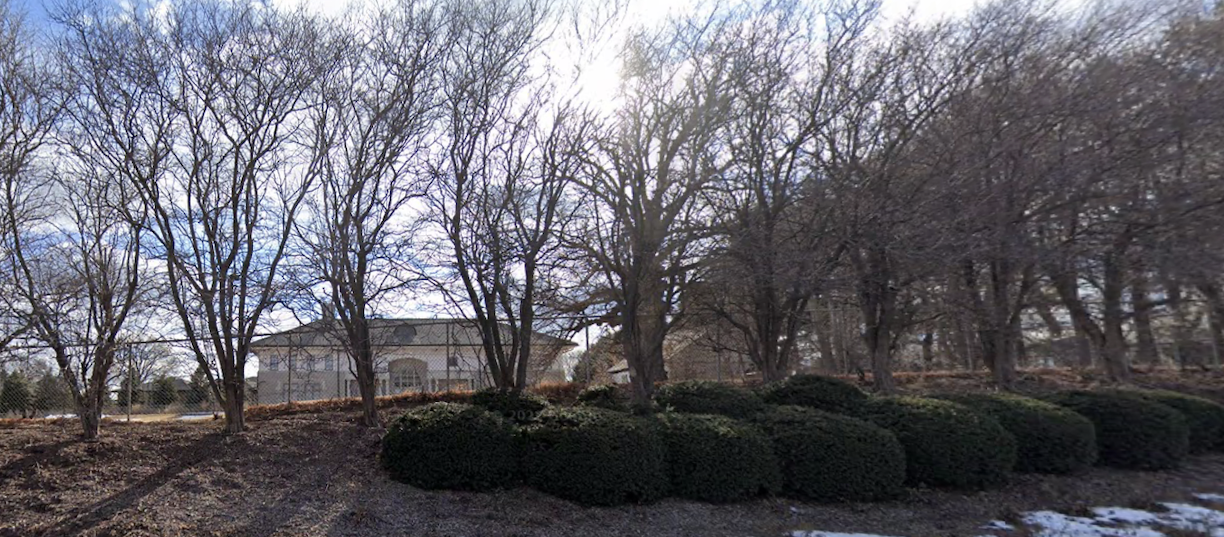
In time a berm along the northern perimeter was created for privacy along the frontage drive and from the larger West Dodge Road.
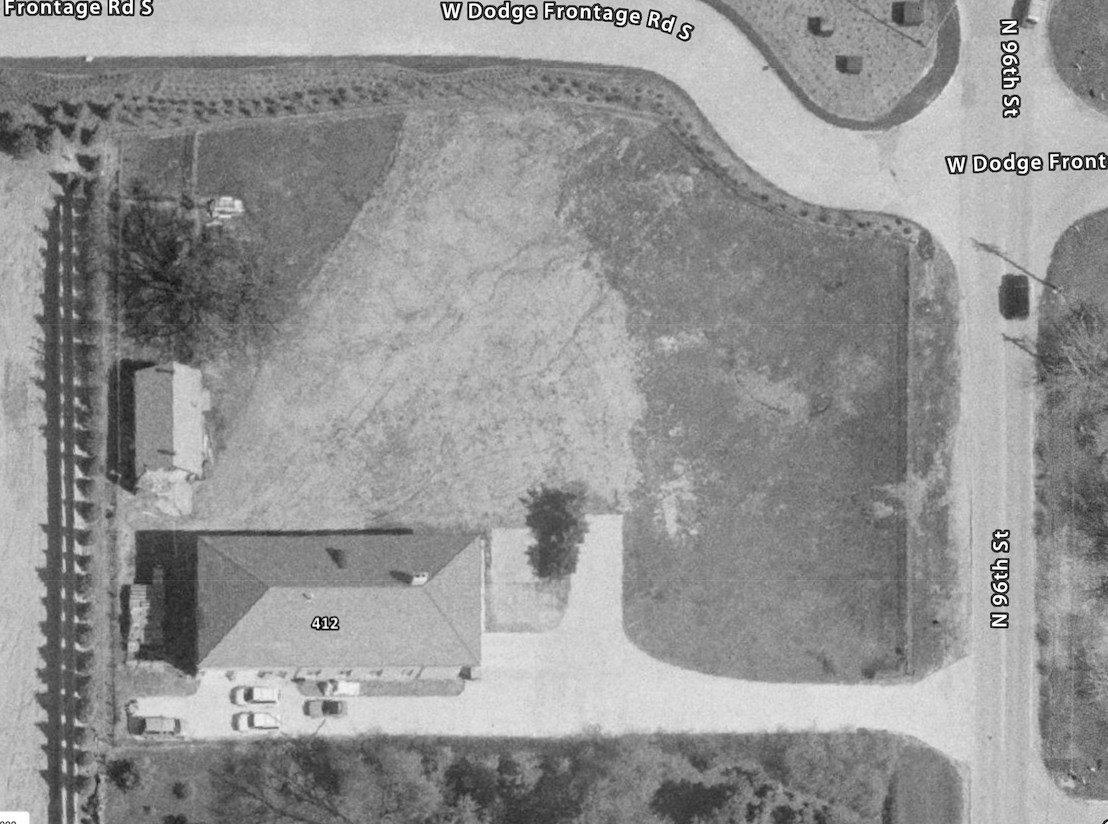
In 1998 this is how the property looked. Still looked like construction in the lawn.
It was all kind of odd. Symmetrical. Formal. Cold. Grandiose. Everything I like in a certain mood and yet this seemed unfinished. Facility-like. Was it really a facility or business just pretending to be a house?
Or were they reaching for this and something happened?
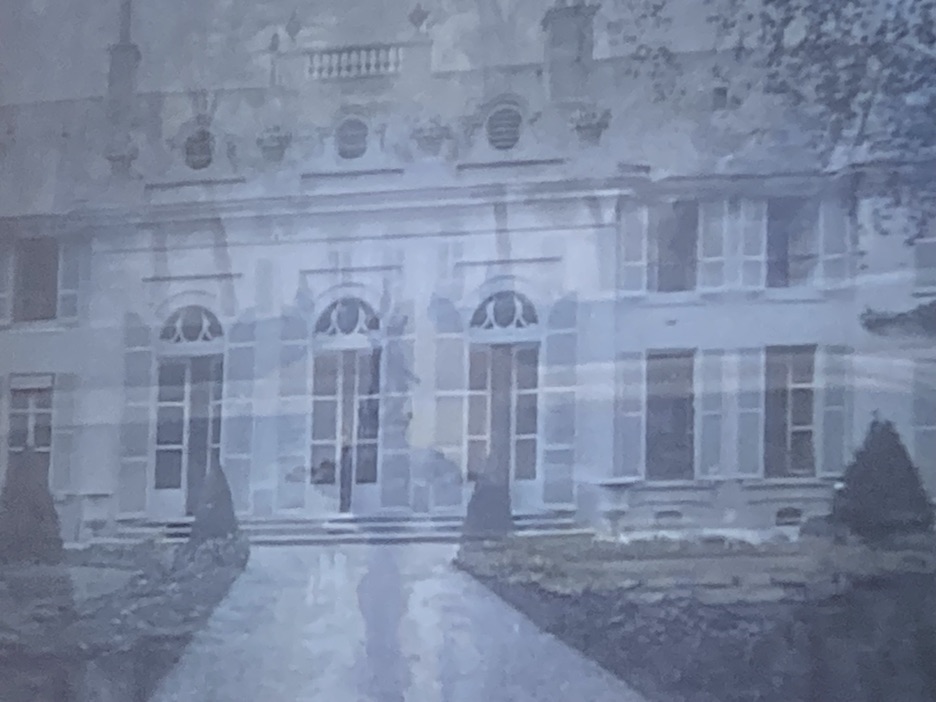
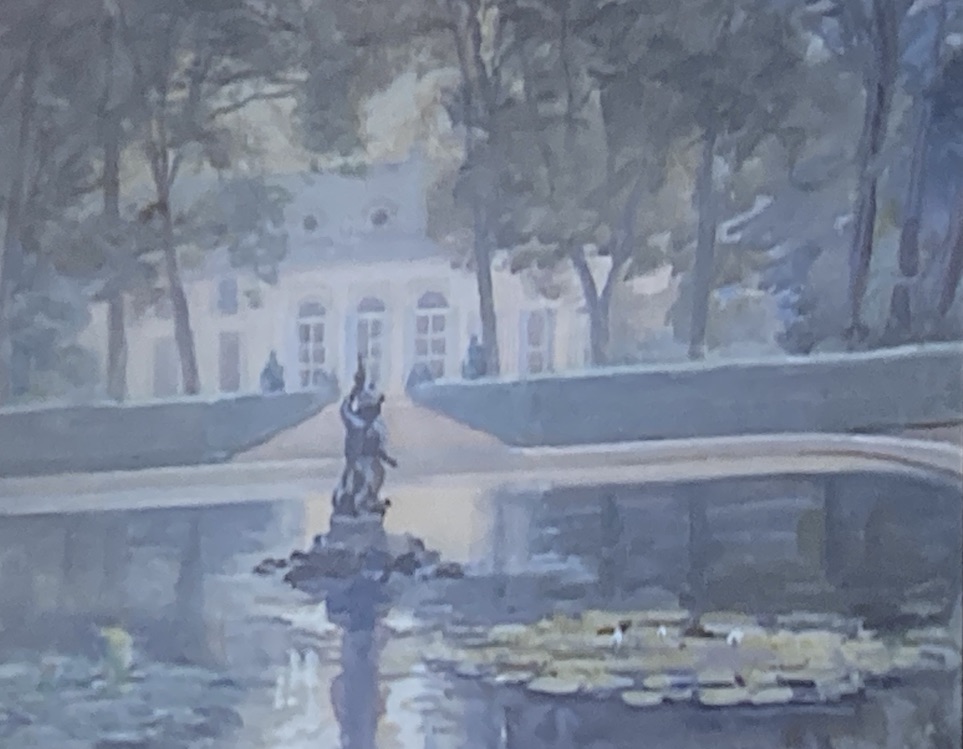
The Witherspoon Mansion
Thomas and Norma Hilt purchased the Witherspoon Mansion in June of 1995 and soon after left 412 North 96th Street. This was surprisingly right in the middle of 412 ‘s final touch ups. 412 North 96th, primarily, was serving as Norma’s ARTicles Gallery but had been considered the Hilts’ sometimes residence. The Witherspoon Mansion purchase agreement logged MPL Inc., a Nevada corporation owned by the Hilts, as the buyer; the Hilts paid $1,854,200, according to the Douglas County Register of Deeds. But before the sale was completed, the name changed to Homemakers Inc., the Hilts’ contractor business. The purchase agreement also included $604,200 of personal property, including curtains, drapes, patio furniture, appliances, outdoor statuary and security, swimming pool, tennis court, bowling alley and fireplace equipment. The 52 room, 18,450 sq foot house known to all as The Witherspoon Mansion was situated on 4.7 acres at 9909 Fieldcrest Drive. I won’t go too far into that home’s history as I’ve got an upcoming investigation out shortly that delves deeply into this story.
There was no one more shocked than I to find the connection between these two homes.

1968 Witherspoon Mansion at 9909 Fieldcrest Drive.
In 1996 Thomas and Norma Hilt went through an extraordinary series of events, adding to their already bigger than life lives. I will not attempt to explain this one–I will just let you read it for yourselves.
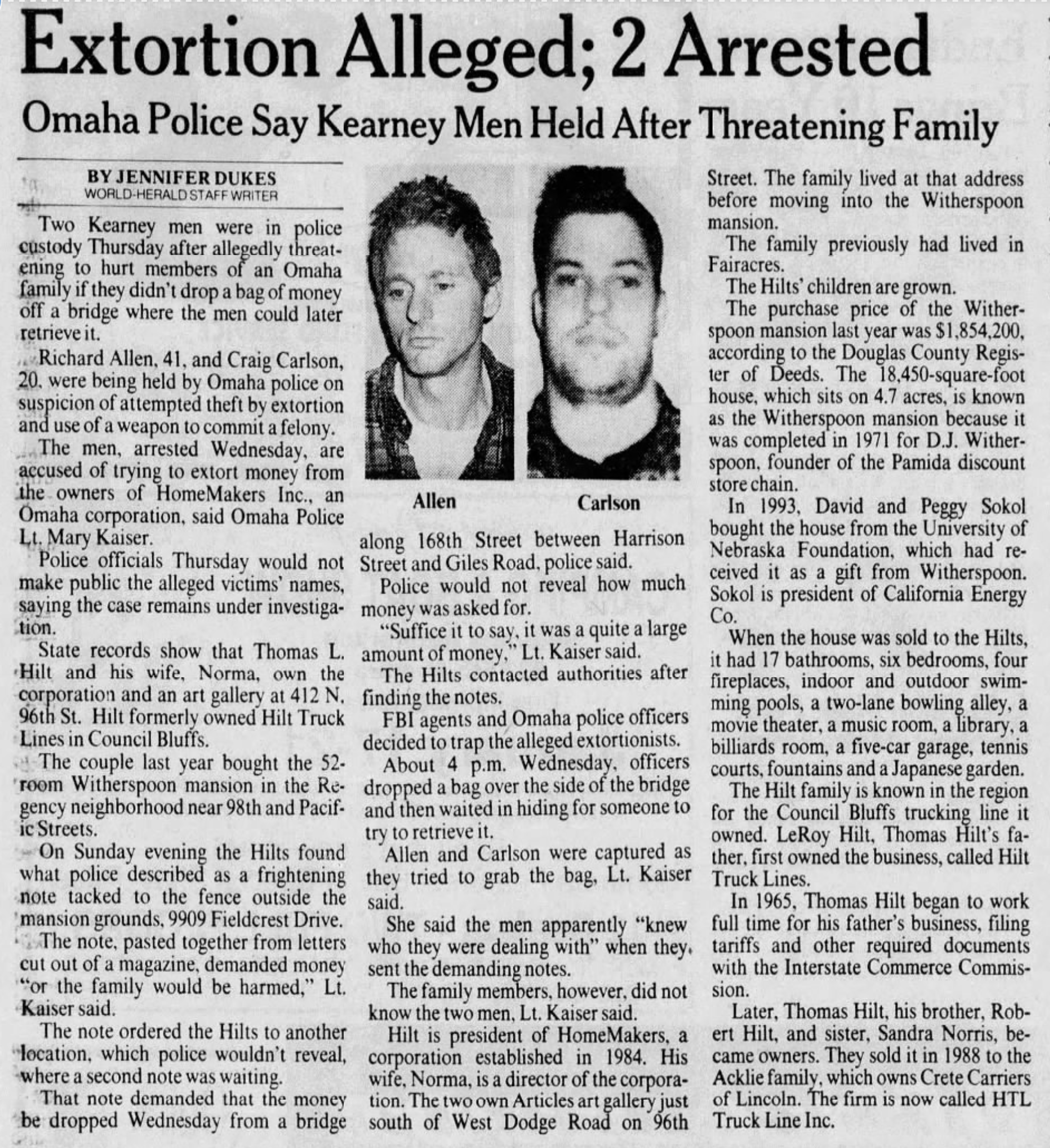
It was a very flattering account of the Hilts. In future articles it appears Allen and Carlson were targeting the Hilts because of their Witherspoon Mansion residence but possibly because of the HomeMakers Inc and ARTIcles art gallery?
I was surprised, as I often was during this research to find that in August 2007 the OWH reported that the Hilts ‘had used the Witherspoon property for political gatherings and other events,’ but that they lived elsewhere. In the 2000s, it seemed easy to find Thomas Hilt battling then-assessor, Roger Morrissey over valuations and subsequent taxes. The County Board approved a reduction for another of Hilt’s protested properties, a home and art gallery at 412 N. 96th Street. The Assessor’s office had increased the valuation on that property from $348,700 to $777,500 this year. After Hilt’s protest, the board approved the hired appraiser’s recommendations of $713,100.”
By 2008 the Hilts put their Witherspoon Mansion on the market listed for nearly $2 million by CBS Home Real Estate.

Another battle in 2008. OWH archives.
Sadly in January of 2009, the former Witherspoon Mansion burned down. Omaha and the Regency neighborhood was devastated to lose this visual anchor of West Omaha. I cannot imagine how the Hilts must have felt. Thomas Hilt donated the property to the Flatland Group, his daughter and son in law’s ministry. The World-Herald reported on the hazy exchange. “The property went to a local church the Hilt’s supported, the Flatland Group. The church had built up $750,000 in debt, and was looking for a way to pay it off. After several inquiries, the church got an offer for $1,025,000. The money, it was all there, but the new owner was nowhere to be found. ‘I always went there, unlocked the gates, and then was asked to leave. I was not to know who was buying the property, and I still don’t know,’ said realtor Stoneburg. ‘Nobody knows who the new owners are, because they did everything through the power of an attorney – Mr. Gary Gotsdiner, who’s law firm represents a long list of clients including First National, Mutual of Omaha, and Union Pacific. Mr. Gotsdiner refused to tell us who the new owners are, and more importantly, what their plans are for the property. All I know is the property sold– the rumor is, it could be divided up into 3 or 4 lots, sold off, and the person who bought the property will build on one of those lots – I’m not sure if any of those are even true!’ said Stoneburg.”
The Hilts Leave 412 North 96th Street
In the following years the Hilts continued to buy and sell properties in Omaha. Some were multi-million dollar properties. The Hilts had built a new home in Elkhorn and a $2.7 million dollar home in Omaha. They also have homes in other states. The HomeMakers and their accompanying businesses move along with them. Thomas Hilt and his wife, Norma, have continued to push back about valuations on all of their properties, at times seven parcels in a year. They are absolutely fascinating to me.

I took this one September 2, 2015. If you look closely the address read “ARTICLES.” ARTicles Art Gallery continued on at the mysterious 412 North 96th Street. In June of 2013 the Hilts had a “gigantic downsizing sale (96th Street). Antiques, Art and collectibles along with garage and household items. Many items from former Witherspoon Mansion.” Another large “garage sale” was held right before the Hilts sold off their 412 North 96th Street parcel in September of 2016. What follows are the real estate photographs taken by CBS Homes.
**Addendum of April 4, 2024**
Jeff Hutcheson and Steve Elliott had a cabinet business partnership under the name of S & J Custom Cabinets in Council Bluffs. The team was hired by Tom Hilt and built most of the cabinets for the Hilt house. “It was a very large project for a small two-man cabinet shop. Super nice couple to work for!”
412 North 96th Street offered 4,954 sq ft with only two bedrooms, 3 1/2 baths and a whopping 10 garage spaces; it would be a challenging arrangement for most families. The Hilts began marketing “Building and land available for lease. Building contains high-end living quarters/executive suite as well as substantial climate-controlled storage space with oversized garage door. Many possibilities for this unique property – special use permits are allowed.”
The real estate photos made it hard to conceive of as a real home–a place that a family would want to sleep. I found it was used for gatherings, an art showplace, among other things.
For those inquiring minds, ARTicles Art Gallery moved to 4209 South 94th St.
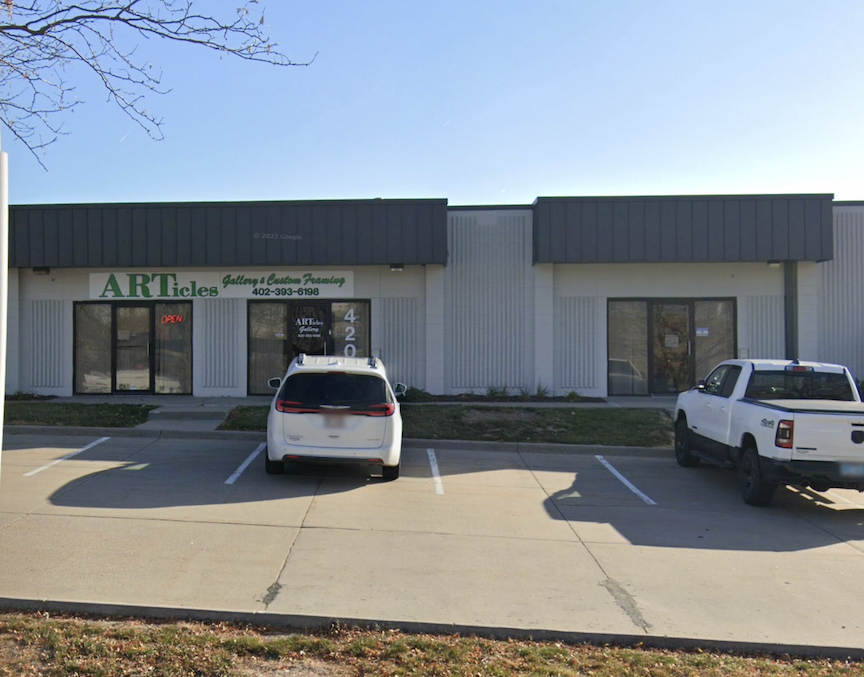
A video I created of the Greencrest Acres over the years using the historical aerials. To play, press the white arrow.
The New Owner, More Questions and a Few Clues
The Hilts sold to a local businessman in September of 2016 for $750,000. As the mystery continues, I would discover that this new owner also has a proper house in the Regency neighborhood. In July of 2022 the newest owner took his name off of the 412 North 96th deed and logged the house under a new LLC. Meanwhile the Omaha City Directory persists in the HomeMakers business operating out of the 412 North 96th Street house in as recent as 2023. I wondered if there was a deeper connection between the new owner and the Hilt’s HomeMakers’ business or just a mistake in the directory? It wouldn’t be the first time. The new owner does have a business that could be said to need numerous garages, so maybe that was the early draw. At this juncture, I believe this property is just in holding until an opportunity comes along. This would be a great site for multi-family housing, a huge mansion turned back toward 96th Street or any number of ventures, if the neighbors would oblige.
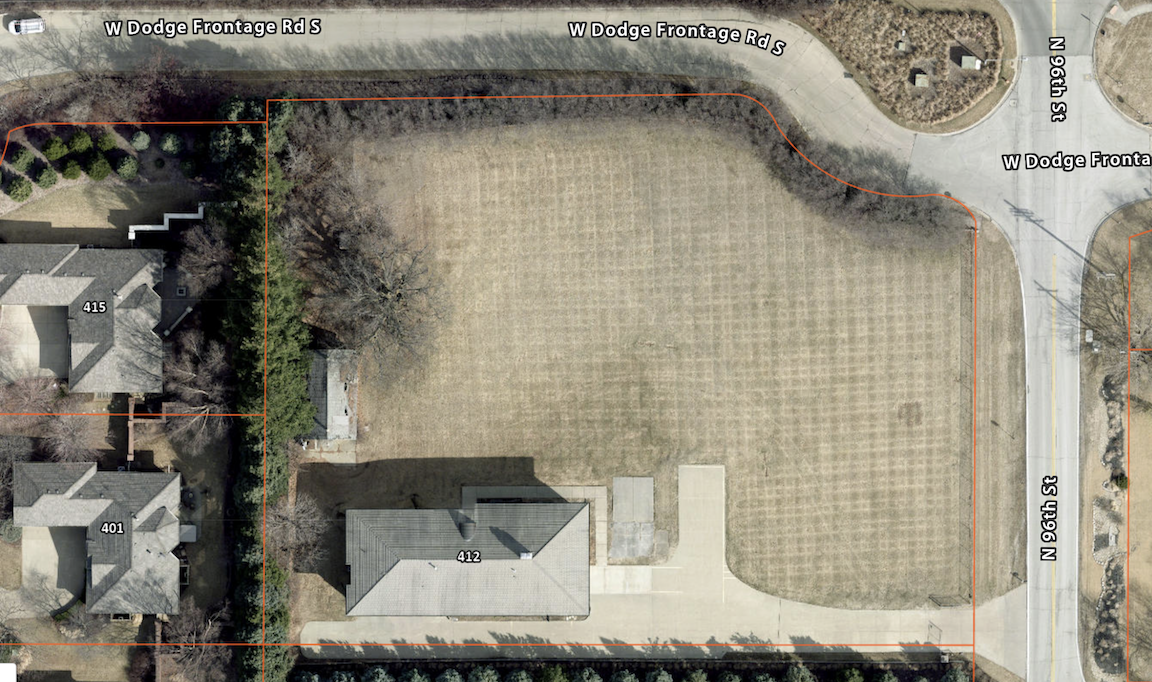
The most cut back, pruned parcel in all of Omaha. Mr. Cassette calls it Prairie Brutalism landscaping. Over mowed, as if to keep the neighbors and the city away. Nothing to see here, folks.

Because Esther Green Humphrey had been a ceramicist, I dreamed that the curious structure beside the barn was an old fashioned kiln. Have you seen in? I also thought it might have been a sculpture for the longest time, in fitting with both Esther’s interests and ARTicles.
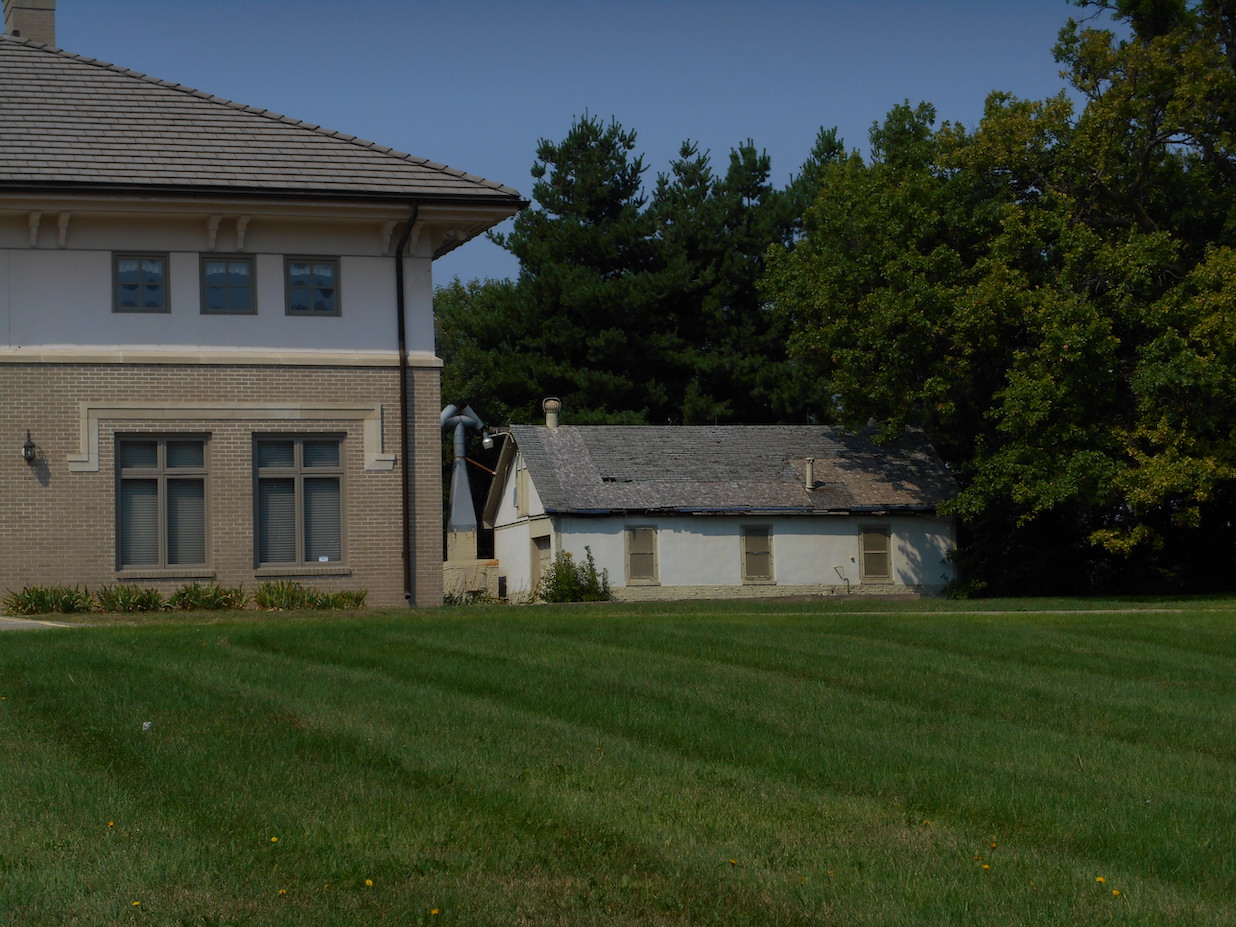
See it to the south of the old barn-steakhouse?

There is is. I was fascinated. Because some have giggled that the large house could possibly be a crematorium, I had also wondered if this was the incinerator where the bodies were put. But then I surmised it might be a private residential incinerator back from when 412 North 96th was on the outer limits of Omaha. Or maybe the Greens wanted to avoid paying for regular waste collection service. It may have been the only way for rural folks out of Omaha. Sidenote– I couldn’t help but notice that this building has power. This very well might have been the Greencrest guest house. Now having seen the additional historical photos, I believe this building was the original “steakhouse” and this was the original outdoor summer oven.
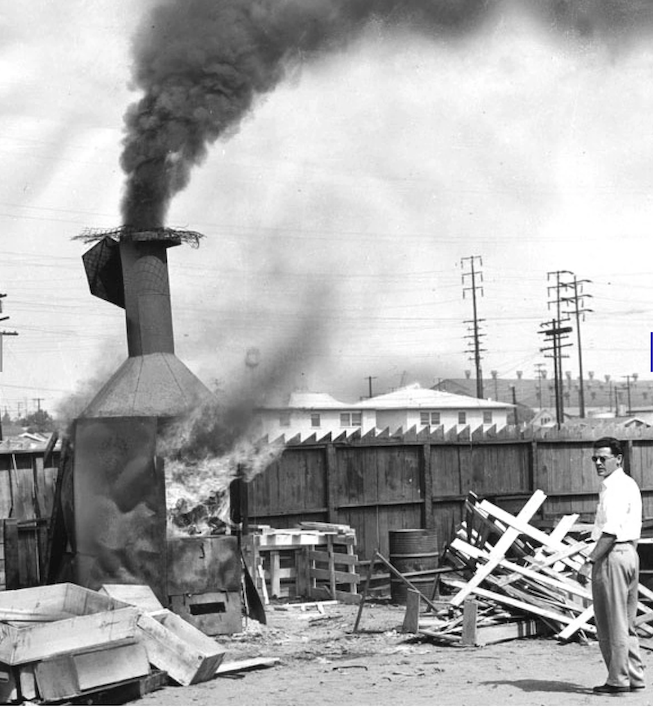
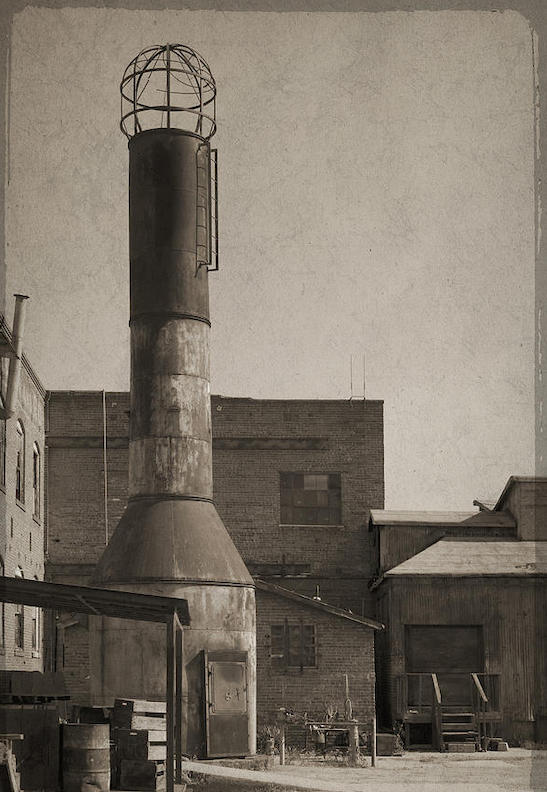
Other examples of incinerators from yesteryear that seem to fit the bill. Thoughts, sleuths?

I know a horsewoman I am going to dream of tonight.
Now I really must get back to the current investigation at hand.
As always, keep those peepers popped and keep those clues coming.
Miss Cassette
Do you have an insatiable itch and need to know even more about the area? Look into my earlier investigation: Mysteries of Omaha: 9301 West Dodge Road.
This article is dedicated to my dear boy, John Mountjoy and Greencrest Acres.
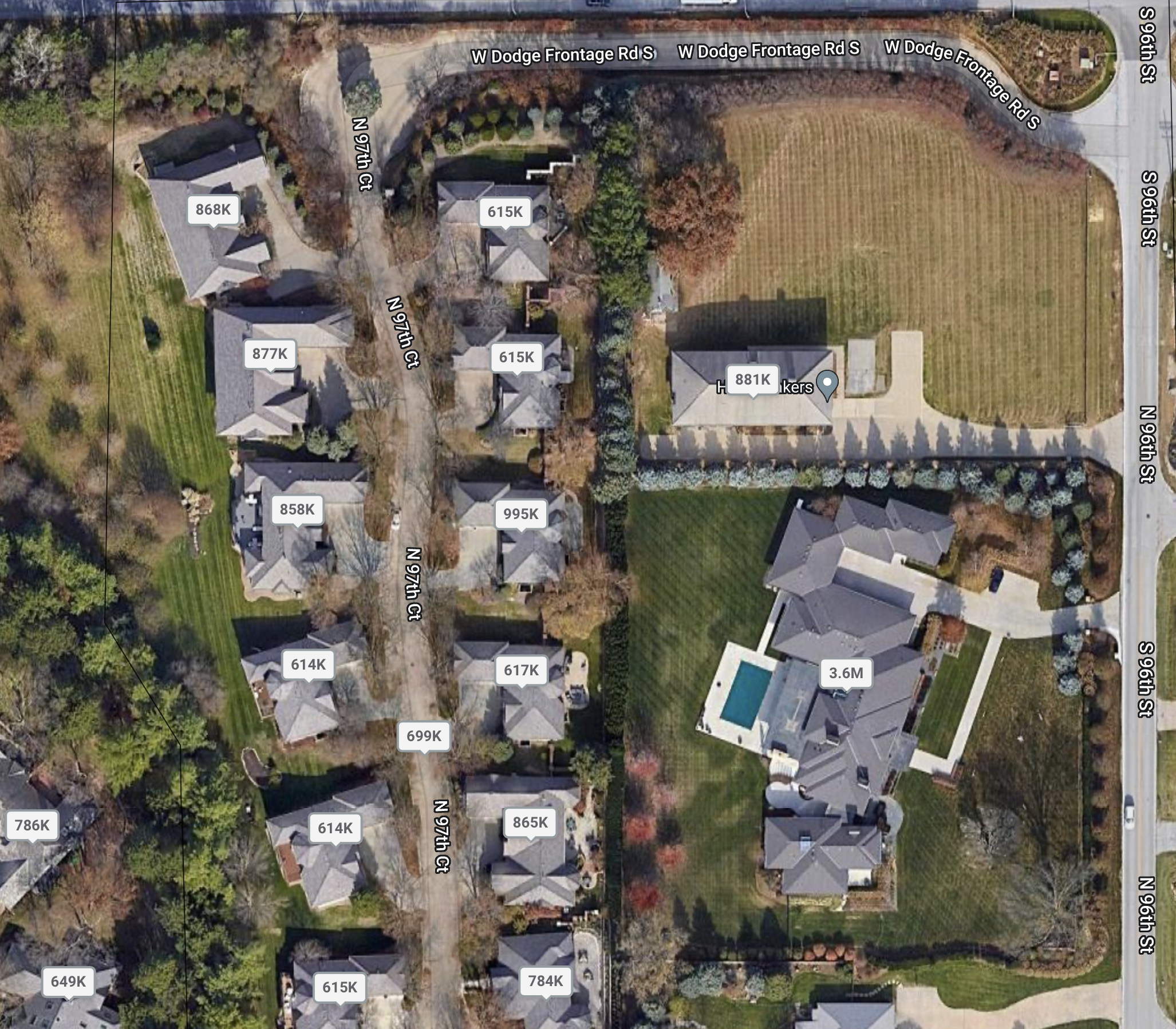
By 1998 the Regency Park Vistas were coming into view. Regency Park Vistas is a prestigious gated community located off 96th and Dodge Street, just west of our 412 North 96th Street house. Once the Green’s bridle path, this gated community features a private setting with 14 detached residences ranging in the $500,000 to $1,000,000 range.
I welcome your feedback and comments on this fascinating Omaha landmark. Let’s hear it for 412 North 96th Street, old and new. Please share your additional clues to the story in the “Comments,” as we know more together. Everyone would love to read what you have to say and it makes the sharing of Omaha history more fun. You can use an anonymous smokescreen name if need be. We want to hear from you.

Taken September 2, 2015.
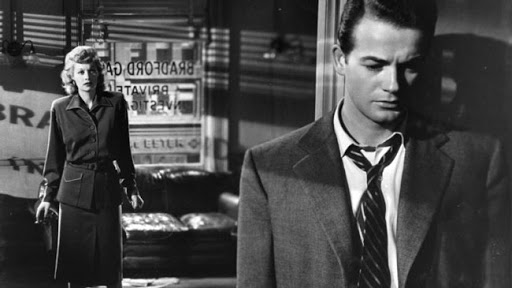
You can keep up with my latest investigations by joining my email group. Click on “Contact” then look for “Sign me up for the Newsletter!” Enter your email address. You will get sent email updates every time I have written a new article. Also feel free to join My Omaha Obsession on Facebook. Thank you, Omaha friends. Miss Cassette
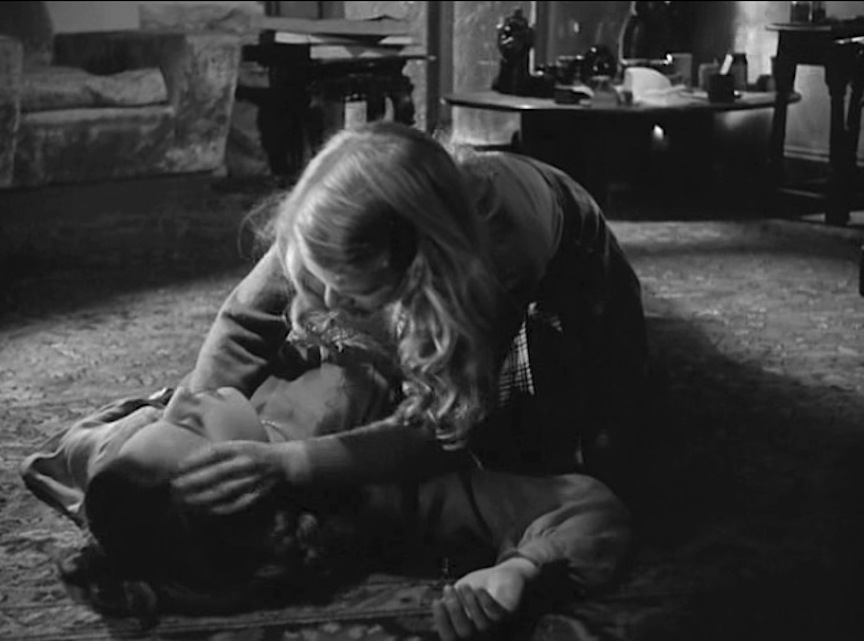
© Miss Cassette and myomahaobsession, 2024. Unauthorized use and/or duplication of this material without express and written permission from this site’s author and/or owner is strictly prohibited. Excerpts and links may be used, provided that full and clear credit is given to Miss Cassette and myomahaobsession with appropriate and specific direction to the original content.
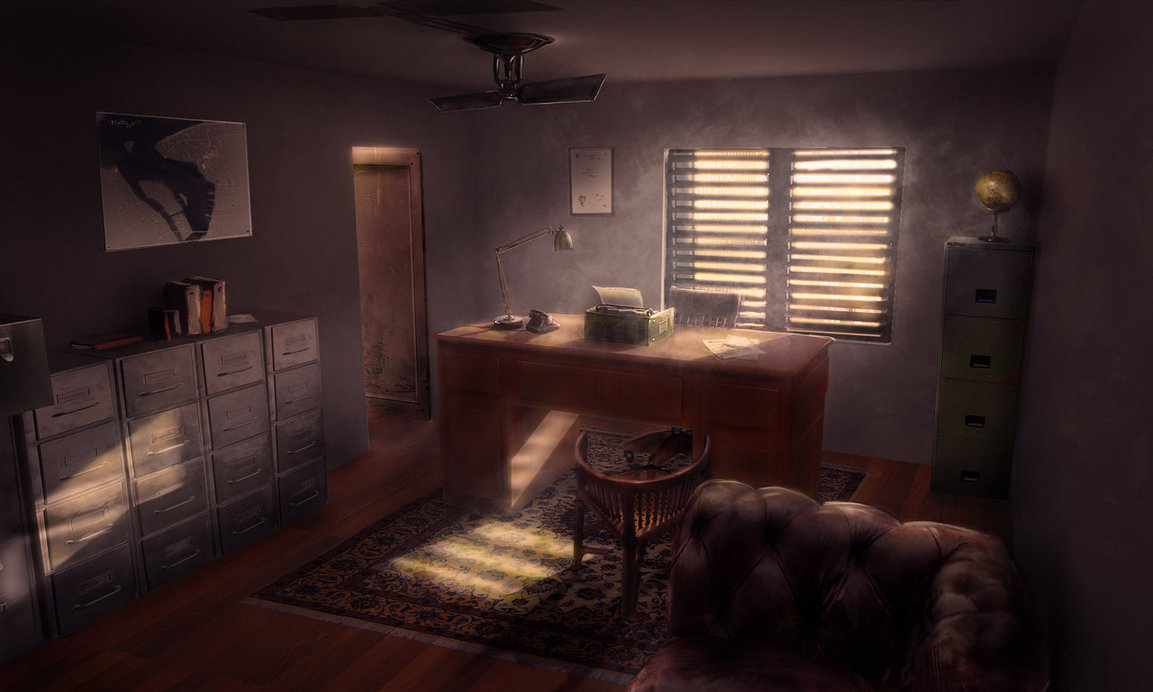
If you are looking for more architectural and Omaha history sleuthing fun, ask your local or bigbox bookseller for my book: My Omaha Obsession: Searching for the City. Also available everywhere online. Thank you.

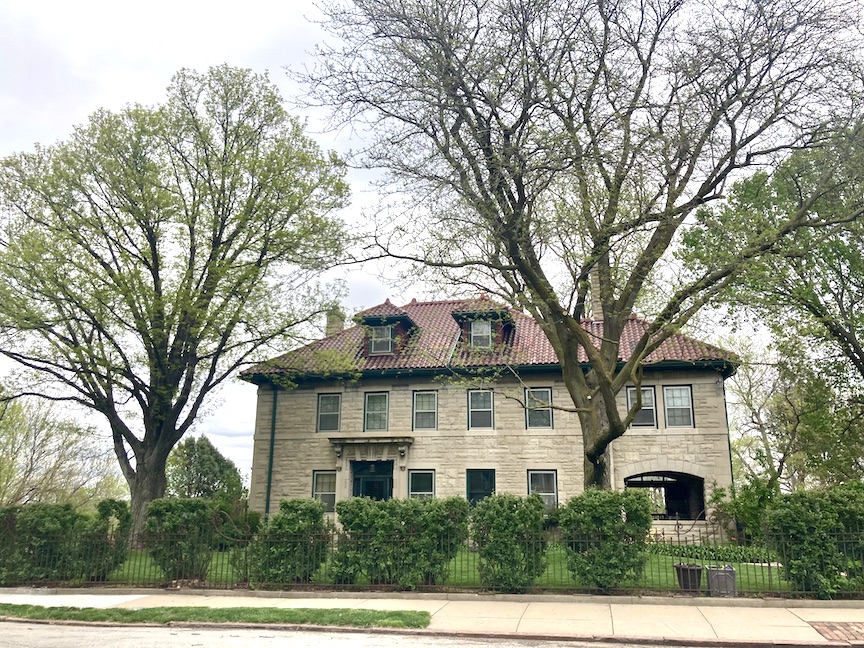
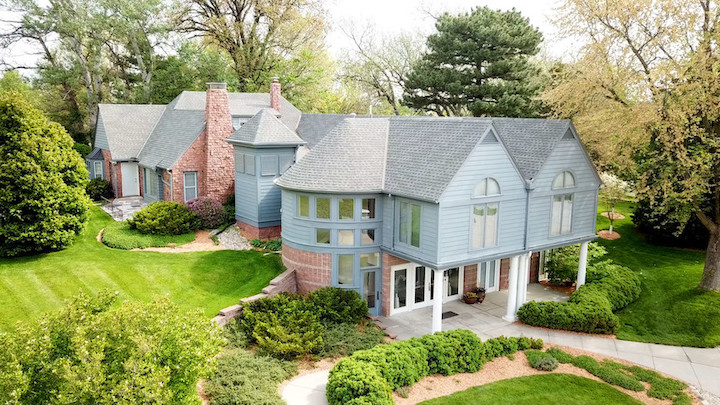
Fascinating article. Always wondered about that area – 87th to 96th and Dodge. I had a connection to one of the houses in that area growing up. It had an interesting history also. Great job!
Thank you, Sandy! If you think of it, drop me a line and let me know about the house you remember. Take care.
What a cinematic journey! So much to comment on but where to begin!
It’s amazing how so much of the history of Omaha has vanished, or gets covered over in some insipid veneer. The artifacts of history mere photographs.
I believe that’s Lucille Ball in a still from The Dark Corner (1946).
I fondly remember seeing Rocky Horror at the Admiral. I’d love to know if and where that brilliant marquee sign resides now. It’s as wonderful and iconic as the Broncos neon cowboy on Leavenworth. (Pray that landmark survives the future). The sad strange thing about the Admiral then, they had divided it with a wall down the center to create a duplex theater… with poor sound proofing. It was a weird environment I had always hoped it would someday be reinvigorated. Would a small movie house succeed today with the popularity of the Blackstone district? Maybe FilmStreams would have a satellite location there?
The history surrounding the home couldn’t be more bizarre.
From a rather charming minimalist English cottage with an art deco interior (maybe a stretch, but a little reminiscent of architect Paul Williams and Hollywood Regency style) to a 1980s brick and Dryvit covered faux Italian palazzo, lol. The gentle early way of life this story illustrates will never return. Well, maybe in the movies or a tv series, Greencrest Revisited?
If you love movies, it’s easy to imagine Mary Haines entertaining The Women in those deco interiors, her maids gossiping in that linoleum kitchen, and watching the Witherspoon Mansion fall to an inferno in the vein of Hitchcock’s Rebecca.
Once again, I love everything you have written. I don’t recall ever having gone to the Admiral, unless I went when I was very young but I do remember my father driving me and my gal pals by to watch the people who lined up for Rocky Horror–as our own children’s entertainment. I am grateful that I had parents who encouraged me to look around and take in the view! As always, thanks for understanding what I’m trying to do here.
The article mentions my aunt, Madonna Carroll Matthies. I am interested in how the author would have known of Aunt Donna as a young working girl and also of her longevity. I would imagine the Greens had various household workers, and I hope there was something special about Aunt Donna that made her worthy of mention.
Hello! What a treat to hear from you. As I mentioned, I just found her listed as a servant at the house in the United States census. She must’ve been the first working girl that they had at the new house. But I did not track her history with the Greens past that mention. Please feel free to share anything you would like.
The article mentions that Donna went on to marry, have children and live to age 95 … all correct … which made me wonder if you knew someone who had kept in touch with her over the years. I will mention that Aunt Donna was an accomplished pianist. She spent some years in a nursing home where she continued to play and entertain the staff and residents well after her hands were quite crippled with arthritis. A number of the staff attended her funeral, even though it required a long drive to the city where services were held. A lovely tribute to Donna.
What a life. This is so lovely to hear. It appears that there was always a piano in Greencrest. No I did not know your auntie or anyone who knew her. As a history researcher and writer, I am accustomed to looking into people’s lives in order to give a slight view into their time here on earth. Thank you for sharing about her talent as a pianist.
Fascinating! I have wondered about this building for many years. I very much enjoy your writing!
Thank you, Lesli. It means a lot that you would take the time to share this.
I tried pulling the address up on Google Street View, but the image is blurred out. Google usually only does that for places like abused women’s shelters. Curiouser and curiouser…
I saw that too. It’s been that way a while now–blurred that is.
Greetings Ms. Cassette,
You have touched part of my childhood in this fascinating article! You see, I was born and raised just SE of 412 N. 96th st. on Davenport, and now own that property. I met Mrs. Humphrey as a kid when I had a paper route, and always found her to be very gracious and friendly. Mr. Humphrey, not so much. While the property was always gated that I recall, in later years the gates were left open during the day. I would ride my bicycle up the driveway just to see what the property consisted of. (To a 9 yr old kid full of curiousity, this was a big step!)
I remember the estate sale held there in 1982. I purchased a couple bedspreads there. And many of us were given a grand tour of the house that day, including the theatre in the basement! My folks belonged to Happy Holllow as well, and I recall see Esther & Harry in the dining room from time to time. When Esther passed, nobody saw Harry anymore, and now I know why–he didn’t live in the house any longer.
Very interesting connection with the Admiral theatre! I saw “Rocky Horror” there too like all the kids did back in the early 80s. My sister worked there briefly in the 1970s. Thank you so much for this article! You have told me more about Esther Greene/Humphrey than I ever did know! She led a wonderful life!
Oh Will… thank you so much. This is just tremendous! Will, tonight I am going to upload more of the photos of the exterior of the property but about 10 to 20 years after it was built. I had forgotten all of it! I will send you an email when I upload so you can check back. Thank you so much for for sharing your childhood memories!
With regards to the Green home and the generator in the utility room. This may have bern used to power the Carbon Arc projectors in the theater. Projection bulbs were not yet invented, so two sticks of Carbon were struck to create the light. It took a good amount of electricity to accomplish this. Not something you just plugged into the wall outlet.
Thank you, Bob. As always, you illuminate.
Your article sure brought back memories of me having worked at Fepco in the late 50s. Ron Rossiter hired me when I was a senior in high school. I remember the first time I ever met Esther L. Green. I remember her blonde hair, her beautiful suits she wore, and even the type of shoes, mostly heels with open toes and a strap to buckle them. She was always a very busy lady and always checked with us girls in the office to see how things were going. She scurried about quite a bit that’s for sure. I remember one time she took a trip to Cuba, if you can imagine that now, and brought us three girls in the office a linen handkerchief with Cuba’s name embroidered on it. In fact, I still have it. I remember sitting for hours “numbering” the movies so the guys in the back could set the print for the poster for that particular movie. We called it numbering but apparently each movie had a code and we had to write it by the name of the movie. There were pages and pages ….
I only worked there 2 years but it was very interesting to see all of the pictures and mementos Esther L Greene had collected. It was a good place to have my first experience in the workforce. North 16th Street was a very busy place at that time.
What wonderful memories you shared! I loved hearing of your young working girl thoughts of Esther, what she wore and how she scurried about. Also reading about the “numbering.” Sometimes I drive around in downtown Omaha and look at all of the tall buildings, thinking about all of the work that used to get done. Floors and floors of working girls and women stamping and typing and filing. Esther’s sensitivity in bringing you back “Cuba” handkerchief souvenirs. Just wonderful! If you think of anything else, we’d sure love to hear it. Thank you and take care.
I just spent the last several hours reading your article about the property at 96th and Pacific and writing you a long message. Then I tried to subscribe to four of your sites. (Actually, I wanted to subscribe to them all. But when I attempted to send my message to you and to subscribe to those four areas of interest, my effort failed. It is now 3 AM, and I’m a bit tired, so I’m sending this message as a test. If it goes through, I promise I’ll write to you again before I die. This is just a test.
—Kate Winston
Hi! I am so glad that you were enjoying yourself but sorry to hear about the problem with making a comment. Just so we both know what’s going on you’re just talking about trying to make a comment, correct? Because I don’t have different sites–there is just one website. The reason that a person needs to identify themselves in order to make a comment is to keep spam, hackers and robots away. Proudly my website does not have robot comments or advertising but now I know that it is a barrier for people with awesome comments too. Sorry about that! Please comment again when you have the strength and Will.
I had been in the house in 2019 and had a chance to speak to the owner
Here are the high points from the conversation:
The owner of the home is the guy who owns/founded The Internet Car Lot. On an independent search he was previously involved a email or automated call scheme that hit authorities radar.
He indicated that neighbors he spoke with were floored by the final sale price being so low. They lamented not jumping on the opportunity to own the house/land.
He was contemplating turning the plot into several smaller plots to build more houses.
The interior of the home is not impressive. It is essentially a loft apartment. The lay out is very disorienting. The interior is very 90s/2000s. It’s ready for a redesign.
I was in part of the he original Tudor before it was demolished. I remember the expanse ofe Wood floors and beautiful Italian Glass TIles in the bathroom.
Beautiful
Thanks for the information on the 96th house, very interesting. I love to hear about old properties.We lived in John Savage house for 18 years.Bought it from them.
I am fascinated by your stories. I have grown up in Omaha and am almost 71 so have seen many of these properties you have written about thus far. Thank you for the interesting and investigative style!
Thank you, Judy. Your note means a lot to me. I will keep working at this style and wandering. Thanks!